Paul Finch's Blog, page 3
August 3, 2023
Order 'Terror Tales of the Mediterranean'
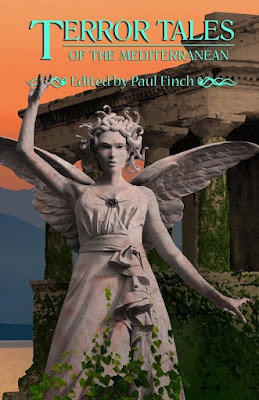 Today, I’m delighted to present you with details of this year’s volume in my folk horror-themed anthology series, TERROR TALES. In 2023, as you can see, it will be TERROR TALES OF THE MEDITERRANEAN, which, as of today, is available for pre-order right HERE.
Today, I’m delighted to present you with details of this year’s volume in my folk horror-themed anthology series, TERROR TALES. In 2023, as you can see, it will be TERROR TALES OF THE MEDITERRANEAN, which, as of today, is available for pre-order right HERE. This is always one of my favourite parts of the anthology-creation process, hitting you with Neil Williams’ amazing artwork and listing the stories, both fiction and non-fiction, that you’ll find inside, and of course, teasing you with a few brief snippets from some of the incredible tales that will be gracing the new book’s pages.
I’ve made no secret that this year, for the first time ever, we’d be venturing into countries outside the United Kingdom, a potential sign of things to come. But more about that later, along with lots more concerning the contents of this year’s volume.
When it comes to this week’s book review, alas, I’m unable to maintain synchronicity, as I haven’t got a Mediterranean-themed novel to hit you with. But, seeing that the TERROR TALES books primarily contain new horror stories of British origin, it’s probably (vaguely) thematic to pull in a British author who was very famous in his day for writing short, sharp shockers: Bernard Taylor. As such, I’ll also be offering a detailed review of Taylor’s recently republished 1980 horror novel, THE REAPING.
As usual, if you’re only here for the Taylor review, feel free to scurry on down to the bottom of his column, where you’ll find it in the Thrillers, Chillers section.
And now, today’s main event …

I reiterate that TERROR TALES OF THE MEDITERRANEAN can now be preordered HERE . It will only be published in the autumn, but if you want to reserve your copy for the very first day of its actual existence, why waste time?
If that doesn’t persuade you, here, for your delectation, is the back-cover blurb, followed by the full Table of Contents:
TERROR TALES OF THE MEDITERRANEAN
The Mediterranean. Sun-bleached ruins, azure seas, foaming wine. But history’s cruellest tyrants reigned here, delighting in blood and torture. Myths tell of snake-haired harridans and one-eyed giants, of humans cooked on spits, of curses, scourges, and devious deities who played with men’s souls like pawns in chess …
The poison apples of Aegle
The human sacrifice on Crete
The beautiful predator of Palermo
The damned souls on Poveglia
The evil artefact at Koyuluk
The blood-drinking baron of Emporda
The demon attack in Vatican City
Includes terrifying tales by Jasper Bark, Simon Clark, Steve Duffy, Paul Finch, Sean Hogan, Carly Holmes, David J Howe, Maxim Jakubowski, Gary McMahon, Mark Morris, Reggie Oliver, Peter Shilston, Don Tumasonis and Aliya Whiteley.
TABLE OF CONTENTS
The Catacomb by Peter Shilston
Duo of Darkness
On Our Way to the Shore by Maxim Jakubowski
Belmez
Meet in the Middle by Aliya Whiteley
Island of the Damned
The Lovers by Steve Duffy
When Madmen Ruled the Earth
The Wretched Thicket of Thorn by Don Tumasonis
The Blue Room
This Haunted Heaven by Reggie Oliver
Born of Blood and Mystery
The Quiet Woman by Sean Hogan
Holy Terrors
The Teeth of the Hesperides by Jasper Bark
Cyclops
Reign of Hell by Paul Finch
In Human Guise
Mistral by Mark Morris
Ghosts of Malta
Mammone by Carly Holmes
Extinctor Draconis
Vromolimni by David J Howe
The Other Devils
Gerassimos Flamotas: A Day in the Life by Simon Clark
Lord of the Undead
Should Not Be by Gary McMahon
And while we’re at it, why don’t I try and tempt you with some juicy snippets:
There was a girl-child whose clothing looked at least two hundred years old, but who from her skin and hair might just have fallen asleep; but beyond her a man in priestly robes had lost his nose and his cheeks, and his eyes had decayed to blank milky globules; and further on the soldier in the chased steel breastplate, who was perhaps a mercenary from the Renaissance period, had lost his flesh entirely, and now grinned mindlessly with a naked skull …
Peter Shilston – The Catacomb
The shirt ripped and the boy’s knees gave out, he crumpled, and the man still did not stop. He hunched over, arranged the boy, stretching out his arms and legs, then reached into the boy’s stomach. His hand was in the boy’s stomach, material was pulled out, something wet, it separated into strands. The man put the strands into his mouth and chewed, he put more into his mouth, he kept chewing …
Aliya Whiteley – Meet in the Middle
The water bulged. Something vast was coming up from deep below, and the sound was that of a wellington boot being slowly lifted from a pool of thick, gelatinous mud. The lake sloshed around the edges as the thing heaved itself out, and when it fell back, the water level dropped by at least a foot. Sally took a step back, her eyes not quite comprehending what was in front of her. It was dark and seemed to suck the light into it. The redness from the lowering sun cast shadows over the creature, and it glistened as the water fell from it in sheets …
David J Howe – Vromolimni
Why the Mediterranean?
I’ve already been asked that a couple of times, even though I haven’t talked a great deal about this anthology yet. It’s a very good question. After all, there are several locations in the British Isles that we haven’t yet visited, the South Coast being one, the Midlands, the Northeast, etc. Why are we suddenly venturing so much farther afield?
 Well, I’ve never made any pretence that
TERROR TALES
was first inspired by the Mary Danby-helmed
Tales of Terror
series, most frequently edited by R. Chetwynd-Hayes, which came out from Fontana Books in the 1970s. They followed a similar format to ours, but tended to cover broader regions than we do. However, they didn’t stop at the shores of Great Britain.
Tales of Terror from Outer Space
was a very popular title of theirs, along with
European Tales of Terror
and
Oriental Tales of Terror
.
Well, I’ve never made any pretence that
TERROR TALES
was first inspired by the Mary Danby-helmed
Tales of Terror
series, most frequently edited by R. Chetwynd-Hayes, which came out from Fontana Books in the 1970s. They followed a similar format to ours, but tended to cover broader regions than we do. However, they didn’t stop at the shores of Great Britain.
Tales of Terror from Outer Space
was a very popular title of theirs, along with
European Tales of Terror
and
Oriental Tales of Terror
. Now, I’m not following that series religiously. I’m not here to ape everything that Mary and Ron did, great ambassadors for British horror though they were, but if the TERROR TALES series is to have real longevity, it can’t just pour out spooky tales gleaned from a single country.
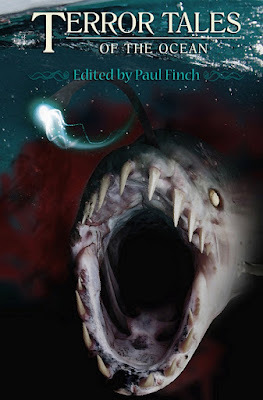 We’ve already branched out a little.
TERROR TALES OF THE SEASIDE
(2013), for example. Okay, it solely featured folklore and fiction from the British coastline, but it was all corners of the country, from Scotland to Kent, while
TERROR TALES OF THE OCEAN
(2015), which won considerable praise, ranged widely across the Seven Seas.
We’ve already branched out a little.
TERROR TALES OF THE SEASIDE
(2013), for example. Okay, it solely featured folklore and fiction from the British coastline, but it was all corners of the country, from Scotland to Kent, while
TERROR TALES OF THE OCEAN
(2015), which won considerable praise, ranged widely across the Seven Seas. But the truth is that, though I’m very keen to complete our own TERROR TALES tour of the United Kingdom, and will be doing exactly that, I’m now looking more and more overseas, taking regular deep dives into the mythic and folkloric culture of lands far away.
Of course, we can’t do every country on Earth. There are various reasons for this, not least that I only have time to edit one of these books per year, and so that would be an impossible target. But we can do regions, and TERROR TALES OF THE MEDITERRANEAN will be the first.
What may follow from that in the future is anyone’s guess, though I’m pretty sure I’ve stated in an earlier blogpost that some corners of the world, while they are rich in tales of mystery and magic, and are planted thick with homegrown authors, would be difficult territory for me to venture into. TERROR TALES OF THE CARIBBEAN, for example, would be a perfect fit for this series. What greater source for this kind of material could there be than the land of hoodoo. But the Caribbean has a wealthy literary tradition of its own and boasts numberless talented writers, many of whom are unknown to me. The same would apply, sadly to Central and South America, to those various regions of the United States, to the Far East, even to Ireland. All those titles would be well worth including in this series, but our readers would be much better served by editors homegrown in those lands, who wouldn’t miss a trick in pulling the absolute best scare fare they could from their native soil.
This applies less to regions like the MEDITERRANEAN , which so many of us are already very familiar with. So, while TERROR TALES OF THE MEDITERRANEAN is an exciting new venture, and there are others in a similar vein that we can do in the future, it’s not possible yet to put together a full list of prospects.
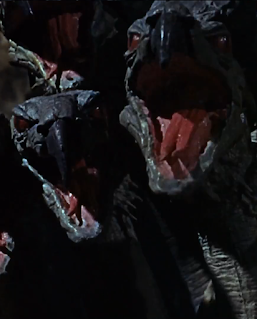 But never fear; there are lots – and I mean lots – of other subjects we can tackle: TEROR TALES OF MONSTERS … of the SUPERNATURAL … the OCCULT … the mind truly boggles.
But never fear; there are lots – and I mean lots – of other subjects we can tackle: TEROR TALES OF MONSTERS … of the SUPERNATURAL … the OCCULT … the mind truly boggles. Just keep watching this space. Who knows what we’ll hit you with next.
But for the meantime, one final reminder that TERROR TALES OF THE MEDITERRANEAN , which on its own will throw you in the path of numerous horrific entities, both real and imaginary, is out in the autumn, and ready to pre-order. Get it HERE .
THRILLERS, CHILLERS, SHOCKERS AND KILLERS …
An ongoing series of reviews of dark fiction (crime, thriller, horror and sci-fi) – both old and new – that I have recently read and enjoyed. I’ll endeavour to keep the SPOILERS to a minimum; there will certainly be no given-away denouements or exposed twists-in-the-tail, but by the definition of the word ‘review’, I’m going to be talking about these books in more than just thumbnail detail, extolling the aspects that I particularly enjoyed (I’ll outline the plot first, and follow it with my opinions) … so I guess if you’d rather not know anything at all about these pieces of work in advance of reading them yourself, then these particular posts will not be your thing.
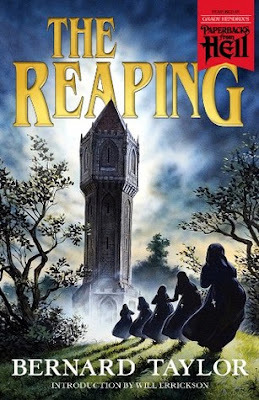 THE REAPING
by Bernard Taylor (1980)
THE REAPING
by Bernard Taylor (1980)
Outline
Family man, shopkeeper and wannabe artist, Tom Rigby, is your archetypal suburbanite. He’s suffered grievous losses in the past, his wife and several children having died in a terrible accident, but he is positive about life, he works hard and does what he can, mainly with the assistance of his caring older sister, Em, to look after his remaining brood, in particular his youngest son, Simion, with whom he is very close.
While, by his own admission, he is not exactly handsome, Rigby has a certain ‘everyman’ charm, which has attracted a new girlfriend, Ilona. She is younger than he is by several years and has a well-paid job as a makeup artist in the film industry. The downside of this is that Ilona is frequently away on location, meaning that she and her beau spend long periods apart, able only to communicate by letter. To cope with this, Rigby throws himself into his painting, which is not of such quality that it’s likely to make him a fortune, though at least it keeps him happy.
Then something happens that has the potential to change everything. After a local art exhibition in which his recent canvasses play a prominent role, Rigby is approached by a Mrs Weldon, a pleasant, efficient woman, who explains that she is housekeeper for a Miss Stewart, an elderly spinster who occupies a large country house down in Somerset, and who would like to hire an artist to paint a portrait of her niece, Catherine. Significant money is offered, but at first Rigby resists because he is planning to go on holiday with Ilona. Then, at the last minute, when Ilona has to cancel, work again getting in the way of their relationship, Rigby accepts the commission.
When he arrives at Woolvercombe House, where he expects to be spending the next few weeks, it isn’t an especially shabby place, but it isn’t modern, and there is an air of remoteness. Only a handful of staff keep things running: Miss Weldon herself, who retains an aura of firm control, a burly Cockney handyman, Hathaway, and a German-accented manservant and chauffeur called Karl, whose manner Rigby finds deferential but also strangely mocking. There is also Dr Macintosh, a Scottish-born medical practitioner, whose regular presence at the house is never really explained.
When he is introduced to Miss Stewart herself, who otherwise he is told he will rarely meet, she is extremely aged, a hunched, veiled and odorous figure, who occupies a shadow-filled garret in the upper echelons of the house. While Rigby doesn’t take an instant dislike to her, he doesn’t find her a warm presence. She is particularly dismissive of the job she has hired him to do, and speaks disparagingly of her niece, leaving him mystified about why he is being paid so much money.
More mysteries follow. When Rigby spies women in monastic robes and cowls walking in the manor house gardens, he is advised that they are novice nuns, who, by some agreement made in the distant past, are lodged at Woolvercombe in the days prior to their travelling out to the missions, though he likely won’t meet them. They never, for example, come into the main part of the building, not even to eat, as they have their own quarters and refectory, and are here basically to spend their time in contemplation. So, if the guest would oblige everyone by treating the nuns’ small corner of the property as private, all will be well.
Rigby has no intention of getting to know the nuns. As far as he’s concerned, he is here to do a job, one that he hopes will only last a couple of weeks, and when it’s done, he’ll take the money and cheerfully head back to Ilona. But Mrs Weldon, for one, appears surprised that he expects his time here to be short, and encourages him to take as long as he needs. Rigby still intends to get this over and done with, but then he meets Catherine, the niece, an ethereal beauty in her late twenties, who is quietly spoken and makes for enchanting company.
She sits for Rigby often, though not as often as he’d like. Several times, things happen – either she is unwell or has had a minor accident – to prevent her attending his studio, which threatens to extend his stay. At the same time, the manor’s other curiosities pile up.
One night Rigby hears female screaming somewhere on the property, which Mrs Weldon dismisses as unimportant. On another occasion, while walking in the grounds, he accidentally comes close to several of the young nuns and is astonished to hear most irreverent language. He also detects, in a very overgrown section of the estate, a mysterious stone tower, which stands to considerable height. Whether it’s a folly, or something of functional significance he can’t say, though it’s an extravagant item. On yet another occasion, probably more disturbingly than anything he has dealt with up to now, he must rebuff an unexpected homosexual advance from Karl.
However, things take a turn for the really strange, when, later that same night, he hears Catherine out on the darkened landing being menaced by Hathaway. On offering her sanctuary in his room, he is shocked to learn that the apelike handyman has been a continual threat to her all the time she’s been here. When he advises her to complain either to her aunt or Mrs Weldon, she explains that Hathaway has been employed at Woolvercombe a long time and so nothing will happen. In fact, she regards Rigby’s room as the only possible place of refuge, and as such, the inevitable happens. She falls into his arms and they become lovers.
Despite this pleasant interlude, Rigby still wants to leave Woolvercombe as soon as possible to resume his own life (suffering no inconvenient guilt about having several times bedded the innocent Catherine!), but his departure is repeatedly hampered.
First of all, there are the endless delays with the painting. Then, when it is almost complete, his car breaks down for no obvious reason, Hathaway explaining that he’ll need to send away for a new part. After that, as if the breakdown isn’t enough, Karl loses the car keys.
Rigby is furious, especially as there is so little he can do. Increasingly, it feels as though he isn’t going to be allowed to leave Woolvercombe House …
Review
Back in the 1970s and 1980s, Bernard Taylor earned himself a reputation as one of the quiet men of pulp fiction, a professional author of high talent who could turn his hand to almost anything – and indeed he did, his output ranging from horror to murder mystery to romance.
These days, it is probably his horror range that is best remembered. Even there though, Taylor was something of an enigma, specialising in creating contemporary tales that proceeded at their own pace, were subtle rather than gory, but were so intriguing that they’d draw you in anyway, often only hitting you with the horror element late in the day (and usually, they were all the more effective for that).
A master of the slow-burn then, Taylor became a household name among the horror aficionados of his era, though it’s probably true to say that, in terms of sales, he never really rose to the topmost rank. And if he ever did, he didn’t stay there for long, inevitably succumbing, as did so many others, to the downturn of interest in horror from mass-market publishers in the 1990s.
If for no other reason than this, it’s great to see this fine author being given a new lease of life by Valancourt Books who, yet again, are here unearthing for us another half-forgotten gem.
For all this, The Reaping is very much a book of its time. We are firmly in occult-related territory, the eerie presence of nuns, an unexplained building deep in overgrown woodland, the matriarchal nature of the Woolvercombe estate, and explicit sex, of which there is quite a bit, all hinting at devilry of the old school.
Does it all work?
Well, it’s an involving mystery, for sure. As per the author’s normal style, it doesn’t shower us with blood at every turn, or hit us with jump-scares and other fleeting terrors, but the more that is revealed about the increasingly macabre Woolvercombe House, the more we invest in it.
As we approach the grand finale, we find ourselves deeply engrossed in the story and very eager to know what kind of ritual nastiness lies at the heart of it. And you can’t ask for much more than that with a thriller.
If there’s any weakness with The Reaping , I think it lies with the main character, Tom Rigby. Yes, he’s an ordinary bloke, who has almost wandered into this tale of terror off the street, but there’s a degree of self-absorbtion that makes him a little unattractive, not to mention a tad unbelievable. A case in point is the moment when he queries the sounds of female distress that he’s heard late at night: evidently something unpleasant is happening, and yet he is very easily fobbed off. In addition, he becomes trapped at Woolvercombe House because he is told that his car has broken down … and because he doesn’t investigate it himself or attempt any repairs off his own bat.
These are minor quibbles, of course, but later on it gets a little more serious. When Rigby leaves the property having completed the painting, he is not impeded by anything as bothersome as feelings for Catherine, the vulnerable young woman he has been sleeping with, which feels like a glaring flaw in his character in 21st century eyes. More serious yet, potentially very serious actually, is his failure to contact the police when, quite late in the tale, it is reported that a girl he recognises as having been one of the nuns on the estate – a person he found very distressed at one point – has been discovered dead.
In fact, Rigby’s unwillingness to contact the police at any stage in this story did become quite irksome for me, because he isn’t at Woolvercombe long before he uncovers evidence of quite significant law-breaking. Again though, I suspect this owes more to the period in which the book was written rather than any kind of flaw in the narrative. The 1970s was not a decade in which personal responsibility was encouraged.
All that aside though, this is a neatly packaged little horror novel, with a very different (albeit in some ways, quite Gothic and traditional) concept at its heart, which, perhaps if the mechanics of it aren’t as fully explained as I would like, still leads us to a grotesque, visceral and very unexpected denouement. It also contains one slam-bang twist in the tail, which I for one never saw coming and which is almost worth the admission price on its own.
Check out The Reaping if you can. It’s a great example of the criminally underrated Bernard Taylor working at the peak of his powers, uninterested in the ‘one death every three or four pages’ thing that seems to be a requirement of much modern horror, hitting us instead with an effective slow-burn mystery-thriller that rises to a spectacularly chilling climax.
And now, as always, I shall endeavour to cast this tale in eager (maybe rather hopeful) anticipation of its adaptation for the screen. They wouldn’t come and ask me, obviously, but we can still have a bit of fun with it, can’t we:
Tom Rigby – Matthew Macfadyen
Catherine – Thomasin McKenzie
Ilona – Gemma Arterton
Mrs Weldon – Sophie Okonedo
Hathaway – Paul Anderson
Karl – Reece Shearsmith Dr Macintosh – Ken Stott
Published on August 03, 2023 04:05
July 17, 2023
Sun, sea, sex ... and horrors that defy myth

A bit of a taster blogpost today. A few thoughts in advance of any real announcements concerning TERROR TALES OF THE MEDITERRANEAN, which hopefully will be published by TELOS in the autumn. From my point of view, the book is almost now complete, so in this installment I thought I’d throw out some crumbs to whet your appetites.
The TERROR TALES books are for the most part folk horror anthologies, so I thought it would also be appropriate today if I offered a detailed review of a short novel that is often considered to be one of the quintessential forays into folk horror from that first wave of interest in the subgenre at the end of the 1960s: John Gordon’s THE HOUSE ON THE BRINK.
If you’re only here for the John Gordon review, that’s absolutely fine. Scroll down to the lower end of today’s blogpost and you’ll find it, as usual, in the Thrillers, Chillers section. Do it straight away. I won’t mind. On the other hand, you might first be interested in, especially as so many of you will likely be going here in the next few weeks …
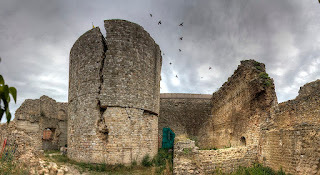 Terrors of
the Med
Terrors of
the Med
To quickly recap on the TERROR TALES anthology series, it’s mainly focussed to date on the British Isles. So, for example, we’ve had TERROR TALES OF THE COTSWOLDS , the WEST COUNTRY , the SCOTTISH LOWLANDS , CORNWALL , and so forth. There are 14 volumes in total to date, each one containing original horror fiction relevant to the geographic region, interspersed with snippets of real-life terror, folklore, mythology, unexplained mysteries and the like.
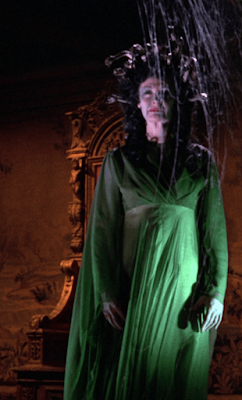 With TERROR TALES OF THE MEDITERRANEAN (check out the various pics scattered throughout this post to give clues about what’s coming - see how many you can identify), I’m obviously no longer just focussing on my British homeland, but starting to look a little farther afield. Hopefully readers will enjoy this one just as much as those that have gone before.
With TERROR TALES OF THE MEDITERRANEAN (check out the various pics scattered throughout this post to give clues about what’s coming - see how many you can identify), I’m obviously no longer just focussing on my British homeland, but starting to look a little farther afield. Hopefully readers will enjoy this one just as much as those that have gone before. I should hasten to point out that, even though for this 15th volume in the series I’ll be throwing my net over most of the Mediterranean Sea and its adjoining lands, I’ll purposely be ignoring the culturally very different region we call the ‘Middle East’ – Syria, Lebanon, Israel, Palestine, Libya, Egypt and so forth – but that’s only because they will hopefully be the subject of a book planned for later in the series called ‘Terror Tales of the Middle East’.
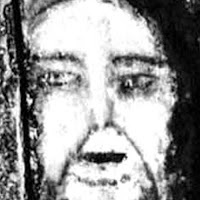 Even then, the Mediterranean will easily be the largest specific geographic region that we have covered in this series to date, comprising much of the south shore of Europe and the north shore of Africa. But it’s a region that is familiar to the majority of us, boasting a benign climate characterised by low rainfall, hot, dry summers and mild winters. As such, its lovely landscapes and flora are instantly recognisable: rocky hills covered in scrub and cacti, arid plains, rich pine and cedar forests, cypress trees, olive groves. ‘The Med’, as we call it, has become the go-to place for the traditional summer holiday, but you won’t need me to tell you there is so much more to this fabled realm than sun, sea and sex.
Even then, the Mediterranean will easily be the largest specific geographic region that we have covered in this series to date, comprising much of the south shore of Europe and the north shore of Africa. But it’s a region that is familiar to the majority of us, boasting a benign climate characterised by low rainfall, hot, dry summers and mild winters. As such, its lovely landscapes and flora are instantly recognisable: rocky hills covered in scrub and cacti, arid plains, rich pine and cedar forests, cypress trees, olive groves. ‘The Med’, as we call it, has become the go-to place for the traditional summer holiday, but you won’t need me to tell you there is so much more to this fabled realm than sun, sea and sex. Its esoteric history is beyond compare with almost anywhere else.
 It is commonly regarded as the Cradle of Western Civilisation. David Attenborough called it the ‘First Eden.’ Colossal empires have risen and fallen in this place. Epic wars have been waged. The most ancient cultures flourished here, leading to astonishing advances in human thought, language and artistry. Inevitably though, there is a darker side too.
It is commonly regarded as the Cradle of Western Civilisation. David Attenborough called it the ‘First Eden.’ Colossal empires have risen and fallen in this place. Epic wars have been waged. The most ancient cultures flourished here, leading to astonishing advances in human thought, language and artistry. Inevitably though, there is a darker side too.In the ancient Mediterranean past, fact is much interwoven with fiction, truth with mythology, a confusion of beliefs and certainties that has spawned some of mankind’s most terrifying tales, bequeathing us generations of monsters so unimaginably foul that it took the mightiest heroes to conquer them: everything from Talos to the Minotaur, from the sea-dragon, Cetus, to multi-limbed Geryon, one-eyed Polyphemus and Typhon, surely the most ferocious creature that ever stalked the Earth. The gods themselves were rarely better, unleashing curses and scourges on peoples they deemed to have failed them, sending earthquakes and typhoons to destroy entire cities.
Even lesser deities like nymphs and satyrs were maleficent, playing callous games with humanity, delighting in trickery and deceit, putting their own pleasure (and their lust) first.
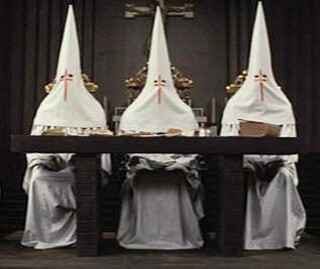 There’ve been dark times in real history too: nations enslaved, vast libraries torched, innocents thrown to lions, free-thinkers burned at the stake. Both politics and religion have led to astonishing acts of cruelty in the supposed name of progress. It is little wonder that so many of the Mediterranean’s grand but crumbling ruins echo to the savagery of the past and are now the haunt of tragic ghosts and spirits relentlessly re-enduring their torments.
There’ve been dark times in real history too: nations enslaved, vast libraries torched, innocents thrown to lions, free-thinkers burned at the stake. Both politics and religion have led to astonishing acts of cruelty in the supposed name of progress. It is little wonder that so many of the Mediterranean’s grand but crumbling ruins echo to the savagery of the past and are now the haunt of tragic ghosts and spirits relentlessly re-enduring their torments. Any potential readers new to the Terror Tales series should know that, as editor, I tend to favour supernatural horror, and by that I’m talking monsters, ghosts, faeries, demons, witches and all kinds of eerie and unexplained mysteries. Note, I’m NOT stating that this book will only contain fiction underpinned by folklore, mythology or the supernatural – there is as much terror to be found in tales of killers, maniacs and other manmade mayhem – just so long as you know beforehand that anything you encounter in TERROR TALES OF THE MEDITERRANEAN will be as scary and disturbing as possible.
And if you’re looking for specifics – table of contents, artwork, back cover blurb, pre-order details and the like – keep watching this space.
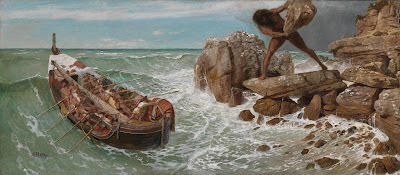
THRILLERS, CHILLERS, SHOCKERS AND KILLERS …
An ongoing series of reviews of dark fiction (crime, thriller, horror and sci-fi) – both old and new – that I have recently read and enjoyed. I’ll endeavour to keep the SPOILERS to a minimum; there will certainly be no given-away denouements or exposed twists-in-the-tail, but by the definition of the word ‘review’, I’m going to be talking about these books in more than just thumbnail detail, extolling the aspects that I particularly enjoyed (I’ll outline the plot first, and follow it with my opinions) … so I guess if you’d rather not know anything at all about these pieces of work in advance of reading them yourself, then these particular posts will not be your thing.
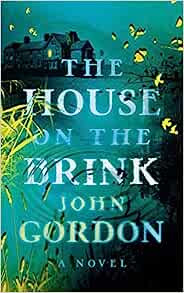 THE HOUSE ON THE BRINK
by John Gordon (1970)
THE HOUSE ON THE BRINK
by John Gordon (1970)
Outline
One early summer’s day on the edge of the Wash estuary, the tidal inlet where Norfolk meets Lincolnshire on England’s east coast, a man and a woman are traipsing through the fens when they spy something half-buried in the mud, which looks as though it might be a body. The man investigates and announces that it’s only a rotted old log. The woman is not placated; she feels certain there’s something evil about it.
A few days later, a reserved but smarter-than-average schoolkid, 16-year-old Dick Dodds, attends his Literature Class’s end-of-term party at the lonely riverside house of his wealthy widow teacher, the neurotic Mrs Knowles, who comments that she recently spotted a horrible human-shaped lump of wood on the edge of the fens and concludes that her house has two sides to it, a good side, from which she can often see the distant ‘silver fields,’ and a bad side, the side that faces onto the river, and the mud, where everything is ‘contaminated’.
These are strange comments, which no one present at the party knows how to take, though Mrs Knowles, who is now romantically involved with a local solicitor, Tom Miller, though only a few others are aware of this yet (and even fewer would approve, given that Knowles and Miller are polar opposites) has a reputation for being eccentric, and many put this down either to her unfortunate bereavement so early in life, or her isolated existence in the marsh-side house, or both.
Dick walks home after the party, somewhat cowed by the vast emptiness of the summer holidays stretching ahead of him. Wondering how he’s going to pass his time, he suddenly, in a characteristic impulse, helps himself to a moored rowing boat, and sets off for an impromptu trip down the darkened river. The folly of this quickly becomes apparent. Dick isn’t much of an oarsman, and in any case, he soon loses the oar, and finds himself drifting deep into the fens, beyond which lies only the open sea.
However, the following day, we learn that Dick survived his escapade. The tide pushed him ashore and he had to plough his way back through deep mud. He now returns with close friends, Jim and Pat, insisting that he needs to recover the abandoned boat, but at the same time, he recalls seeing something strange on his way back inland: an unnatural hollow on the water’s edge, almost as if something large had recently dug its way out, and then unidentifiable tracks trailing away through the mire. He says that when he tried to follow the trail, he felt inexplicably frightened. When he locates the trail again, neither Jim nor Pat see anything curious about it, but Dick still feels frightened and disoriented, putting on such a show that his friends decide he’s making it up and trying to scare them.
Dick goes back to the trail on his own later, following it across the marshy land until it passes close by a farmhouse, which he’s never visited before. While he’s there, a girl of his own age comes out, and tells him that her name is Helen.
They aren’t natural allies, Dick, who lives in the town and is firmly middle-class, Helen, who lives out here on the open country and whose father is a farm-labourer, but for some reason Dick confides in her, Helen, in return, admitting that, on the night of his river-adventure, she too saw something strange, the indistinct shape of a hideous limbless figure gliding along the trail.
Dick is inevitably drawn to Helen, and she to him, not just because they find each other attractive, but because both of them can sense the mysteriousness of the trail when apparently no one else can. The other kids still don’t know whether to take them seriously, but Pat suggests they go and speak to a certain Mrs Shepherd, a local water diviner, to see if she can cast light on the matter.
Mrs Shepherd, who is quite elderly and grandmotherly, confirms that both Dick and Helen are also water diviners, in other words they are sensitive to the presence of water sources below ground – which might, Dick supposes, explain their odd feelings when they are following the trail. However, for no obvious reason, the woman takes a seeming dislike to Dick, warning him not to take the path of other folk in the vicinity, who have used divination for the wrong purposes.
Feeling better now that they have a possible benign explanation for the trail, Dick and Helen relax a little, only to then speak with Mrs Knowles, who, as jumpy as ever, confesses that she fears a local legend about a walking corpse in the fens, the rotted remnant of a medieval warrior who was left behind to guard the site where King John famously lost his jewels in 1216, and was charged with killing anyone who attempts to rediscover them.
Though Dick and Helen now share a budding romance of their own, Dick, who is fond of Mrs Knowles (she was his favourite teacher, after all), is angry and suspects that her mental deterioration is being exacerbated by the presence in her life of Tom Miller, a shrewd but rather cold man whom the boy is convinced is wrong for her. As for her story about the body in the bog, well, Mrs Knowles is clearly going mad.
The boy doesn’t want any more to do with this, except that he feels drawn to investigate further, finally persuading Mrs Shepherd to talk some more. She admits to him that, whatever force lurks in the marshes, guarding the last resting place of the royal gold, there has never been any danger from it previously because the amateur treasure-seekers who hunt through the fens every weekend never get anywhere near. However, she – a genuine dowser – was recently paid by an influential local man to find it, and she got very close before deciding to back off, and it’s this, she fears, that has awakened the guardian of the trove. Mrs Shepherd won’t admit that the guardian is a millennium-old corpse preserved and in fact mummified in the fens, but she tells Dick firmly to stop looking into the case. She also names Tom Miller as her recent employer.
Despite this, Dick and Helen find themselves following the trail again, attempting to dowse with their own homemade rods. Nothing happens and they are ready to chuck it in, when they are led to a gate in a hedgerow out in the middle of nowhere. They’re about to go through but suddenly sense an unhealthy presence.
Any suspicion that this whole thing is down to their overactive imaginations leaves them at this point, when they spy something waiting in the gatepost greenery: ‘a black bald head, faceless’. And ‘a claw, lifted from the gate’.
It’s real after all, the thing from the mud …
Review
The House on the Brink started life as a YA novel, though interest in the book and the author has expanded far beyond those boundaries in the 50+ years since it was published.
At first glance, it certainly looks as though it belongs in that milieu. In fact, it almost seems to predate the YA era: a bunch of intrepid youngsters – the Famous Five or the Secret Seven – skirting around the edges of the ever-mystifying adult world while spending their school holidays investigating a seemingly supernatural mystery. But in truth there are all kinds of things going on in this novel that are nothing whatsoever to do with that, and which have guaranteed its lasting popularity among much older readers.
To start with, there is undeniably a vibe of MR James.
Montague Rhodes James wrote most of his now near-mythical short stories in the first three decades of the 20th century and focussed primarily on antiquarian scholars searching out age-old artefacts, subsequently triggering curses or awakening terrifying revenants. He is still regarded as one of the world’s foremost ghost story writers, and massively well-read even today, thanks partly to his witty, lyrical and succinct style, but also for his ability to evoke a genuine atmosphere of dread.
The House on the Brink is cut from similar cloth, not just in terms of its subject-matter, but in its style, which is very quick and to-the-point, with scarcely a word wasted, and its setting: the bleak eastern edge of England, an empty, sea-begirt landscape, where the wind sighs constantly through the reeds, and forgotten ruins stand lonesome on the distant mudflats. It’s a richly atmospheric location, and dare I say it, John Gordon works it as effectively as Dr James used to, taking his characters, some of whom live in the town, far out of the normal world into a silent wilderness of wildwood, grassland and black, rippling waterways.
The scene at the gate – ‘a gateway to nowhere,’ as the author himself says (gates, edges and brinks being at least as important in this book as they are in MR James) is particularly frightening, coming upon us unexpectedly and yet written in such concise, matter-of-fact fashion, again as Dr James so often did, that mundane normality and supernatural horror are blended together with shocking effectiveness.
Another reason why The House on the Brink is a must-read today, despite being half a century old (and this may be one of the reasons why Valancourt have brought it back, though whatever the actual reason, I’m glad they have), is our recently rekindled interest in folk horror.
Superficially, there is lots of evidence that The House on the Brink was written at the end of the 1960s. The kids are as inquisitive as their predecessors, yet a tad more streetwise. At the same time, though, they are still polite to adults (imagine that!). They do lots of old-fashioned things, like have picnics and ramble around the countryside on pushbikes. They feel bad when they do the wrong thing, rather than object to being reprimanded for it. One of the girls in the group, Pat, still wears a skirt. Jim, the team joker, given to ribbing Dick at every opportunity, does so in a fashion that is almost genteel. But 1970, when this book first hit the shelves, was also the height of the Age of Aquarius. The counterculture of the ’60s was fading fast, but a desire for unorthodox spirituality remained, and with this came a wave of interest in folk horror. You’ll remember the movies of that era, Blood on Satan’s Claw (1971) and The Wicker Man (1973). TV shows like Robin Redbreast (1970), Penda’s Fen (1974) and Children of the Stones (1976). Even Dr Who got in on the act with The Daemons (1971). Then there were public safety films like Lonely Water (1973), some of which took place in those spooky locations where town met country, where children were suddenly beyond adult supervision, where threats to life and limb often took the form of grim entities.
But this genre was also a celebration of Britain’s landscape and its forgotten cultures and beliefs, the relics of which were scattered across the deceptively tranquil georama of British folklore, and that’s particularly the case in this novel.
I’ve already mentioned the gate to nowhere, the mysterious trail or ‘track,’ as John Gordon calls it, which ostensibly is the route taken by the mummified single remnant of King John’s army, though it’s not actually visible, and may indeed be an ancient route traversed by many strange energies, a ley line or whatever. Then there are the ‘silver fields’ as referred to by the disturbed Mrs Knowles; when Dick finally travels out to them, they are little more than a floodplain lying ankle-deep in seawater and thus reflecting the sky, but in Mrs Knowles’s mind, what we’re really talking about here is a near-but-distant magical realm, occasionally visible but always unreachable (Faerie Land, if you like). Mrs Knowles’s weather-beaten house serves a similar purpose. To the calculating Tom Miller, it’s nothing more than a refuge for his troubled sweetheart and also, probably, a key part of the lucrative future he plans for himself, but to Mrs Knowles it’s a border stronghold, the first (and last) human habitation before the vast sweep of the unknown.
But perhaps the most obviously grown-up part of The House on the Brink is the coming-of-age story.
So many horror and fantasy writers over the decades have trodden this path, reliving their own experience of the transition from childhood through the prism of the scary story, their adolescent unease about the years ahead dressed up as monsters or demons. This is very much the case in The House on the Brink .
Dick Dodds is 16, and in 1970 that meant that his next step was adulthood. Few people then had time for kids who didn’t really know what they wanted, or who were looking for ‘a year out’ or who just wanted to keep on being students. But because attitudes were different, that didn’t mean it was easier for the youngsters. There are times when Dick feels lost in the mysterious emptiness of the landscape, even though he has grown up here. Is this a metaphor for the uncertainties ahead? It’s the same with his and Helen’s relationship. They are still too young to be proper boyfriend and girlfriend … so much so that they’re embarrassed to admit this is what they are, and don’t like it when adults make that assumption. They kiss but there’s not much amorousness there. They’re stuck at that midway stage, on the edge-land. It’s no wonder everything is confusing, particularly the behaviour of the adults in the book, who they no longer view as distant, omnipotent controllers of all their lives, but as near-equals, flawed and troubled themselves, yet whose moods and motivations they still can’t read properly.
All that said, I don’t want to make The House on the Brink sound as if it’s heavyweight stuff. It actually isn’t. At heart, it’s a gentle if very eerie, but also rather straightforward ghost story. It also only runs to 161 pages, so it’s an easy and accessible read. And yet it’s successful at every level. It has well earned its reputation as a classic slice of supernatural nostalgia, which will frighten and delight in equal measure.
And now, for once, I’m not going to bother trying to cast this beast in the event it ever gets adapted for film or TV. This one is all about the young leads, which means it would need genuine teenage actors, and I don’t know enough about the younger end of the current acting market to offer any kind of valid opinion.
Published on July 17, 2023 01:13
June 23, 2023
Key moments that steered me into writing

I hope you can forgive me a few personal moments this week. For some time now, I’ve been pondering an occasional series of articles about those events in my life, those key moments, that steered me towards the writing profession. I held back for a little while. Would it be too personal, too introspective? Or would it be interesting? Well, you guys can judge, because I’m taking a chance and getting that ball rolling today.
In addition, I’m taking this opportunity to remind everyone that about my upcoming two-hander event with my fellow thriller-writer MW Craven in the very near future (it’s only 11 days away, in fact), in Cumbria. So, I’ll be chatting at little about that too.
On which subject, and on a not unrelated note, today would also seem an opportune time to offer a detailed review of Mr Craven’s latest masterwork, FEARLESS, an all-out action thriller set out in the sun-blistered wastes of the Chihuahuan Desert (so, a particularly good one to read this flaming June).
If you’re only here for the Craven review, I’ve no problem with that. You’ll find it as usual in the Thrillers, Chillers section at the lower end of today’s column. Before then, here’s the other stuff ...
Meeting our public
A quick reminder that on Tuesday July 4, MW Craven and I will be chatting to our public in the Kendal branch of Waterstones, and event running 6.30 to 9pm. Mike will be talking about FEARLESS , his explosive new action thriller, and very likely the commencement of a brand-new series, while I, briefly, am veering away from the world of guns, armed robbers and terrorists, to discuss USURPER , my most recent novel, which is also an action adventure, but this one set 1,000 years ago at the height of the Norman Conquest of England.
The overlap is the full-blooded action, folks. Don’t be fooled into thinking that these two books are a mismatch. All that really matters, though, is that we’ll both be there to chat and answer questions about our methods and motivations, any plans we may have for the future and so on, and to sign every book that are put in front of us, not just the new ones. (I also hear that anyone there who buys both books will receive a £5 discount on the total cost!)
Here’s a shot from last year’s event, when Mike was presenting THE BOTANIST and I was presenting NEVER SEEN AGAIN . You’ll notice that my dogs, Buck and Buddy, also got in on the act.

Anyway, Feel free to pop along to the next one, folks. Get your tickets HERE . I guarantee a fun evening.
And now, something else that yet again is not entirely unrelated ...
MOMENTS THAT MATTERED
What on earth is it that could make you want to be a writer?
I suppose on one hand, you could argue that the most basic requirement is to be pompous enough to believe yourself so important that others will pay to read your words.
To be honest, that’s pretty undeniable.
But on the other hand, joining the writing profession is also quite a laudable act.
 Firstly, because it means you’re seeking to share wisdom, learning, expertise and even personal interest in a manner that you hope will entertain and inform others. Secondly, because you attach such value to this prospective profession that you are prepared to put in the hard yards, in exchange for rewards which, at best, can be variable and uncertain, and at worst, non-existent. In other words, you’re undertaking a vocation that you really believe in – and that’s surely a good thing, but the fact that you’re doing something ‘good’ may be the best you ever get out of it.
Firstly, because it means you’re seeking to share wisdom, learning, expertise and even personal interest in a manner that you hope will entertain and inform others. Secondly, because you attach such value to this prospective profession that you are prepared to put in the hard yards, in exchange for rewards which, at best, can be variable and uncertain, and at worst, non-existent. In other words, you’re undertaking a vocation that you really believe in – and that’s surely a good thing, but the fact that you’re doing something ‘good’ may be the best you ever get out of it. But of all the writers I’ve met during my life, I can’t name one who ever told me that he or she came into this world with this ambition already hardwired into them. So many, if not all, seem to have muddled their way into the profession.
Even those among us who toyed with the idea of becoming writers when we were young often had other careers to take care of first. Some of these we might have enjoyed a great deal. Others we merely tolerated because we had to get the money in. Either way, they filled our time and thoughts.
 But every one of us, I’m certain, has also experienced ‘Damascene moments,’ in other words has suddenly been struck by an astonishing revelation or motivation that we never saw coming, and which, while it might not have jolted us into the world of authorship at that very moment, became a persuasive factor as we continued forward in life.
But every one of us, I’m certain, has also experienced ‘Damascene moments,’ in other words has suddenly been struck by an astonishing revelation or motivation that we never saw coming, and which, while it might not have jolted us into the world of authorship at that very moment, became a persuasive factor as we continued forward in life.Was the spur in fact, that would drive us on towards a very different future.
So … I thought it might be fun over this blogpost and several in the future, to highlight a few of these seminal moments in my own life when the die was indisputably cast, when I realised that there was something vastly more satisfying I could be engaged in.
Now before we start, what I am NOT talking about here is the actual, physical moment when I moved into full-time writing. In my case that was something beyond my control. It involved a series of unexpected redundancies, which, ultimately, though none were welcome at the time, removed that very difficult decision about whether or not to pack my day job in. But that’s not a particularly exciting story. The moments I’m looking for in this new occasional series are those instances of divine inspiration. Those moments when your vision clears, everything falls into place, and your reason for existing in this world is suddenly made very plain to you …
SPUR #1 – GRANADA TELEVISION

One of my greatest inspirations, and I’m aware that I’ll need to explain this, was Granada Television.
My father, Brian Finch, was a screenwriter with a career that spanned four decades, his CV ultimately containing a wealth of successful programmes: Coronation Street , The Tomorrow People , Captain Scarlet , Murphy’s Mob , Bergerac , Hunter’s Walk , Public Eye , All Creatures Great and Small , among many others, culminating of course in the BAFTA he won in 1999 for Goodnight Mister Tom .
Yet, this wasn’t the whole story.
As I grew up in Wigan in the 1960s and early 1970s, my father was a local news reporter and a wannabe writer who was still jobbing his talents around. The earnings weren’t particularly great, of course.
Though I’ve undoubtedly led a mostly middle-class existence, we were a working-class family by origin, my two grandfathers a coal miner and a gasworks foreman. I myself spent my formative years living in a terraced house. I only mention this to show that, as a youngster, I had a very conventional experience of the industrial northern town that was Wigan.
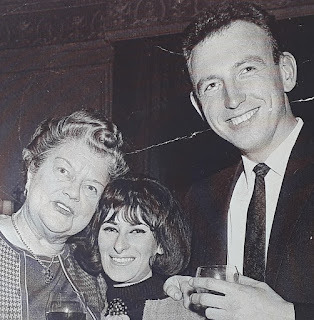 And yet, somehow, as we progressed into and through the 1970s, my father’s writing career blossomed, and more and more celebrities came in and out of our lives. (The image right shows my Dad at a
Coronation Street
party with Violet Carson, aka Ena Sharples, some time circa 1969/1970).
And yet, somehow, as we progressed into and through the 1970s, my father’s writing career blossomed, and more and more celebrities came in and out of our lives. (The image right shows my Dad at a
Coronation Street
party with Violet Carson, aka Ena Sharples, some time circa 1969/1970).I honestly could spin a hundred anecdotes relating to this.
For example, when the phone rang one evening and my mother answered, a boomy and distinctive voice asked: ‘Is Brian there?” When my mother replied, “I’ll just get him for you, Frankie,” the voice said, “How did you know it was me, dear?” My mum: “There’s only one Frankie Howerd.” The voice: “Ooooo!”
Then, there was the script-meeting in our front room for my Dad’s Rugby League drama, Fallen Hero , where the ever-lovely Wanda Ventham (Benedict Cumberbatch’s mum), had to eat some of the most appalling looking cheese sandwiches, which my Dad had just made, and did so without complaint because they’d been working all day and were starving.
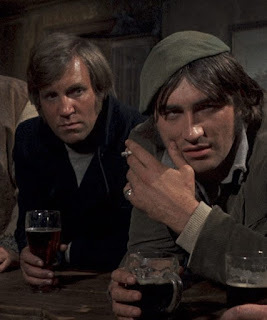 In a similar, informal way, my Dad introduced me to Del Henney and Ken Hutchison, two screen hardmen so convincing in those roles that you’ll probably remember them playing the two lead villains in the movie thriller,
Straw Dogs
, but a couple of actors who were also so versatile that they’d play good guys in my Dad’s dramas.
In a similar, informal way, my Dad introduced me to Del Henney and Ken Hutchison, two screen hardmen so convincing in those roles that you’ll probably remember them playing the two lead villains in the movie thriller,
Straw Dogs
, but a couple of actors who were also so versatile that they’d play good guys in my Dad’s dramas.I could go on and on about this, but it would get boring.
The point is that it was all so gradual a process that I wasn’t aware of it being anything unusual. If my Dad casually mentioned that he’d just been speaking on the phone for half an hour to Boris Karloff, it meant nothing to me. These were the sorts of people my Dad knew.
Which brings us back to Granada Television, the home of Coronation Street , and umpteen other shows my Dad worked on.
Granada TV was the brainchild of media mogul, Sidney Bernstein, and one of the original four independent television franchises created in 1954. It covered Manchester, Lancashire, Merseyside, Cumbria, Cheshire, North Wales and parts of Yorkshire, and was praised by TV critics for the distinctively northern and ‘socially realistic’ nature of its programming.
My Dad considered it the thumping heart of independent television in that era. I visited the studio with him again and again over many years, to drop scripts off, to watch the filming of Sherlock Holmes (and get to shake hands with Jeremy Brett), or to stand quietly by while he discussed potential new children’s shows with such diverse TV personalities as Ken Dodd and Charlie Caroli.
When it came to widespread family entertainment, Granada TV was unbeatable. And yet, it never felt like a privilege being there and interacting with those who were integral to it.
Until the early 1980s, when I left civilian life and joined the Greater Manchester Police.
You may wonder, given the background I’ve just outlined, what the hell possessed me.
 Well, ever since I was a lad, I’d always wanted to be a copper. Even though I’d been a dab hand at writing stories while at school, in my early adulthood I had no interest in that. I wanted to go out and lock up villains. Even when I was being interviewed for the job at Chester House, the chief superintendent on the other side of the desk said something to the effect of: ‘Your father’s a well-known television writer. Do you not want to do the same thing?’
Well, ever since I was a lad, I’d always wanted to be a copper. Even though I’d been a dab hand at writing stories while at school, in my early adulthood I had no interest in that. I wanted to go out and lock up villains. Even when I was being interviewed for the job at Chester House, the chief superintendent on the other side of the desk said something to the effect of: ‘Your father’s a well-known television writer. Do you not want to do the same thing?’ I gave what a thought was a very honest answer, perhaps riskily honest. I said: ‘I may do at some point, but I’ve no interest in that yet.’
To which he smiled and said: ’Well, if nothing else, we’ll certainly give you lots of grist for that mill.’ (And how prophetic that turned out to be).
But the yearning to write didn’t come yet. In many ways, the job completely absorbed me, left its mark even when I was off-duty. You worked long and difficult hours, were in constant high stress situations, and spent almost every shift dealing with people who were having the worst day of their lives. The difference between dreaming about the police and policing for real is an abyssal gulf.
Some of it was terrifically exciting, but some of it was more than a little bit depressing.
For example, when you went into rooms, often in the most desolate parts of town, that you would never forget as long as you lived ... rooms you would keep on revisiting in your dreams.
On one such occasion, after I’d discharged all my duties as a first responder, I remember stomping up the stairs to the roof of the high rise in question, and gazing bleary-eyed across the silent, benighted cityscapes of Salford and Manchester, finally focussing on that distant neon sign, shimmering cherry-red: GRANADA TV.
A rush of happy memories came back to me. For half a second, at that terrible time in that terrible place, I was relocated back to my early life, when I’d been surrounded by these stars of stage and screen without really knowing it, when I’d been immersed in that atmosphere of entertainment and creativity, which I’d so taken for granted at the time.
I knew there and then that I didn’t just want to go back to that world, I had to.
That was where I belonged. Not this one, as personified by that room downstairs, now in a state of chaos, the world and his brother having arrived (all too late, of course, as we nearly always were).
I’m not sure why my ambition suddenly came alive at that moment. I’d seen the Granada TV sign many times during my police service and thought nothing of it. Yes, I had vague memories of those heady days, but always considered them the distant past, a fantasy childhood that could never have meaning for me long-term. And yet somehow, that night, that sign became the most potent lure.
I signed off at the end of that shift with one objective in mind. I was leaving the cops, and by hook or by crook, I was going to worm my way into my Dad’s world … or something close to it.
(To be continued ...)
THRILLERS, CHILLERS, SHOCKERS AND KILLERS …
An ongoing series of reviews of dark fiction (crime, thriller, horror and sci-fi) – both old and new – that I have recently read and enjoyed. I’ll endeavour to keep the SPOILERS to a minimum; there will certainly be no given-away denouements or exposed twists-in-the-tail, but by the definition of the word ‘review’, I’m going to be talking about these books in more than just thumbnail detail, extolling the aspects that I particularly enjoyed (I’ll outline the plot first, and follow it with my opinions) … so I guess if you’d rather not know anything at all about these pieces of work in advance of reading them yourself, then these particular posts will not be your thing.
 FEARLESS
by MW Craven (2023)
FEARLESS
by MW Craven (2023)
Outline
Ben Koenig is a US Marshall with the Special Operations Group. Or rather, he was. At present, he’s dropped off the grid. Six years ago, he shot dead a suspect while closing in with his team on an isolated ranch where a particularly loathsome bunch of deviants were making ‘toddler versus attack dog’ movies. The deceased suspect happened to be the son of a leading member of the Russian Mafia. The Russian mob themselves were not involved in the vile racket, in fact they deplored it, but rules are rules, and as such, Koenig was marked for death.
He’s been on the run and lying low ever since.
We join the narrative with Koenig in Wayne County, New York, where, as usual, he is minding his own business. Until he is bewildered to learn from watching TV in a bar that he has made the US Marshals’ ‘Most Wanted’ list.
Even Koenig, skilled as he is, finds it difficult to disappear again when his face is suddenly on every TV screen, and he is subsequently arrested by local cops. However, this is only a ruse. In reality, US Marshals Service director, Mitch Burridge desperately needs to make contact with him. They are old mates who go way back, and Mitch would normally respect Koenig’s desire to stay out of sight, but a very serious situation has now arisen.
In short, Mitch’s pre-grad daughter, Martha, has been abducted. Inevitably, a range of security services are already on the case, but Mitch wants Koenig involved too. Not just because he’s a human bloodhound – the Devil’s Bloodhound, as some crims have come to refer to him – but because at present he’s an unofficial asset. He’s also an apex predator. If Martha Burridge is dead, as her father fears, he wants Koenig to kill those responsible.
Koenig is certainly ideal for this kind of work. Earlier in his career, a raid went south, and he was shot in the head. He survived it, but during the subsequent operation, the brain surgeon discovered that he was suffering a rare degenerative condition called Urbach-Wiethe disease, which normally causes an abnormal fear of just about everything, though in some cases, exactly the opposite can result: the patient finds that they have no fear of anything at all.
In Koenig’s case it’s the latter, which officially at least meant that further service in the field would be problematic. A man without fear could pose a high risk, not just to himself, but to his colleagues. Not wishing to lose a talented operator like Koenig to permanent deskwork, the Service responded by sending him off to train with some of the world’s most elite spec ops, the SAS, the Navy SEALS and so on, where he would compensate for his lack of fear by learning how to make professional judgements based on knowledge and acquired skill. It also meant that, when he finally got back in the field, he was by far the deadliest man in the US Marshals.
Living up to this reputation, Koenig guarantees Mitch that he will find Martha, or discover what happened to her, and will do whatever it takes to make this happen.
The first part of Koenig’s investigation takes him to DC, and Georgetown Uni, where Martha was studying. Her academic supervisor, Robin Marston, is a Marxist professor who regards it as his civic duty to impede law enforcement wherever he can. Koenig has no time for this, and gets rough with Marston, leading the frightened academic to admit that he hasn’t given all of Martha’s files to the Washington PD. However, before Marston can retrieve the info he has held back, he is shot and killed by an unknown female assassin, who takes out a campus cop at the same time.
Perhaps inevitably, Koenig, who’s already knocked Marston around, is blamed, and finds himself back in custody, in a local holding cell. While he’s in there, on suspicion that he’s just another crazy shooter, two white supremacist hoodlums are put in with him, clearly under orders to finish him off. The resulting fight is violent, but it leaves one of the neo-Nazis dead and the other badly injured. Frustrated, the cops look to charge Koenig with murder anyway, only for one of their senior ranks to engineer his escape from the precinct.
Increasingly suspecting that this whole thing is a set-up, and that somehow or other, there is official involvement in the kidnapping of Martha Burridge, Koenig has no choice but to accept the cops’ escape route. At which point he is confronted by an old colleague of his, Jen Draper, a top agent who also happens to hate him. Unsure what to make of this, Koenig stumbles to a halt.
Draper meanwhile, raises her pistol. And fires …
Review
In my opinion, the acid test for any thriller is whether or not it thrills. Does it intrigue you? Does it excite you? Does it keep you hooked? It’s not a genre for which great writing and unforgettable characters are often considered essential ingredients, which makes MW Craven’s work all the more impressive. Because if there is one thing Mike Craven is, it’s a hell of a writer across the board.
First of all, let’s deal with the thriller aspects of Fearless , because they are here in abundance.
A few reviewers have suggested that Ben Koenig will be the new Jack Reacher. At first glance there are undeniable similarities. Like Reacher, Koenig is a drifter out there in the vastness of the US. Also like Reacher, he has a law-enforcement background but is also highly trained in the skills of violence. In addition, though he’s as rough and ready as they come on the outside, he also has a deep moral sense and innate hostility to those who do wrong, at whatever level of society they predate on the innocent. And again, pretty much like Jack Reacher, he encounters these warped individuals plenty often during his ramblings.
But here, to be honest, the similarity ends.
Koenig is not a physical giant who can knock six guys out with a single punch. By the same token, he is still, officially at least, a cop rather than a vigilante, and the investigations he often undertakes are official, albeit the legalities are clouded by the sort of uncertainties that only black ops can generate. (All this said, it would be remiss of me not to mention the amusing moment in the novel, when Mitch Burridge remonstrates with Koenig for going ‘all Jack Reacher’ on them).
If anything, for me, there are probably more links between Ben Koenig and one of Craven’s parallel characters, Washington Poe. At first glance, you might disagree. Poe, you’d rightly argue is a regular police officer based in the north of England, and he is governed by the numerous controls that prevent British cops using extreme methods. But Poe, who also has a military background, resents that. He can function inside the framework, but he doesn’t like it. He’ll readily strongarm villains if it’s required, because he sympathises with the law-abiding public ahead of them. On top of that, he’s an arch-cynic, and displays this attitude with just about everyone, friend and foe alike, and definitely to his superiors. In all these ways, and others, he is similar to Koenig, though Koenig, by the nature of who he is and what he does, and because he has almost no limits imposed on him in his efforts to secure justice, is the next stage along in terms of ferocity.
Koenig also has the fearlessness factor, which is an ingenious way of explaining the recklessness he displays in his pursuit of the novel’s antagonists (and also a good way for the author to make him seem unreliable to his superiors without calling his abilities into question).
If I was to liken Ben Koenig to any other action hero currently bestriding the genre, it would be Robert McCall, as interpreted by Denzel Washington in The Equalizer franchise, because Koenig, while he often keeps tight control of himself, is guaranteed bad news for the opposition in that he’s ruthless and vengeful, and when he tells a bad guy that he’s going to kill him, you know that it’s no idle threat. But also, and this is the most intriguing aspect of Ben Koenig, because he is so amazingly disciplined and methodical.
Because this novel is written in the first person, it’s full of fascinating thought processes, as Koenig makes highly professional assessments of each and every predicament, reminding us constantly about the psychology of the opposition, about the potential of different weapons, about the advantages and disadvantages posed by each new location, about the best vehicles to use, about the distances he’ll need to travel, and the speed he’ll need to travel at, in order to disarm, cripple or kill an opponent, even about the different means available to him, sometimes which he must go out of his way to acquire, to foil sophisticated alarm systems or fox professional security staff.
There is a plethora of such info in Fearless , but at no stage is it intrusive. For me, it illuminates the book, first of all because it assures the reader that our main protagonist is a real professional who knows exactly what he’s doing, and secondly because it offers a full and convincing explanation for why our main hero wins such regular and improbable victories. It absolutely is NOT the case, as we were so used to in Schwarzenegger and Stallone movies, that Koenig just turns up at the crucial moment, often having blundered his way there, and takes out every bad guy either because he has a bigger gun than they do or because they’re just rank poor shots.
And yet this explanatory undertone is all done so succinctly and so interestingly that you can’t help but be seduced by it. And that brings me onto the quality of the writing itself.
Whether he’s describing tense one-to-ones between vividly drawn and distinctive characters (all multi-levelled, not all of them even remotely likeable), whether it’s atmospheric description of the unforgiving badlands or, yes, those frequent, bone-crunching action sequences, Craven hits the mark each time. He’s a wordsmith of high technical skill. He can paint pretty pictures, but he keeps then tight and ultra-believable, and he knows how to let the narrative flow. It’s superb writing all-round, and it totally merits that overly-used honour ‘unputdownable’.
More than likely, you’ll already know what you’re going to get with Fearless , but I’d just reiterate that this is one serious cut above the rest of the action-thriller genre. It’s high-quality work, and all built around an intriguing new character, who frankly, has got film and/or TV written all over him.
And now, here I go with my usual ill-advised attempt to cast this beast before the real film and TV people get their grubby mitts on it. It’s only a laugh, but hell, someone’s got to do it.
Ben Koenig – Sebastian Stan
Jen Draper – Emily Blunt
Mitch Burridge – Forest Whitaker
Peyton North – Scott Adkins
Samuel – John David Washington
Published on June 23, 2023 03:03
May 20, 2023
Gloating over a lavish Terror Tales review
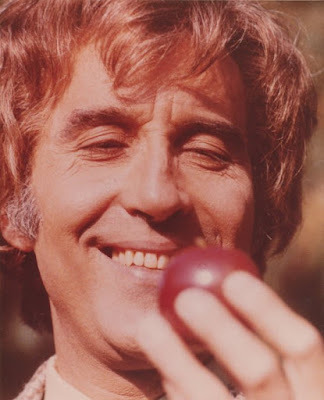 Today, I thought it would be nice to share a really cool review of TERROR TALES OF THE WEST COUNTRY courtesy of Rosemary Pardoe, editor of GHOST AND SCHOLARS, and one of Britain’s most respected and well-informed experts on the traditional ghost story.
Today, I thought it would be nice to share a really cool review of TERROR TALES OF THE WEST COUNTRY courtesy of Rosemary Pardoe, editor of GHOST AND SCHOLARS, and one of Britain’s most respected and well-informed experts on the traditional ghost story. Also, in the spirit of TERROR TALES OF THE WEST COUNTRY, I’ll be running a gallery of folk horror on film, but specifically picking movies that are perhaps less well known or less associated with that genre.
While we’re on the subject of rural horror, I’ll also be offering a detailed review of the late Michael McDowell’s 1979 classic, THE AMULET.
If you’re only here for the McDowell review, that’s A-okay as always. Just hop straight down to the Thrillers, Chillers section of today’s blogpost, and you’ll find it there.
Before then, however, let’s get back into the world of …
Terror Tales
TERROR TALES OF THE WEST COUNTRY is the 14th in the TERROR TALES series. For anyone who hasn’t encountered these books yet, they are a series of folklore-based horror anthologies, each one set in a different geographic region. They comprise both fiction (mostly original and from some of the best ghost and horror writers in the field) and snippet-length ‘true terror’ anecdotes.
TERROR TALES OF THE WEST COUNTRY kind of speaks for itself. It’s all about England’s mystical West Country. I don’t think I need to say too much more about that. Anyway, the amazing Ro Pardoe of GHOSTS & SCHOLARS fame has finally cast her discerning eye over it, and on the whole seems to approve. I hope she won’t mind if I include a few quotes from her, as we work through her various high points.
 Ro heaped praise on the ‘incredibly impressive’ line-up and, in no particular order of preference, singled out a number of specific stories for praise, including Dan Coxon’s
The Darkness Below
, which she likens to Ramsey Campbell at his best, and summarises as ‘when a family visits Gough’s Cave at Cheddar Gorge, are they the same people who come out, and if not, which of them has changed?’ She also mentions Lisa Tuttle’s
Objects in Dreams May Be Closer Than They Appear
, which she calls ‘a fine tale of nightmarish time entrapments, and a Devon house visible on Google Satellite View which is almost impossible to find on the ground (it would have been better for the narrator if it had been completely impossible to find).’
Ro heaped praise on the ‘incredibly impressive’ line-up and, in no particular order of preference, singled out a number of specific stories for praise, including Dan Coxon’s
The Darkness Below
, which she likens to Ramsey Campbell at his best, and summarises as ‘when a family visits Gough’s Cave at Cheddar Gorge, are they the same people who come out, and if not, which of them has changed?’ She also mentions Lisa Tuttle’s
Objects in Dreams May Be Closer Than They Appear
, which she calls ‘a fine tale of nightmarish time entrapments, and a Devon house visible on Google Satellite View which is almost impossible to find on the ground (it would have been better for the narrator if it had been completely impossible to find).’ Inevitably, Ro, an expert on MR James, is exceedingly fond of the volume’s antiquarian stories. Of John Linwood Grant’s The Woden Jug , she writes ‘in Somerset, an apparent stoneware witch-bottle, decorated with a one-eyed face, turns out to be a protection not against witches but against something else entirely’, and calls it ‘a good one’. Ro wastes few words when she likes something, so this is praise indeed.
Another antiquarian tale she enjoyed was Stephen Volk’s Unrecovered , which she says stands out in the volume, adding ‘it begins in familiar territory, with the archaeological excavation of a Wiltshire Anglo-Saxon cemetery, and the sighting of a distant figure with only half a head … but the horror is of a more recent war and the trauma of losing a buddy on the battlefield. I can’t deny that I shed a tear’.
There are three main Dartmoor-set stories in the anthology, an ancient landscape that has proved a happy hunting ground for horror writers going way back, and Ro seems to have particularly enjoyed these. She was pleased that in Thana Niveau’s Epiphyte , ‘the supernatural threat takes an unusual form’, and says of Adrian Cole’s Land of Thunder that ‘a horrific episode in the history of Dartmoor jail produces revenants raised by a much older force on the moor’. But above all, the story she considers the best in the book, is Steve Duffy’s Certain Death for a Known Person . Those who don’t know Steve Duffy’s work need to rectify that, as he’s an author of exceptional skill. Of his story here, Ro writes, ‘I don’t know many authors who could turn what is essentially a Twilight Zone -type plot about Death personified, and an agonising choice that needs to be made into something as introspective and deep’.
As for own contribution, Bullbeggar Walk , which is ‘set on Exmoor, where a church’s stained glass window provides a vivid depiction of the legendary Bullbeggar, a monster created through a disagreement between an Anglo-Saxon and a Norman in the 11the century,’ Ro describes it as ‘effective’.
Well … I told you that she doesn’t waste words.
Secretly, I’m most pleased that Ro likes and appreciates that time that has gone into my own creation of the anecdotal ‘true’ stories that intersperse the works of fiction. These are great fun but time-consuming to research and write. For the most part, reviewers seem to appreciate them, but Ro says of them that they ‘are among the highlights of the book’.
Anyway, the overall review is far more extensive than I’ve quoted here. If you want to read it in full, you’ll need to get hold of Ghosts & Scholars 44 . However, I’d like to thank Rosemary for taking the time and trouble to offer her opinions and provide us with what amounts to a detailed, fulsome and very warm-hearted review of the latest book in the series.
On the subject of TERROR TALES , a few quick words now about the next one in the series, which will be TERROR TALES OF THE MEDITERRANEAN. You may consider that an unusual break-away from our more normal British-set volumes, and it probably is, but I’d draw your attention to the fact that we did TERROR TALES OF THE OCEAN in 2015, which obviously wasn’t British-bound, and maybe was a sign of things to come. After all, in the next two or three years, we’ll have run out of locations in mainland Britain. We opted to visit the Med this time around, with one or two UK locations still remaining, just to freshen things up a little and to check out the lie of the and where our readers are concerned.
I beg no one to entertain even the remotest possibility that this location might not ‘do it for them’ in horror terms. Already, and the book is nowhere near ready yet, we’ve found some visceral terror in the secretive halls of Turin’s satanist university, in the Spanish/Pyrenean castle where a decadent and brutal vampire lurked, and among the mist-shrouded origins of some of that ancient region’s most terrifying monsters … among many others.
And now, just for the hell of it, let’s check out a gallery of …
Lesser known folk horror
While we’re on the subject of folk horror, and also because I love this stuff so much, here’s a fun list. Folk horror(ish) movies you might not have heard of but ought to watch at least once. The first rule I’m imposing is that none of these films have got status as classics of folk horror, so that means no The Wicker Man , no Blood on Satan’s Claw , no Witchfinder General , no Midsommar , no The Witch . Second rule, none of these are British in origin, as it’s surely about time we looked beyond the borders of folk horror’s traditional home, which means no Kill List , no Night of the Eagle and no A Field in England .
With luck, that doesn’t mean that you won’t enjoy it. So, in the order of their production, let’s get cracking.
HAXAN (1922)

Dramatised but scholarly narrative, following the emergence of witchcraft as a potent force, from the early days of village ritual to the publication of Malleus Maleficarum and the violence of the Inquisition. Ben Christensen writes, directs and stars in this hotchpotch of pagan / Satanic / psychological horror, which was highly controversial for its depictions of nudity and torture.
CITY OF THE DEAD (1960)
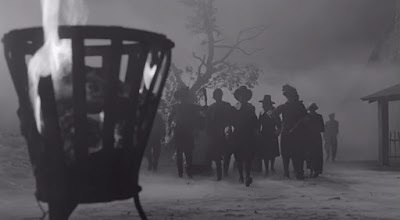
The search for a missing student leads two guys through mist-shrouded Massachusetts to the eerily olde worlde village of Whitewood. At first glance, a traditional witchcraft chiller, but with lots of neat folky touches: the Hour of Thirteen, the silent dancers etc. An early pre-Amicus effort for Milton Subotsky, with Chris Lee nailing himself down as horror’s primary villain.
THE HAUNTED PALACE (1963)

Newly married heir to a fortune, Charles Dexter Ward returns home to New England, to find deformed villagers everywhere, and his mansion-like residence the centre of cult bent on summoning ancient powers to create an evil super race. HP Lovecraft gets in on the folk-horror act, Corman directs, Vincent Price and Lon Chaney Junior star. What more could you want?
KWAIDAN (1964)

Horror abounds in this early, excellent portmanteau of Japanese folk tales, all adapted from the works of Lafcadio Hearn, including terrifying stories like Black Hair (which became go-to Japanese horror) and Woman of the Snow . Masaki Kobayashi directs while Yoko Mizuki scripts, the pair managing what had previously been thought impossible: bringing Japanese mysticism to western audiences.
DARK NIGHT OF THE SCARECROW (1981)
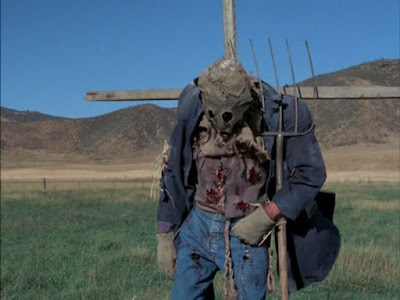
When a mentally ill man is lynched for a crime he didn’t commit, the country boys responsible seek to cover their tracks, but a mysterious scarecrow undertakes to kill them all. Not as gory as you’d expect, though there are some imaginative farm-tool related deaths, while at times it’s also rather sad. Veteran horror writer, Frank de Felitta, directed it for TV, which may explain its lack of fame in modern times.
SOMETHING WICKED THIS WAY COMES (1983)
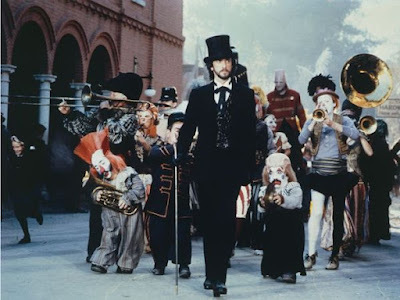
In rural Illinois, two kids are captivated by the arrival in town of Mr Dark’s mysterious and grotesque carnival, gradually deducing that these aren’t normal entertainers, they’re actually the much-feared ‘Autumn People’. Ray Bradbury’s revered slice of fantastical Americana doesn’t translate ideally to the big screen – he and direct Jack Clayton fell out a lot – but you can rarely go wrong with Mr. Bradbury.
ANGEL HEART (1987)

A war-scarred PI pursues a missing singer around Harlem, a trail that finally leads down south into a world of hellish hoodoo. William Hjortsberg’s Gothic noir gets the Alan Parker treatment, Parker purposely taking it out of New York and into the Bayou, the resulting film so risque in parts that it got into a big wrangle with the censors. De Niro and Rourke add serious quality.
PUMPKINHEAD (1988)
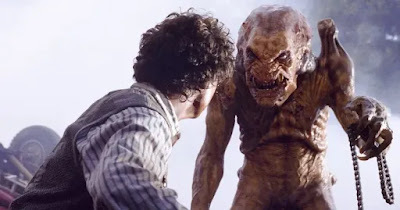
When dirt-bikers run down a small child, the bereaved father begs a woodland witch for vengeance, and a horrific creature is raised from the pumpkin patch. Special effects whizz Stan Winston finally got into the director’s chair for this low budget but hugely effective adaptation of Ed Justin’s poem. Lance Henrikson brings complexity, the monster brings genuine terror.
THE MEDIUM (2021)
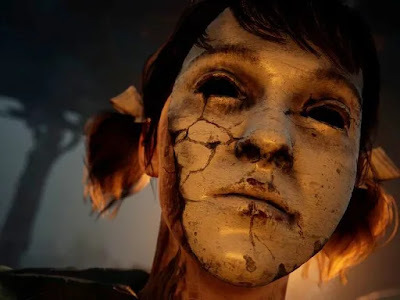
A Thai film crew heads way inland to interview Nim, a village matriach who claims to have been possessed by the spirit of Ba Yan, a goddess of the old religion. Director Banjong Pisanthanakun creates an atmosphere of visceral dread in this fast-moving found footage study of the old meeting the new, and all set against a tropical backdrop rich in folklore and superstition.
MOLOCH (2022)
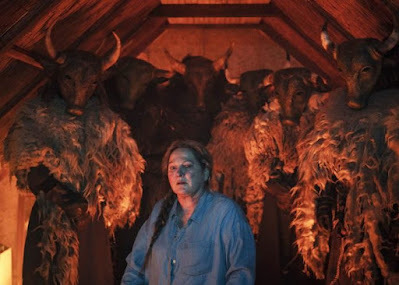
A Dutch woman, traumatised as a child by a violent attack on her family, now lives a secluded life on the edge of marshland in the middle of nowhere. However, as an archaeological team start uncovering bog bodies, clues suggests than an ancient cult is still active. A tad slow, but esoterica mingles with bleakness in a typical Euro-horror outing. Nico van den Brink directs his own script with a sure hand.
THRILLERS, CHILLERS, SHOCKERS AND KILLERS …
An ongoing series of reviews of dark fiction (crime, thriller, horror and sci-fi) – both old and new – that I have recently read and enjoyed. I’ll endeavour to keep the SPOILERS to a minimum; there will certainly be no given-away denouements or exposed twists-in-the-tail, but by the definition of the word ‘review’, I’m going to be talking about these books in more than just thumbnail detail, extolling the aspects that I particularly enjoyed (I’ll outline the plot first, and follow it with my opinions) … so I guess if you’d rather not know anything at all about these pieces of work in advance of reading them yourself, then these particular posts will not be your thing.
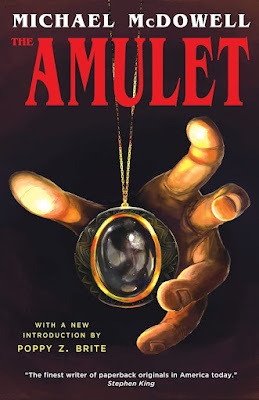 THE AMULET
by Michael McDowell (1979)
THE AMULET
by Michael McDowell (1979)
Outline
Pine Cone, Alabama, the mid-1960s.
It’s the heartland of the rural South, but the Vietnam War has reached its tentacles even into this sleepy backwater. Local boy, Dean Howell, gets his call-up papers, but before he can ship out to Nam, he suffers a critical injury on the range, when a rifle, made in the munitions factory at Pine Cone no less, blows up in his face. A blinded, zombified mute, he is honourably discharged and sent home to become the problem of his hardworking but very tired wife, Sarah, and his middle-aged mother Jo, who is not just lazy, obese and relentlessly vicious-tongued, but who harbours grudges against almost everyone she knows, usually for the most imaginary of slights.
Sarah’s constant exhaustion is due partly to her astonishing workload at the factory, where she functions on one of the actual conveyor belts along which travel the same rifles that injured her husband, but mainly because when she gets home she becomes Jo’s personal skivvy as well as the main carer for Dean. Becca Blair, her slightly older friend and neighbour, constantly harries her to stand up for herself, to make Jo share in the chores, but Sarah is a passive sort, who gets through either by trying to persuade herself that this is her lot in life, or alternatively, by grabbing a couple of moments’ rest here and there and simply not thinking about it.
Then, something shocking happens.
Larry, one of the supervisors at the munitions plant, and an old friend of Dean’s, comes to visit, and is genuinely and visibly shaken to see the paralysed, bandage-wrapped condition of the young ex-soldier. Even then, Jo Howell doesn’t have much time for Larry, but rather to Sarah’s surprise, she gives him a present for his wife, an exotic looking medallion, or amulet, hanging from a gold chain. No real explanation is offered and Larry doesn’t quite know what to make of it, but to avoid being rude, he takes the gift home and presents it to his wife, Rachel.
Later that evening, having tried the amulet on and found that it suits her, Rachel poisons Larry and then sets the house on fire while her children are in bed. All of them die in the subsequent inferno, Rachel included.
The whole town is appalled by what seems to have been an atrocious accident, with the exception of Jo Howell, who, from what Sarah can see, is smugly satisfied.
Jo, it seems, continues to blame everyone in the town for her unhappy life, and the state of her son. She particularly blamed Larry for the latter because she believed he was in a position to make Dean an essential worker and therefore remove him from any danger of being drafted. Sarah is hardly surprised by such mean-spiritedness. In truth, she reviles Jo, only staying with her out of her sense of duty as a wife and daughter-in-law. But worse horrors are now to be visited on Pine Cone.
Within a day or so, a cop assessing the ruins of the burned-down house comes into possession of the amulet, passing it on to his own wife. That same night, she too turns homicidal, puncturing his brain by stabbing him through the ear with an ice pick, before falling on broken glass and dying herself from a severed jugular.
A terrifying, self-repeating pattern appears to have been set in motion, the amulet finding its way from one new owner to the next, every new owner then committing brutal murders before dying, him or herself, through some incredibly unlikely accident, each one seemingly more gruesome than the last.
Increasingly certain that it’s something to do with the amulet, Sarah confronts Jo, only to be told that it came from a catalogue and doesn’t have any kind of power. In fact, the idea seems so ridiculous, even to Sarah, that she hesitates to mention it to Becca, though the ongoing succession of horrific deaths – a farmer whose skull is crushed by a tree branch wielded like a club, a farmer’s wife hurled off a bridge into a rushing river, another farmer’s wife trampled and savaged by a formerly placid but now insanely out-of-control mother-pig – gradually persuades her.
Even Becca, who is superstitious to her bones, struggles to buy into the theory that the amulet is causing these acts of murderous rage, until the two of them hold a séance together and are delivered some frightening if non-specific messages.
But who will believe them?
The amulet, meanwhile, continues to make its round of Pine Cone’s citizens, usually in secret as everyone seems to get hold of it in some kind of underhand fashion, in which case the first the rest of the community hears about it is when the owner’s loved ones have been slain, they themselves following shortly afterwards.
At this rate, Sarah thinks, unless she can do something soon, the whole town is likely to perish …
Review
Michael McDowell was a sadly short-lived American horror author, though in the time he was active, from 1979, when he had his first novel published, this one in fact, The Amulet , until his premature death in 1999 at the age of 49, he was very prolific.
Whatever his long-term plans were, this debut novel of his, reissued in 2013 in a very neat new package by Valancourt Books, originally came about in unusual if macabre circumstances, when McDowell and a friend got together and to amuse themselves, tried to pass the time creating as many gory deaths as they could think of derived from everyday appliances. The two of them clearly had ghoulish and vivid imaginations, because they came up with a heck of a lot. On top of those previously mentioned, you can also add decapitation by ceiling fan, mangling by hay-baler and the almost unbearably horrible laundering of a young baby in a washing machine, with many others to follow.
I’m not sure at which point McDowell decided there was a novel in this (or even a screenplay, as that is the form in which The Amulet was first written), but despite the incredibly lurid sounding material that he’d given himself to work with, once he’d actually started writing, he quickly pushed it beyond the norms of routine horror, the story taking us deep into the heart of his native southland, evoking a distinct air of the Southern Gothic.
Many aspects of life in that world are touched upon convincingly. It’s the mid-1960s and the Civil Rights Movement is in progress, but Alabama is resisting, and folks down there still lead segregated lives. The whites themselves are not vastly happier than their black ‘across the river’ neighbours, having hot summers and barren winters to deal with, living in poor-quality housing and engaged in mind-numbing but physically demanding work. The pleasures these people enjoy, of both races, are few and far between: the occasional bit of hunting or fishing, but mostly, and quite briefly, sitting on rockers on their creaky old porches, grumbling about so-called friends and neighbours, while knowing nothing about the rest of the world and caring even less.
It’s all very atmospheric, and a cut above most horror-writing of that era. All that said, whether the book can really be classified as a great horror novel, I’m not so sure. Valancourt have certainly done the reading world a favour in bringing it back to the light, for it has huge merits, but the mysterious amulet is never really explained (unless you assume that it’s some hoodoo-type transmitter for Jo Howell’s inherent vindictiveness, though that is never stated), while the narrative overall is a bit predictable and in the end becomes quite repetitive.
I don’t often say this about classily written books – because The Amulet is expertly and even beautifully written, often avoiding outright gratuitousness (apart from in the finale, which is a Carrie -esque explosion of grisliness) – but even though it’s less than 300 pages long, I felt a vague sense of relief as the end approached, simply because, well-staged and imaginatively gory though they are, I didn’t think I could sit through yet another elaborate death scene.
It holds together well enough. The dialogue crackles with believability (McDowell had a real ear for his own people), while the characters are vivid, the villains in particular – as evil and horrific hags go, Jo Howell will take some beating – while the sense of time and place, as I say, is immaculate. But all this really does, if I’m bluntly honest, is ensure that the procession of grotesque murders is all nicely packaged.
It’s a book worth reading, though. It will keep you entertained, and it’s a great glimpse into the early career of a very fine author, who would go on to do much better things later, but was taken from us all too soon.
And now, my usual high-risk addendum of who should play what if this property ever hits the screen. Only a bit of fun, of course, though you never know: Michael McDowell first wrote The Amulet as a drama after all. Here would be my current choices (price-tag no object, of course):
Sarah Howell – Erin Moriarty
Jo Howell – Conchata Ferrell
Becca Blair – Elizabeth Olsen
Sheriff Garret – Steve Buscemi
Published on May 20, 2023 15:36
April 26, 2023
It's always a battle, but our books make it

I’m delighted to announce that today, my novel, USURPER, is published in paperback, on Kindle and on Audible. I’ve done a lot of talking about this over the last few weeks, and I’ve probably bored people to death with the endless numbers of excerpts and snippets that I’ve been posting on Twitter and Facebook, so today I’m going to let the book itself do most of the talking.
I’ll say one or two minor things, and then I’ll be posting a short video of me reading what I hope is a brief but juicy extract from the book (yeah, you’ll be getting the glory of me in person as well), so you can actually hear how it sounds and won’t just have to take my word for it.
There’s other book news to share today too, and that will move us away from the historical adventure milieu where USURPER dwells, back into the realm of suspense/horror, which I know is close to the hearts of a lot of people who check in here. That also means it’s okay for me to review another dark thriller this week, which I will be doing, though this one has got a bit of history (of a sort) attached to it as well (see what I did there?).
It’s THE GIRLS by Emma Cline, a very compelling study of a murderous cult. It’s a work of grim fiction but based closely on infamous real-life incidents.
If you’re only here for the Cline chat, that’s fine as always. Just nip straight down to the lower end of today’s column, the Thrillers, Chillers section, where all my book reviews dwell.
In the meantime though, if you want to hear USURPER , read by moi, let’s roll with …
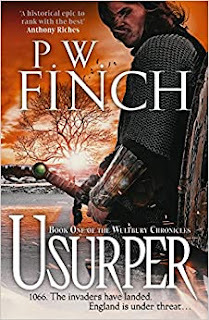 A dark and terrible past
A dark and terrible past
I’m obviously chuffed to bits that USURPER is hitting the bookshelves today. As I’ve already said, you can get it either in paperback, Kindle or on Audible. I’m not going to say much more than that, though, because it’s time to let the book speak for itself. I’ll just quickly reiterate that it’s my first ever historical novel that doesn’t feature fantasy elements (it does feature horror, though it’s horror of the human variety rather than anything supernatural).
It’s set during the autumn of 1066, at the commencement of the Norman Conquest of England, and tells the story of Cerdic, a young Saxon noble, who loses everything during the firestorm that soon engulfs his country, including his home and family. Left lost and wandering in a once-happy, prosperous realm, which has now been reduced to a corpse-strewn wilderness, he must somehow find it inside himself to win back his birthright. But he’s had no training for that. He was destined for the Church rather than warriorhood. He hasn’t even got a sword.
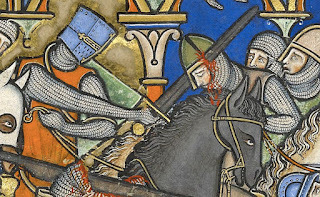 All he possesses is his will to survive, and to succeed, and he’s going to need both of these, because the alternative is a quick death courtesy of foreign steel, or the lingering torture of enslavement, starvation, mutilation, maybe even castration. With slaughters and massacres at every turn, there’s no hope of reversing this terrible tide of history, but Cerdic is determined that he won’t be a victim of it. He’s going to live, and reclaim what once was his, and if a further lake of blood must be shed in the process, he’s adamant that his own won’t be mingled with it.
All he possesses is his will to survive, and to succeed, and he’s going to need both of these, because the alternative is a quick death courtesy of foreign steel, or the lingering torture of enslavement, starvation, mutilation, maybe even castration. With slaughters and massacres at every turn, there’s no hope of reversing this terrible tide of history, but Cerdic is determined that he won’t be a victim of it. He’s going to live, and reclaim what once was his, and if a further lake of blood must be shed in the process, he’s adamant that his own won’t be mingled with it.As a footnote to this tale, you might be interested to know, especially if you live in the Lake District area, that I’ll be discussing USURPER with top crime novelist M.W. Craven at Waterstones, Kendal, on the evening of July 4.
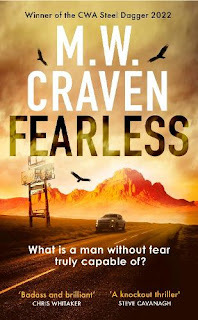 Mike will be presenting his new action thriller,
FEARLESS
, so we’ll have plenty to talk about and lots of blood and thunder notes to compare. The previous event Mike and I did together was a sell-out, so, if you’re interested, my advice is to get your tickets early. Get more info
HERE
(or pop into the store itself and enquire at the counter).
Mike will be presenting his new action thriller,
FEARLESS
, so we’ll have plenty to talk about and lots of blood and thunder notes to compare. The previous event Mike and I did together was a sell-out, so, if you’re interested, my advice is to get your tickets early. Get more info
HERE
(or pop into the store itself and enquire at the counter). When fiction becomes myth
Here’s the other book stuff I promised to chat about today.
We all of us dream that there’s a place, somewhere out there, just out of sight, where, if we could only reach it, all our problems would be solved, and all our worries would whisper away like summer mist. It’s so close that we can smell it. But we just can’t get to it, and we know to our deep sadness and regret that we likely never will, not in this life.
Call it Heaven, call it Eden, call it the Blue Remembered Hills … or call it Neverland.
 Because that is the theme, at least of my story, in the imminent new Titan anthology, edited by Marie O’Regan and Paul Kane,
THE OTHER SIDE OF NEVER
. I may have mentioned this in previous blogposts, but at last I can give a little more detail, as the editors have finally, officially released the Table of Contents. As you may have guessed,
THE OTHER SIDE OF NEVER
is a collection of short stories based on or drawing inspiration from the adventures of JM Barrie’s Peter Pan.
Because that is the theme, at least of my story, in the imminent new Titan anthology, edited by Marie O’Regan and Paul Kane,
THE OTHER SIDE OF NEVER
. I may have mentioned this in previous blogposts, but at last I can give a little more detail, as the editors have finally, officially released the Table of Contents. As you may have guessed,
THE OTHER SIDE OF NEVER
is a collection of short stories based on or drawing inspiration from the adventures of JM Barrie’s Peter Pan. All the tales are new and exclusively fantastical and/or horrific and/or thrilling in nature (yep, I told you we were back into the world of dark fiction with this one). Here, for your delectation, is the full list of contributors.
Foreword by Jen Williams
A Visit to Kensington Gardens by Lavie Tidhar
Manic Pixie Girl by AC Wise
Fear of the Pan-Child by Robert Shearman
And On ’til Morning by Laura Mauro
The Other Side of Never by Edward Cox
The Lost Boys Monologues by Kirsty Logan
A School for Peters by Claire North
Chasing Shadows by Cavan Scott
Saturday Morning by Anna Smith Spark
The Land Between Her Eyelashes by Rio Youers
Boy by Guy Adams
Never Was Born His Equal by Premee Mohamed
The Shadow Stitcher by AK Benedict
A House the Size of Me by Alison Littlewood
Silver Hook by Gama Ray Martinez
The Reeds Remember by Juliet Marillier
No Such Place by Paul Finch
Far From Home by Muriel Gray
I’m sure you’ll agree that there are some very august names on there. All these years on, I never take it for granted, appearing in rollcalls of this magnitude. I obviously can’t talk about any of the other stories, not having read the book yet, but my own tale, No Such Place , is set in the smoggy ruins of post-war London, and follows the fortunes of a veteran-turned-murder detective, who finds himself on the trail of a very real group of lost boys.
And that’s all I’m going to say about it, except to add that THE OTHER SIDE OF NEVER is published on May 9. Ah yes, it’s only two weeks before you can go and grab it off a bookshelf somewhere (or alternatively, get your pre-orders in right now).
See you soon.
THRILLERS, CHILLERS, SHOCKERS AND KILLERS …
An ongoing series of reviews of dark fiction (crime, thriller, horror and sci-fi) – both old and new – that I have recently read and enjoyed. I’ll endeavour to keep the SPOILERS to a minimum; there will certainly be no given-away denouements or exposed twists-in-the-tail, but by the definition of the word ‘review’, I’m going to be talking about these books in more than just thumbnail detail, extolling the aspects that I particularly enjoyed (I’ll outline the plot first, and follow it with my opinions) … so I guess if you’d rather not know anything at all about these pieces of work in advance of reading them yourself, then these particular posts will not be your thing.
 THE GIRLS
by Emma Cline (2016)
THE GIRLS
by Emma Cline (2016)
Outline
Evie Boyd is an uninspired and uninspiring California woman, middle-aged and drifting between jobs and relationships. While house-sitting for a friend, Dan, she meets his teenage son, Julian, who prides himself on being a drugs courier for local dealers, and his sad, rather needy girlfriend, Sasha.
When Julian remembers that Evie was once part of a notorious hippie cult, whose crimes made national headlines, we are projected back to the summer of 1969, when Evie was only 14 and already something of a lost soul.
The summer vacation has just started, and Evie doesn’t know how she’s going to get through it, especially as she is bound for boarding school when it’s over. Her home life, while wealthy (her late grandma a former Hollywood actress), is unsatisfying, while her parents, who are newly separated, rarely connect with her on an emotional level. Evie is aware that social change is going on elsewhere, but as a young teen has no real interest in any of that. In fact, her mother’s many New Age interests, all very expensive of course, evoke pity in her rather than enthusiasm, because she views them as pointless middle-class fads. As such, she hangs around a lot with her friend, Connie, a typical soon-to-be high school kid, who is mainly interested in gossip magazines and beauty products, and moons after Connie’s older brother, Pete, who already has a girlfriend, the gorgeous Pamela.
Thoroughly bored and annoyed at the way Pete is nice to her because he thinks her a kid, Evie is then fascinated to spot some ragged teenage girls behaving recklessly in the town centre, dumpster-diving for food and exposing their breasts for their own amusement. A black-haired girl in particular, the seeming leader of the group, really catches her eye. A short time later, after Evie and Connie fall out, Pete having left home with the pregnant Pamela, and Connie, somewhat irrationally, blaming her friend, Evie meets the black-haired girl again, and this time buys some toilet paper for her after she is caught trying to shoplift.
The girl, who’s called Suzanne and drives around with the others in a scruffy black bus, enters the narrative a second time after Evie, having fallen out with her mother, rides off on her bike and gets marooned when the chain breaks. This time, Suzanne takes her back to ‘the ranch’ where she and the others, having rejected the phoniness of ordinary life, live in a hippie commune. In truth, the place is a filthy hole, rubbish everywhere, the children unwashed brats, every possession looking as if it was scavenged or stolen. However, the girls, Suzanne included, are captivated by their leader and guru, a wandering musician called Russell Hadrick, who seems to have mesmerising powers of persuasion and espouses numerous revolutionary philosophies. Evie isn’t quite so enthralled by him, especially as almost the first thing he has her do is give him oral sex, but Suzanne is, and Evie is strongly attracted to Suzanne, so she joins the group as a kind of associate member.
She visits regularly throughout the summer, always telling her mother that she’s staying with Connie, and gradually getting to know other members, the oafish Donna, the pretty Helen. Russell remains a mystery to her – he has immense charisma, that is certain, and he can make damaged people feel good about themselves, and more importantly, wanted – but she doesn’t really care about Russell as long as she can be close to Suzanne.
There are many warning signs: the group talks a lot about love, but gets about by using multiple stolen credit cards; there is rampant drug abuse; the children in the commune are being raised in conditions of dirt and neglect; while the girls are all expected to provide either sex, or a waitressing/cleaning service for Russell, his brawny henchman, Guy, the occasional bikers who roll in, and Mitch Lewis, a successful guitarist and singer so besotted by the ‘California myth’ of freedom and irresponsibility that he too has been seduced by the group’s lifestyle. Evie sees all these problems for what they are but ignores them because this unconventional world is different from anything she’s been used to and because, if nothing else, she gets a feeling of belonging here. She even steals money from her own mother to provide for the group’s needs.
Only on one occasion does Evie get physical with Suzanne, and this occurs when Russell, trying to persuade Mitch to secure him a record deal, ‘rewards’ the guy by sending Suzanne and Evie back with him to his expansive seafront property. They indulge in a threesome, which Evie doesn’t enjoy especially, though mainly because of Mitch, who’s pleasant enough but a total stoner. A short time later, still ready to do anything Suzanne asks of her, the two of them break into Evie’s mum’s neighbours house, but Evie is spotted and recognised.
Sent to live with her father as punishment, Evie makes friends with Tamar, his much-younger girlfriend, but eventually realises that Tamar is interested only in getting what she can from her wealthy lover, and so hitchhikes back to the ranch. A nerdy guy from Berkeley, called Tom, drives her the last part of the way, but is appalled at the state of the place and the people who live there, and asks her to come away with him. Evie refuses but recognises that there is now a bad atmosphere in the group. It seems that Mitch has told Russell once and for all that the record company won’t take him on as an artist, and has cut ties. Russell, furious, has been harassing him and talks of nothing but revenge.
That very night, it seems, Suzanne, who still idolises Russell, is setting out with some of the others on a mission, the purpose of which she won’t divulge. When Evie begs to come along, Suzanne reluctantly agrees, but tells her to ‘wear dark clothes’ …
Review
The Charles Manson story has been done to death, but never quite like this. Because this is the version that looks at it from the perspective of his acolytes, or at least from one of them, an adolescent girl coming of age in a tumultuous era, though not really aware of that as the struggle to make the shift from infancy to adulthood is overwhelming enough.
Obviously, in The Girls , we are not talking about the Manson Family per se. But rather, a very similar group of mostly female hippie cultists centred around a highly manipulative male leader, and the path they eventually take, which leads to a horrific mass-murder.
With hindsight, we all know what an imposter Charles Manson was. An intelligent but hardened criminal, he had great powers of persuasion and control, and when he came out of prison in 1967, after serving half his 32 years behind bars, and found himself in California in the Age of Aquarius, it was like unleashing a fox into the henhouse. Within a year, he’d recruited a band of willing followers, many of them young women with emotional difficulties or lost and confused by the rapidly changing times.
Delighted by the ‘free love, free drugs, free everything’ mantra of the hippie movement, Manson, fully adopted the guise of the counterculture and created a commune based on principles of equality, sharing and love. He wasn’t the only one to do that, of course. On every streetcorner in San Francisco’s Haight-Ashbury there were spaced-out people with flowers in their hair, strumming guitars tunelessly and singing strange songs. The difference was that in Manson’s case, it was a façade from behind which his female acolytes could prostitute themselves, prowl for new recruits, deal drugs, steal, and provide him and his friends with sex on demand. Above all though, the group’s main objective was to secure for their sage, who at heart was a frustrated musician, a lucrative record deal. When that failed, Manson’s coked-out buddy, Dennis Wilson of the Beach Boys, having provided no assistance, the cult leader’s true nature burst through … and the infamous Tate-LaBianca murders were the outcome.
As I say, we are not in this exact territory, but we are very close, Emma Cline, in this, her dazzling debut novel, inventing a near-identical scenario and populating it with imaginary characters, though I reiterate, it’s the women she’s mainly interested in. Two in particular. Evie Boyd, who we’ve already met, an immature and directionless seeker, typical of the sort the real-life Manson preyed on, and the much more ‘together’ Suzanne.
Of all the characters in this novel, Suzanne most closely resembles her real-life 1960s counterpart, Susan Atkins (aka Sexy Sadie). She obviously shares a first name with the original, but her physical description is similar too. Likewise, she is unquestioningly loyal to her leader, (the original Susan Atkins, in a bizarre recreation of Mary Magdalene’s second encounter with Jesus, is said to have fallen down on first meeting Manson and washed his feet with kisses), performs a ‘sergeant-major’-type role within the group itself, and is the one who’ll take the lead when the final bloodbath commences.
Suzanne is the first member of the group whom Evie sees, she is the first one she actually meets, and the first one she converses with. Even when she is finally introduced to Russell Hadrick and he attempts to weave his personal mysticism around her (as well as demanding an immediate act of fellatio), it is Suzanne whom she remains intrigued by, because, while she maybe doesn’t trust Hadrick, Suzanne is the kind of freewheeling, independent spirit that Evie herself desires to be.
Almost from the start, a ‘puppy love’ relationship exists between the two girls, even though Evie is only fourteen and Suzanne not yet twenty, the younger one attracted to the older one sexually as well as intellectually, though she is too inexperienced to work out exactly what this means. One thing Evie does know is that her home-life doesn’t satisfy her. Her mother is a bored rich woman, more interested in getting something – anything! – from her cool new hobbies than in her daughter, while her best friend, Connie’s main ambition is to be a hot chick, who when she’s old enough will appeal to moneyed guys.
Compared to these two living, breathing examples of utter vacuousness, Suzanne is the real deal.
The common sense side of me would have argued at this point that I didn’t buy it. That even someone like Evie, whose life is so spiritually dysfunctional, would not have been so easily seduced by what this cult appears to be offering, especially as Emma Cline doesn’t stint in describing the filth and degradation that awaits her in and around the ranch, and even more especially as she’s unimpressed by Russell Hadrick himself.
I might have dismissed the whole idea out of hand … if it hadn’t happened in history.
In the actual Manson trial, members of the group like Linda Kasabian, who either gave evidence against the murderers or wrote about it later in books and magazine articles, described various very innocent people, euphoric about the changing times but with judgement fuddled by drug use and the prospect of the hippie Nirvana that Manson and his ilk promised, simply giving up lives of privilege and becoming little better than brainwashed slaves.
You can’t deny facts.
But even if none of this had happened for real, The Girls is written with such intensity of feeling and a narrative drive that makes you want to keep reading even though you kind of know how it’s going to end, that it all feels completely plausible.
On that same note, the lack of the actual ’60s in this book adds genuine authenticity, which is all the more remarkable given that Emma Cline, only 26 when she wrote it, was born in 1989. I, on the other hand, was a youngster in the 1960s. I remember it well, and yet at no stage did I think ‘Wow, this is the ’60s, man!’ Wherever I turned, I didn’t see 1960s-type things happening. For most ordinary folk, it was just everyday life.
Cline gets that completely in The Girls , though of course the turbulent age isn’t that important to Evie Boyd’s reminiscences anyway.
If I’ve any brickbats to throw at The Girls , it’s a minor concern I have with the wraparound narrative, wherein the older, listless and mostly uninteresting person that is the middle-aged Evie, spotting a like-minded lost soul in Sasha, whose boyfriend already thinks it’s cool to be on the edge of serious criminality, needs to make a decision about whether or not to offer words of experience.
The problem with this is that, quite early on in the book, it shows us that Evie will emerge unscathed from the final horror (bear in mind that only one of the real Manson murderers has ever been released from prison, and it wasn’t Susan Atkins, who died while incarcerated way back in 2009).
There are several reasons for Cline’s decision to do it like this, I suspect. Firstly, the way it plays out (but no spoilers here, so don’t ask), to give Suzanne a final shot at redemption. Secondly, to point up the unchanging nature of troubled adolescence and perceived empty futures. And thirdly, to remind us that The Girls isn’t really a mystery-thriller, but more a study of the human condition at that time of life when it’s most vulnerable. But I still think that some element of uncertainty about Evie’s fate might have served it better.
For all that, The Girls gets my strongest recommendation. It’s blisteringly well-written, and completely engrossing, which is a real achievement considering the well-known tale it is based upon. It’s no surprise that Emma Cline’s star is rising so fast. You’ll definitely read it and want more.
A movie adaptation of The Girls is supposedly in the works, but after an (admittedly shallow) dive in search of it, I haven’t been able to find any such project green-lit at this stage. So, on the basis that casting operations have yet to commence, here are my suggestions:
Evie – Millie Bobby Brown
Suzanne – Zendaya
Russell – James Franco
Mitch – Chad Michael Murray
Published on April 26, 2023 14:51
April 16, 2023
In a land and time where life had no value
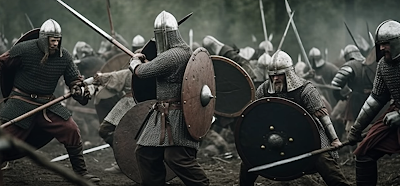
I’m on the verge of breaking into completely new territory, and frankly, it’s leaving me nervous.
My first real historical novel, USURPER, is published in 10 days' time. Yes, I can count it now in days rather than weeks or months. Today, I’m going to be talking a little more about this book – why I wrote it, why I’m nervous about it, and such. I’ll also be hitting you, as I do, with some of the rather splendiferous endorsements I’ve received for it from some of the true masters of the historical novel.
I also want to talk a little bit about two other books of mine, both of them medieval in atmosphere. They now belong firmly in my distant past, though their presence in my back-catalogue may explain why I continually say that USURPER will be my first REAL historical novel.
In addition to all this, and there’s no link to any of the other subjects I’ll be discussing today (except maybe that one of my older medieval books concerned a war against the undead!!!), I’ll be reviewing Edward Lee’s blood-soaked horror novel, BRIDES OF THE IMPALER .
If the Lee review is the only reason you’re here, you must feel free to skip down to the lower end of today’s blogpost, where my reviews usually lurk (in the Thrillers, Chillers section). However, if you want to hear a bit more about USURPER , stick around and let’s …
Mine the past
I’m sure those who follow my fictional output will agree that USURPER , a historical adventure set during the Norman conquest of England, is a complete right-turn on my usual subject matter.
I freely admit that I’m much better known for my crime thrillers. And I should probably even add that, though there’ll be more historical novels to come, this does not signal any kind of permanent changing of the guard. I’ll continue to write thriller novels (and horror stories) hopefully for many years to come, and with luck, readers will see them published concurrently with my all-new period pieces.
 However, the origins of
USURPER
probably need some explanation.
However, the origins of
USURPER
probably need some explanation.There’s no doubt that most of my thinking-time, the productive part of it anyway, is still wrapped up in worlds of contemporary darkness. What thoroughly unpleasant villainy can I dream up today? What scene of horror can I envisage in this blighted corner of Broken Britain?
Usurper is an action-packed, coming-of-age, adventure set against the upheaval and battles of 1066. Finch gives us Cerdic, a troubled hero thrown into the maelstrom of events outside of his control, and we follow him breathlessly as he deals with brutal Vikings, familial rivalries, unrequited love, invading Normans and more!
Matthew Harffy
But USURPER had to come from somewhere, right? It wasn’t just a one-off moment of inspiration.
It may surprise readers to know that, as a novel, it’s actually been a long time in gestation. I’ve been a huge fan of Dark Age and medieval history for ages. It’s always seemed to me that that era, especially here in Britain (that’s inevitable, I suppose, as it’s British history that I know about best), was born and bred for the telling of adventurous stories. I mean, you’re talking a landscape that was still mostly wild, a population that was thinly spread, a relatively ignorant society, much of which lay at the mercy of ruthless criminal elements, most of them fast-moving, many of them well-trained, a significant portion of them members of the ruling class itself.
In all honesty, the Wild West has got nothing on Medieval Britain.
Usurper propels the reader from the very first page through a dark and desperate age when Britons fought for their survival. Fearsome battles, believable characters, uncommon valour. A relentless page turner. David Gilman
Then of course, you’ve got the major events of history taking place – the invasions, the civil wars, the rebellions – causing huge political and cultural convulsions, leading to murder, mayhem and the destruction of land and property on a massive scale, with almost zero comeback against the perpetrators. No comeback that was lawful, anyway.
So, how could I, as a writer who enjoys pitting his characters against edificial evil, throwing them headfirst into a land where life seems to have no value at all, not want to get in on an act like this?
Thus was born USURPER .
The grim world of Anglo Saxon England is brought evocatively to life by master storyteller Paul Finch as he thrusts the reader deep into the cold and mud and blood of a country teetering on the brink of a devastating war for survival. Usurper is a must-read for any lover of history, capturing all the rich detail of a turbulent time and stitching it through with powerful emotion. Mark Chadbourn / James Wilde
It was almost a decade ago when I first hatched an idea about the teenage son of a great Saxon lord, who has lived an almost cossetted life thanks to the law, order and prosperity his father has brought to a remote corner of Edward the Confessor’s England, suddenly finding himself thrown out with the rubbish because the Norse army of Harald Hardraada has killed everyone he knows and loves and confiscated every last possession he once called his own, while the new Norman hegemony, maleficent in its triumph, has no time at all for the remnants of a culture they now plan to erase from history.
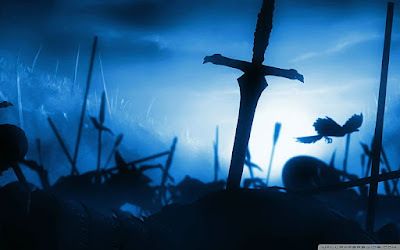
What kind of road back to normality can he find, this inexperienced lad? A kid who was actually training for the clergy and who had never picked a sword up in real combat, and yet now is friendless and lost in a devastated country he can no longer even recognise as his own?
I always knew there had to be a novel in that story. But for years and years, because I had many other commitments, all I could really do was sketch it down in note-form and knock out a few ideas, which I thought I might at some point be able to string together into an exciting narrative.
Finch has written an authentically blood-soaked historical epic to rank with the best.
Anthony Riches
And then came the pandemic, and the world seemed to stop. Now, don’t get me wrong. I had lots of work to do during lockdown. There were still books I was contracted to write, but gradually, because it dragged on for such a tediously long time, and because it had such a mammoth impact on the publishing industry, delaying book launches, delaying the associated publicity drives, delaying responses to even the most simple questions that a writer might routinely pitch to his/her publishers, I found myself with less and less that I actually needed to do.
Throughout this period, though perhaps inevitably, USURPER was on my mind. I began to see the long periods of inertia imposed by lockdown as an opportunity not just to catch up with some reading, but to do some speculative writing. And my proposed Saxon/Norman epic was top of that list.
With all the brutal power of a battle-axe to the head, Finch brings 1066 to life in new and vivid ways. Packed with blistering battle scenes and believable characters, this is a superb historical novel. Steven A. McKay
In almost no time – mainly because I’d been thinking about it for so long already – I’d written a 40,000-word chunk. It seemed to flow smoothly, but of course I was unsure. It was new territory for me after all. Not completely new, but I’ll talk about that later. So, I sent it off for a second opinion from my wonderful agent, Kate Burke, at the Blake Friedmann Literary Agency, and even though this was an unexpected submission, Kate got back to me amazingly quickly, and seemed delighted with it. Even though it was new ground for us, she said she was impressed enough to send it out … assuming I was happy to take a break from my normal contemporary thrillers and write this novel in full should someone be interested.
I certainly was. I didn’t expect the second half of this book to take me very long, because the first half hadn’t. Thankfully, the series of stop-start lockdowns we had to endure at the close of the pandemic was finally coming to an end, so I was hoping that things in the publishing world would speed up again, but I never would have imagined what happened next to happen so quickly.
An authentic and vivid depiction of life in England in 1066, and a brutal, blood-soaked thriller that will be loved by fans of Cornwell's Last Kingdom. Alex Gough
The first publisher the manuscript was sent to was Canelo, who accepted USURPER for publication almost by return post, but as two books rather than one, and to add icing to the cake, then commissioned an additional historical adventure series, a second duology, set later on, in the twelfth century, the details of which must at present stay under wraps.
 It was a strange feeling, all of these exciting developments coming to fruition so quickly when this idea had been germinating in the back of my mind for so many years, and often was pushed out of memory range entirely by the awful events that were happening in the real world at the time (even on those occasions when I remembered I wanted to write it, it struck me that no one might want to read about an apocalypse in 1066 when we seemed to be going through another in 2020).
It was a strange feeling, all of these exciting developments coming to fruition so quickly when this idea had been germinating in the back of my mind for so many years, and often was pushed out of memory range entirely by the awful events that were happening in the real world at the time (even on those occasions when I remembered I wanted to write it, it struck me that no one might want to read about an apocalypse in 1066 when we seemed to be going through another in 2020).Anyway, all that is thankfully now over, and the long and short of it is that the first book in this new series, USURPER , Vol One in the Wulfbury Chronicles is published in paperback and on Kindle and Audible on April 27, and then you good people can judge for yourself whether it was worth all that effort. As I say, I’m a tad nervous because it’s completely new ground for me. But then, as you’ve hopefully already seen in this column, quite a few august names in the historical adventure fiction industry given it the thumbs-up. So, let’s see what the rest of you think.
Early trips back
I mentioned earlier that I’ve written a couple of medieval novels before. Well, I don’t want to waste too much of your time, so I’ll just quickly outline them here.
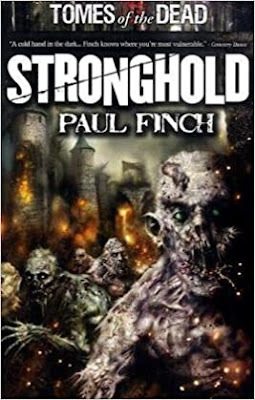 STRONGHOLD
was published by Abaddon Books in 2010, and is a horror / fantasy / alternative history, which sees the outbreak of a zombie apocalypse in the 13th century. It follows the fortunes of a ruthless company of English knights, under the control of a merciless marcher-lord, who commit much repression in Wales in the days following the battle of Maes Moydog in 1295, and then take possession of one of King Edward I’s mighty castles, only for the local druids to make use of the fabled Cauldron of Regeneration, one of the Thirteen Treasures of Britain, to raise an army from all those slain by the English during recent atrocities. The besieged knights soon find themselves battling relentlessly against an apparently numberless horde of the undead.
STRONGHOLD
was published by Abaddon Books in 2010, and is a horror / fantasy / alternative history, which sees the outbreak of a zombie apocalypse in the 13th century. It follows the fortunes of a ruthless company of English knights, under the control of a merciless marcher-lord, who commit much repression in Wales in the days following the battle of Maes Moydog in 1295, and then take possession of one of King Edward I’s mighty castles, only for the local druids to make use of the fabled Cauldron of Regeneration, one of the Thirteen Treasures of Britain, to raise an army from all those slain by the English during recent atrocities. The besieged knights soon find themselves battling relentlessly against an apparently numberless horde of the undead. Reviewers described it variously as ‘a very gory and bloody book, highly recommended’, as ‘fantasy military zombie porn - page after page of lavish description of the gruesome undead inflicting and receiving gruesome wounds’, and ‘a veritable dictionary of anatomical terms as body parts are skewered, severed, chewed and burnt in increasingly bizarre ways … It's all excellent fun delivered in the worst possible taste.’
So, I think you know what you’re getting with that one.
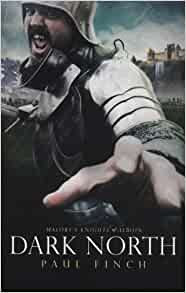 Then, also from Abaddon, we have
DARK NORTH
, published in 2012. This one was also a medieval fantasy rather than a medieval novel per se. It is set in Dark Age England, in this version called Albion, and instead of being a real-life scenario of hill forts, long-halls and muddy roads connecting small villages in otherwise trackless realms of forest, is basking in the Arthurian golden age, a landscape more reminiscent of the 14th century, full of lords and ladies, fairy tale castles and lush pageantry. However, the happy kingdom is now under threat from the reinvigorated Roman Empire, which, under the control of an aggressive new ruler, is determined to regain all its lost territories in Western Europe. A major war results, which provides the perfect cover for Sir Lucan, the Black Wolf of the North, one of the darkest characters ever to sit at the Round Table, to set off in pursuit of his wife, Trelawna, who abandoned him for a Roman officer, though he’s unaware that she’s now under the protection of the fearsome Malconi clan, who have the power to raise demons.
Then, also from Abaddon, we have
DARK NORTH
, published in 2012. This one was also a medieval fantasy rather than a medieval novel per se. It is set in Dark Age England, in this version called Albion, and instead of being a real-life scenario of hill forts, long-halls and muddy roads connecting small villages in otherwise trackless realms of forest, is basking in the Arthurian golden age, a landscape more reminiscent of the 14th century, full of lords and ladies, fairy tale castles and lush pageantry. However, the happy kingdom is now under threat from the reinvigorated Roman Empire, which, under the control of an aggressive new ruler, is determined to regain all its lost territories in Western Europe. A major war results, which provides the perfect cover for Sir Lucan, the Black Wolf of the North, one of the darkest characters ever to sit at the Round Table, to set off in pursuit of his wife, Trelawna, who abandoned him for a Roman officer, though he’s unaware that she’s now under the protection of the fearsome Malconi clan, who have the power to raise demons. Reviewers described this one as ‘a heady mix of violence, intrigue and some good old-fashioned knight-on-a-reckless-mission action, oh and some monsters thrown in too - this is a cracker of a book,’ along with ‘knightly fervour and noble deeds meet ruthless empire-building at full tilt’.
Personally (though I’m admittedly biased) I think these short pitches sound great (and it doesn’t surprise me that STRONGHOLD spent a year or so under option for movie development), but I’ll be the first to admit that they aren’t traditional historical novels, though they’re still available to buy if anyone’s interested.
THRILLERS, CHILLERS, SHOCKERS AND KILLERS …
An ongoing series of reviews of dark fiction (crime, thriller, horror and sci-fi) – both old and new – that I have recently read and enjoyed. I’ll endeavour to keep the SPOILERS to a minimum; there will certainly be no given-away denouements or exposed twists-in-the-tail, but by the definition of the word ‘review’, I’m going to be talking about these books in more than just thumbnail detail, extolling the aspects that I particularly enjoyed (I’ll outline the plot first, and follow it with my opinions) … so I guess if you’d rather not know anything at all about these pieces of work in advance of reading them yourself, then these particular posts will not be your thing.
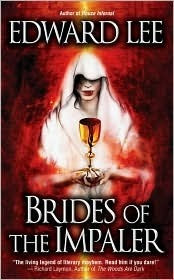 BRIDES OF THE IMPALER
by Edward Lee (2013)
BRIDES OF THE IMPALER
by Edward Lee (2013)
Outline
No-one would know to meet Britt Leibert and Cristina Nicholl that they’d shared a terrible childhood. The former a high-ranking New York social worker, the latter a successful designer of creepy dolls, they are not just firm friends, they are also a pair of beautiful, sophisticated women, cultured, fashion-conscious and well regarded among the Manhattan elite. Even more impressively (to some at least), they are engaged to two partners in a Manhattan law firm specialising in property and real estate, and financially at least, the sky is the limit.
In all this, the two women have done incredibly well, because as juvenile foster-sisters they were subjected to horrific abuse at the hands of their so-called guardians, a depraved duo who are now serving life prison sentences.
They each handle this awful heritage in their own way, though their methods are to an extent self-evident, Britt working professionally to assist those suffering abuse in the present day, Cristina channelling the horror of her memories into the creation of her cute but macabre toys.
Aside from that, there are few clouds on their horizon. Husbands-to-be, Paul and Jess, are legal carnivores who think nothing of having basically conned the Catholic archdiocese out of a palatial townhouse (which Paul and Cristina now occupy), but that goes with the lawyer territory. Besides, while you don’t get the feeling these two men are instinctively loyal to their women, on the whole they are kind and loving.
At the same time, local Homicide detective, Hal Vernon, has gone from having relatively little to do in this affluent part of town to dealing with a ghastly crime in which a drug addicted prostitute was impaled on a sharpened broomstick mounted in a Christmas tree stand. There is little to go on except that the body has been written on with marker pen, arcane and indecipherable lettering inscribed in black, green and red. He soon comes to suspect a gaggle of homeless women who have been seen around the district, allegedly in the company of a curvacious nun (yes, you heard that right!), though no-one seems able to locate any of these curious characters when the police want to speak with them.
Meanwhile, things are not exactly hunky dory in Cristina’s life. One of her dolls was found in the pocket of the recent murder victim, which in due course will bring her into the police spotlight. But before then, she finds herself increasingly subject to erotic dreams and fantasies, which pumps her sex-drive up to the maximum – to the point where it begins to interfere with her everyday activities. What’s particularly worrying, though, is that many of these fantasies seem to involve a ravishing, sexually aggressive nun, whose vampire-like presence in Cristina’s new house, particularly in the cellar, where up until now she has ignored the strange inscriptions and the odd atmosphere, is increasingly tangible.
It probably isn’t giving too much away to say that this mysterious nun is, in fact, Kanesae, a subcarnate succubus who was formerly the lover of Vlad the Impaler. The homeless women, whom she has mesmerised and who are now committing numerous crimes on her behalf, including desecrating the local church and impaling yet more unsuspecting victims, are her coven – or, as they see it, her ‘convent’, she being their ‘New Mother’. Even the nervous Father Rawlins, a Catholic priest who lives close by, was once custodian of the building in which Cristina now lives, and who knows about the dangerous relics buried underneath it, is unsure what action he can take, if any. Because though it may all seem like a frenzied erotic nightmare – and yes, the priest is also affected by Cristina’s beauty and her increasingly wanton behaviour! – he knows perfectly well that the sum of these horrors, in the very near future, will most likely be the second coming of Dracula …
Review
I wasn’t sure what to expect when I picked up Brides of the Impaler .
Previously, I’ve been familiar with Edward Lee as a writer of extreme horror, a skilled wordsmith whose prose is often a delight and yet who nevertheless takes gruesomeness to new graphic levels which even a hardened horror-hound like me can sometimes find difficult to stomach. I should therefore state straight away that Brides of the Impaler is not like that. From the outset, it has the air of a traditional vampire story, focussing on magic, mystery and esoteric history rather than excessive violence. And Lee maintains that quaint atmosphere almost all the way through; it is strongly redolent of those latter-day Hammer vampire movies of the 1970s (though unfortunately not always in a good way, and a bit more about that shortly).
In this one, the vamps are seductive killers from the past, thoroughly wicked and immoral, regularly communing with the demonic, and now, having been resurrected through arcane rites, imposing their blasphemous, predatory ways on a modern society that has cheerfully done away with religious belief and is therefore completely unprotected. Very thankfully indeed, Lee has jettisoned all those embarrassing teenage notions about vampires being some tragic nobility of the night who want only to be loved.
It’s also a relief to see that we’ve moved away from Bram Stoker’s concept of Dracula. While there are some similarities here, such as the Lord of the Undead hailing from Eastern European aristocracy, having earned his vampire state as a punishment for evil deeds, Edward Lee is much more interested in the history of Vlad Tepes than he is Stoker’s fictional count. While Stoker plundered Wallachian history for little more than the name, Lee goes all out to give us a full-blooded ‘Impaler’ backdrop, weaving myth and fiction with fact (Kanesae, for example, appears in no actual records) to tell the vivid tale of a medieval despot driven to acts of horrific criminality through his perilous circumstances and finally embracing evil for its own sake because by then he’d gone too far to stop.
These ideas have been promoted before, of course, mainly by patriotic Transylvanians, who can’t stand the thought of their national hero being defamed as an irredeemable villain, but Lee doesn’t stint in his portrayal of Dracula and his mistress as being themselves despicable, the former a deranged individual ripe for exploitation by the Devil, the latter a scheming demoness with one role only, to create Hell on Earth.
With the actual narrative set in present-day Manhattan, you might think all this a tad anachronistic, but not a bit of it. When the streets are littered with the homeless and addicted, there are acolytes aplenty for the empowering vampire cult. With ruined buildings on every side, many connected by forgotten tunnels, there is a ready-made underworld by which the fiends can pass invisibly among us. With maniacs and weirdoes at large on a daily basis, what are a few impalement murders for the cops to deal with? With voracious, shark-like lawyers on the prowl, can’t New York already boast a ruling class of monsters who are just waiting to take charge?
It’s all very clever, and a fun romp to boot, filled with wonderfully macabre details (Cristina’s creepy line of dolls, for instance, which includes such splendidly ghoulish specimens as Leprosy Linda, Hypothermia Harriet and Gutshot Glen) and some great innovations on the general theme … like the homeless ex-prostitutes forming a convent of vampiresses under the guidance of a devilish Mother Superior, and hero Hal Vernon killing one of them by repeatedly shooting her, but only because his bullet holes form the shape of a cross.
At the same time, Lee pays homage to several of his horror heroes, lawyers Paul and Jess close in name to Spanish cult movie-makers, Paul Naschy and Jess Franco, while the Ketchum Hotel, which also figures in the narrative, reminds us of the late, great US horror author, Jack Ketchum.
Yes, it’s all good fun, but it’s not good clean fun. If there’s a downside to Brides of the Impaler , it’s the sex. Frankly, there’s far too much of it and it’s far too explicit. Admittedly, students of the genre may not consider that a major problem, but in a mainstream horror novel in the 21st century it jars badly. And, dare I say it, at times it almost seems juvenile.
To start with, all the females are heavily sexualised. Granted, our heroes and heroines have to be attractive, but it goes to a whole new level in this one. Cristina and Britt – and bear in mind that these two women were badly abused when they were children! – are a pair of stylish, sensual beauties who are repeatedly depicted having sex with their boyfriends, and regularly described as having cleavage exposed or going out minus panties, and who as Kanesae’s influence spreads – particularly where Cristina is concerned – become ever more sexually insatiable (to a point where it verges on the ridiculous).
Kanesae herself, meanwhile, is the ultimate throwback to 1970s Hammer, as I mentioned previously: a gorgeous, voluptuous succubus, who, just to add to the kink, wears a revealing nun’s outfit and uses sex at every opportunity to overwhelm both friend and foe alike.
And it doesn’t end there. Even the homeless women, though shown as emaciated, gap-toothed harridans with crusty hair and foul body odour, are frequently portrayed in a pseudo-sensual way, and shown to be experts at various sex acts. Even though this is supposed to be the influence of Kanesae, who destroys her victims’ souls as well as their bodies, it still feels tasteless to me. Even a middle-aged kindergarten teacher is referred to by the cops as ‘Bouncing Betty’ because she is so well-endowed, while we also hear repeatedly, for no gain, that a female student and a female security guard, both of whose main role in the book is to die unpleasantly, have similar advantages.
Brides of the Impaler was published in 2013, so Lee doesn’t have the same excuse that the latter-day Hammer horrors did (namely that it was the product of an unashamedly raunchy age) and even for a reader like me, who’s pretty easy-going, this seamy side of the book soon becomes repetitive and boring.
But this is the only real problem with the novel.
Overall, Brides of the Impaler is a time-honoured kind of vampire story given an effective and entertaining modern twist. As always with Lee, it’s excellently written, taking you straight into the heart of the modern city and yet convincingly underwriting it with an evil, supernatural netherworld. Hal Vernon as the affable, middle-aged cop makes a good-natured hero, while Cristina Nicholl, even if she’s completely oblivious to her overt sexiness, makes for an appealing and (relatively) innocent heroine. And I say it again, at least it takes us right away from these Goth/teenage vampire farces in which the dividing lines between good and evil are naively blurred. In that regard, this is a very welcome addition to the vampire fiction cycle.
As usual, I’m now going to attempt some fantasy casting just in case Brides of the Impaler ever gets put on film, though it won’t be easy given that we no longer have an Ingrid Pitt or Susan Denberg to play Kanesae. The only solution is to assume that the sex, or some of it at least, will be toned down a bit. On that basis, here we go:
Cristina Nicholl – Margot Robbie
Britt Leibert – Camille Belle
Paul Nasher – Kyle Gallner
Jess – Christopher Mintz-Plasse
Hal Vernon – Stanley Tucci
Father Rawlins – John Amos
Kanesae – Lena Gercke
Published on April 16, 2023 12:19
March 30, 2023
When swords and axes ruled the battlefield
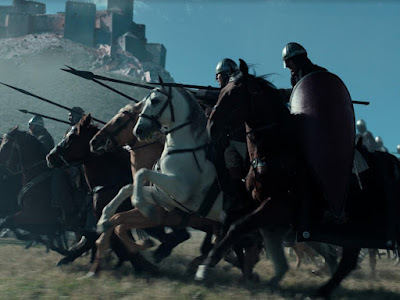
For the next few weeks, we – as in Canelo Books and me – will be moving full tilt towards publication of my first ever serious historical novel, USURPER, published on April 27. I don’t want to give too much away, though by now, if you’ve been reading any of the advance material, it’ll be plain that the story is set during the autumn of 1066, against the backdrop of the dual invasion of England by both a Viking army and a Norman army at the same time.
 If you’ve been checking things out online, you may have noted that the book has already accrued a number of glowing endorsements by some very respectable authors of historical action-fiction. Several comments I’ve received from these august wordsmiths have mentioned the battle scenes, which they appear to have appreciated greatly.
If you’ve been checking things out online, you may have noted that the book has already accrued a number of glowing endorsements by some very respectable authors of historical action-fiction. Several comments I’ve received from these august wordsmiths have mentioned the battle scenes, which they appear to have appreciated greatly. In honour of that, this week I thought I’d cast an eye over the ten best pre-industrial age battle scenes that Hollywood has thus far attempted. Please feel free to agree with my choices, or disagree, as you see fit, in the comments section or on Facebook, Twitter or wherever. In addition, on the subject of war, and bringing things forward somewhat worryingly close to our modern era, I’ll be reviewing Steve Alten’s sci-fi military epic, GOLIATH.
If you’re only here for the Alten review, that’s no problem. You’ll find it as always at the lower end of today’s column in the Thrillers, Chillers section. Just shoot on down there straight away. For the rest of you though, assuming you’ve got a spare moment or two, why not check out some of …
CINEMA’S GREATEST ‘SWORD AND SPEAR’ BATTLES
Again, just a bit of fun, this item. Something we can chat idly about over a brew. Basically, I’ve picked ten pre-gunpowder era battle scenes from movies I admire. But there are certain criteria I’ve imposed on myself.
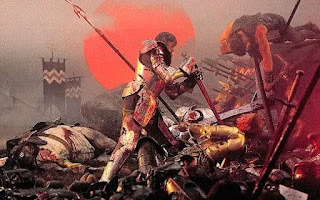 To start with, they can only be recreations of named battles that really happened in history. So, that rules out the likes of
Lord of the Rings
(2001/3),
Game of Thrones
(2011/19),
Excalibur
(1981),
The Warlord
(1966) and even the amazing opening sequence in
Gladiator
(2000), which was basically an amalgam of many battles and skirmishes fought by Rome’s frontier legions in the Danube region during the 170s AD rather than one single individual action.
To start with, they can only be recreations of named battles that really happened in history. So, that rules out the likes of
Lord of the Rings
(2001/3),
Game of Thrones
(2011/19),
Excalibur
(1981),
The Warlord
(1966) and even the amazing opening sequence in
Gladiator
(2000), which was basically an amalgam of many battles and skirmishes fought by Rome’s frontier legions in the Danube region during the 170s AD rather than one single individual action. I’ve also stipulated for myself that I can only call on battle scenes that made at least an attempt to be realistic. So unfortunately, that also discounts the battle of Thermopylae as portrayed in Zack Snyder’s 300 (2006), because artistically brilliant though it was, it owed far more to Frank Miller’s original graphic novel than actual history.
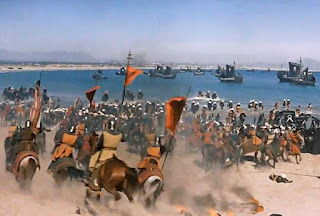 Likewise, it sidelines Anthony Mann’s colossal epic of the Reconquista,
El Cid
(1961), as the real battle that drove the Berber horde back from the city of Valencia in 1094 was on the inland plains, not the coast, and even Mel Gibson’s multi Oscar-winning
Braveheart
(1995), which, while it recreated two major historical battles – Stirling Bridge (1297) and Falkirk (1298) – is infamous the world over for its lack of historical correctness (the Stirling Bridge sequence is stupendously blood-soaked, but it doesn’t even include a bridge).
Likewise, it sidelines Anthony Mann’s colossal epic of the Reconquista,
El Cid
(1961), as the real battle that drove the Berber horde back from the city of Valencia in 1094 was on the inland plains, not the coast, and even Mel Gibson’s multi Oscar-winning
Braveheart
(1995), which, while it recreated two major historical battles – Stirling Bridge (1297) and Falkirk (1298) – is infamous the world over for its lack of historical correctness (the Stirling Bridge sequence is stupendously blood-soaked, but it doesn’t even include a bridge). As a final rule, the movies I choose should also have been made in the English language. Please don’t get on my case about that. Though in polite company I always discuss classic motion pictures like Alexander Nevsky (1938), Kagemusha (1980) and Red Cliff (2008) as if I know what I’m talking about, the truth is that I’m no expert on foreign films and it won’t pay to pretend that I am.
Okay … them’s the rules, as they say. In order of preference, let’s get cracking.
1. BATTLE OF SHREWSBURY (1403) Chimes at Midnight, 1965
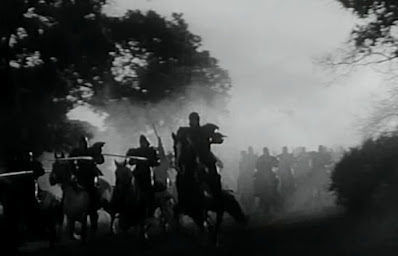
One of the greatest battles ever committed to celluloid, and all the more impressive because of its shoestring budget. Director/star Orson Welles condensed several of Shakespeare’s plays into this single account of the Northern Earls’ Rebellion, which threatened the stability of the entirety of mainland Britain. Shrewsbury was a bloody affair indeed, an estimated 12,000 dying on the field, Welles recreating it with incredible ingenuity, using swirling mist, flying mud, blood and splintered shields to mask his relatively limited numbers, yet it remains eye-poppingly intense.
2. BATTLE OF THE RIVER SELE (71 BC) Spartacus, 1960

Everyone remembers the ‘I am Spartacus’ moment, but it wouldn’t have been as effective if it hadn’t come directly after the Battle of the River Sele, which in real life was fought upland and saw the heroic leader of the slave army confronted by three of Rome’s most proficient generals, Pompey, Lucullus and Crassus (with Julius Caesar in attendance as a junior officer). Hollywood legend Stanley Kubrick (still only 32) gave us one of cinema’s most realistic ever portrayals of Roman legionary tactics, and got up close and personal with burnings and hackings galore.
3. BATTLE OF JERUSALEM (1187)Kingdom of Heaven, 2005
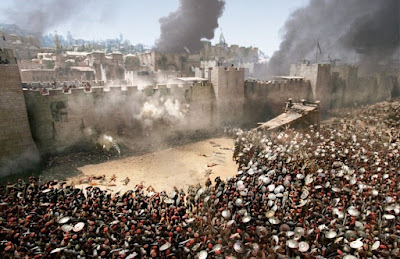
Though as a prelude to this massive engagement, the Christian army of Outremer suffered the greatest defeat in its history at the hands of Islam’s ablest general, Sultan Saladin of Egypt, at Hattin, it was the follow-up action at Jerusalem that caught the eye of regular epic film-maker, Ridley Scott. Though much maligned thanks to the incomprehensible truncated version of this movie released by the studio, the director’s cut remains a visual feast, and culminates in one of the most impressively mounted battles against a bastion that Hollywood has ever given us.
4. BATTLE OF GAUGEMALA (331 BC) Alexander, 2004
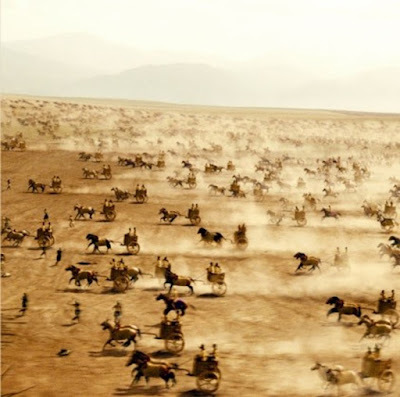
Though poorly received overall, Oliver Stone’s Alexander rises to some memorable battles, and it’s fitting that one of the most important in the Ancient World is given such prominence. Briefly at least, the unending tussle between Greece and Persia was settled when Alexander pitted his numerically inferior but better trained army against the vast but mostly indentured forces of Darius III. The outcome was in doubt to the end, and Stone sticks to that narrative, emphasising the Macedonian king’s ability to make key strategic changes even in the midst of mayhem.
5. BATTLE OF AGINCOURT (1415) Henry V, 1988
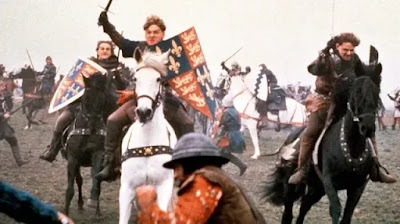
The scale of England’s victory over France in this most famous battle of the Hundred Years War is staggering even now. Henry’s hungry, dysentery-ridden 8,000 overcame the flower of French chivalry, who were closer to 30,000, laying 10,000 of them dead in the mud of that bitter October day, losing only a few hundred in return. It was a triumph for discipline over enthusiasm, for the longbow over plate armour. But Ken Branagh’s version doesn’t glorify any of it, those left alive on the corpse-strewn field at the end shattered husks of the men they’d been.
6. BATTLE OF EDINGTON (878) The Last Kingdom, 2015
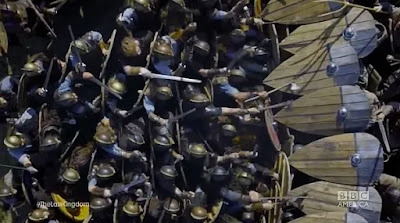
Though much of The Last Kingdom owes mainly to Bernard Cornwell’s imagination, in which most of the early English state’s best wins over the Vikings are attributed to his semi-fictional hero, Uhtred, rather than the real leaders, at least this TV adaptation’s version of Alfred the Great’s mightiest victory is as close as damn it to the true event. The hideous meat-grinder of two hefty shield-walls clashing repeatedly over piles of butchered corpses, so characteristic of Saxon and Viking age warfare, is captured perfectly in this brutal bloodbath of attrition.
7. BATTLE OF ORLEANS (1429) The Messenger: The Story of Joan of Arc, 1999
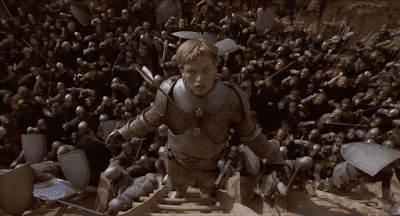
Some may argue that Joan of Arc’s greatest triumph lay in her personal martyrdom for what she considered a holy cause, but in purely tactical terms, it was her defeat of the English forces entrenched in the fortified city of Orleans, which turned the tide of the Hundred Years War, so it’s perhaps no surprise that it took a French director, Luc Besson, to give us a committed and realistically workmanlike portrayal of this crucial military enterprise, in which all manner of medieval artillery is used, the English defences falling section by section as a direct result.
8. BATTLE OF KADESH (1274 BC) Exodus: Gods and Kings, 2014

One of the earliest battles we have a written record of, Kadesh saw the celebrated pharaoh, Ramesses II, strike a heavy blow against Egypt’s great rivals of that era, the Hittites. Whether it belongs in a movie about Moses is another matter, but both Ramesses and Kadesh are referred to repeatedly in non-Biblical texts, and it seems entirely fair that Ridley Scott should have featured this epic struggle in his most religious movie. To add authenticity, he gives the Egyptian chariot force a leading role, for it was this mobile arm that swung the battle in Ramesses’ favour.
9. BATTLE OF LOUDOUN HILL (1307) Outlaw King, 2018
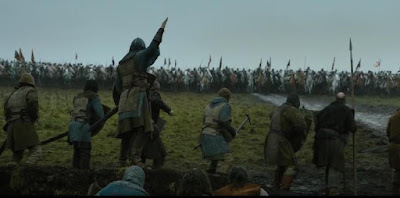
Often overlooked for its bigger, noisier cousin, Braveheart , Outlaw King shows us the early days of Robert the Bruce, focussing on one of his first successes. Director David Mackenzie makes much more effort than Mel Gibson did to depict the era as it was, dispensing with any notion of Bronze Age face-paint and 16th century tartan, to tell a more emotionally and factually complex story, the whole thing culminating at Loudoun Hill, where the fighting, while it borrows some detail from the later victory at Bannockburn, is tactically accurate and appropriately grim and desperate.
10. BATTLE OF ASHDOWN (871) Alfred the Great, 1969
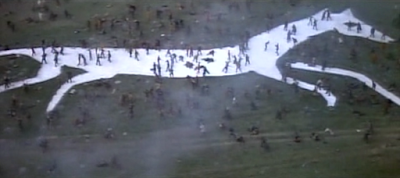
The first major victory for an English army over the seemingly unstoppable Viking horde that invaded Britain in the mid-9th century. Alfred the Great, then only a prince, won the day by luring the overconfident Danes into an ambush, which was very neatly depicted in Clive Donner’s ‘warts and all’ 1969 account. And while the presence on the battle site of the Uffington White Horse is ahistorical – no one knows for sure whether the colossal figure was cut into the hillside before or after this war – it makes for a truly atmospheric location.
THRILLERS, CHILLERS, SHOCKERS AND KILLERS …
An ongoing series of reviews of dark fiction (crime, thriller, horror and sci-fi) – both old and new – that I have recently read and enjoyed. I’ll endeavour to keep the SPOILERS to a minimum; there will certainly be no given-away denouements or exposed twists-in-the-tail, but by the definition of the word ‘review’, I’m going to be talking about these books in more than just thumbnail detail, extolling the aspects that I particularly enjoyed (I’ll outline the plot first, and follow it with my opinions) … so I guess if you’d rather not know anything at all about these pieces of work in advance of reading them yourself, then these particular posts will not be your thing.
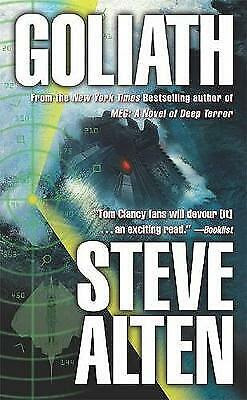 GOLIATH by Steve Alten (2002)
GOLIATH by Steve Alten (2002)
Outline
Tough and efficient female naval officer, Commander Rochelle ‘Rocky’ Jackson, is participating in ocean manoeuvres on board the USS Ronald Reagan when something unprecedented happens. Without warning, the US fleet, one of the most well-equipped and professionally managed fighting forces in the world, is attacked from below by Goliath, a US-developed, manta ray-shaped super-sub, a gigantic, futuristic undersea battle-platform armed with every kind of missile and torpedo, including multiple nuclear warheads.
It is a remarkably one-sided fight. The US fleet is totally destroyed, with Rocky Jackson one of the few survivors. Some 8,000 men go to watery graves.
Naturally, the world convulses in shock. Initially, the US military think the Chinese responsible, as it was the Chinese who acquired the blueprint for Goliath at an early stage due to the actions of senior engineer and former spec ops hero, Gunnar Wolfe. Wolfe, fearing an imbalance of power in the world, committed treason by handing over state secrets, and was subsequently sent to Leavenworth. But it actually isn’t the Chinese. They went ahead and built the Goliath prototype, at phenomenal cost, even installing ‘Sorceress’, a highly advanced biomechanical nano-brain – only for the vehicle then to get stolen from right under their noses by Simon Covah, a former Soviet sub-commander and a military and mechanical genius.
Driven mad by the murder of his family at the hands of Kosovan terrorists, and the general state of a world riven apart by tyranny and fear, Covah, now aided by a cohort of physically and emotionally disfigured partisans, is in possession of the deadliest weapon on Earth, and takes refuge with it at the bottom of the ocean. A stealth-craft, Goliath is undetectable even near the surface and so is completely invisible down in the abyss, from where its new controller attempts to blackmail humanity, threatening nuclear devastation if his long list of terms is not met.
As these terms include the public executions of known despots, the dismantling of various police states and the disassembly of everyone else’s nuclear arsenals, the US realises that it can’t bargain with Covah. But neither can it defeat him in a straight fight. The US also knows that he’s as good as his word; it isn’t long before atomic destruction is raining down on certain selected targets.
A team of experts is swiftly put together to try and countermand the madman. Rocky Jackson, who worked on Goliath during its early stages, is one of them. Another is her ex-boyfriend now turned reviled traitor, Gunnar Wolfe, as he too was involved in the development programme. Naturally, they are antagonistic to each other, though for the time-being at least they must put their differences aside.
It still seems like the tallest order imaginable, and things are only going to get worse. Because the real problem on board Goliath is not the deranged Covah, but Sorceress. The hi-tech computer has finally developed AI and is quietly hatching its own coldly logical and vastly more terrifying strategy …
Review
At best, Goliath is a high-octane techno-thriller with some lightweight political stuff woven in, a few warnings about the dangers of state-of-the-art computer science, and numerous of Steve Alten’s trademark gripping action sequences. It’s basically a load of fun. The reason you’ve probably not heard about it though is because, with almost indecent speed after publication, it was overtaken by real-life world events.
It first hit the shelves in 2002, a time when, though there was constant trouble in the world, particularly in the Middle East, it hadn’t reached anything like the catastrophic state of affairs that exists today. This doesn’t mean you won’t enjoy the book, especially if you view it as a kind of alternate history, though the unfolding events of the 2000s in Goliath take a very different direction from those in our own experience, so it jars quite hard on first reading. That said, in some ways, the book is worryingly prophetic. Both Saddam Hussein and Colonel Gaddafi die violently during the course of it (though probably less horribly than they did in reality in 2003 and 2011 respectively).
Another slight problem – and this perhaps is being picky – is that in Goliath the US is once again the hero nation, the team of good guys that sets out to save the planet and ultimately succeeds in bringing down this most monstrous manmade threat with minimal help from anyone else. Okay, it’s not quite as simplistic as that. For the most part, Alten adopts a mature approach, and incorporates lots of Machiavellian intrigue, with various senior politicians and military men putting their own interests first, failing to see the bigger picture – all that kind of thing. But ultimately in this day and age, whether rightly or wrongly, not everyone on Earth views the US as their inevitable friend and saviour.
That’s hardly Steve Alten’s fault, of course. He’s an American writer and he writes about his own people first. No quibbles there. But this may be one other reason why the book is not widely regarded as a classic action romp. Because I’ll be absolutely honest … Alten has a prodigious talent for writing about modern-day technology, weaponry, military uniforms, military procedures and the like, and I don’t think he’s ever done it as well as he does it here. It’s all incredibly vivid and accessible. On top of that, it’s a lightning read. You can see and hear everything that’s happening easily and coherently, and yet Alten sacrifices none of his narrative’s pace or energy to achieve this. It’s almost like a well-written movie script, and it wouldn’t surprise me if Goliath had perhaps commenced its life in that format. It’s got ‘blockbuster action film’ written all over it, though as I say, real historic events suddenly ran way ahead.
On the downside, the characters are perhaps a little clichéd. Rocky Jackson, an archetypical GI Jane, and Gunnar Wolfe, the tough guy with a conscience, are made-to-measure heroes: handsome, athletic, highly qualified, unfeasibly skilled in a massive range of disciplines. The back-story about Wolfe’s betrayal is interesting in terms of setting up their fire-and-water relationship, but it starts to intrude after a while, and, being frank, he did commit treason. It’s difficult not to empathise a little bit with those former colleagues who don’t trust him enough to bring him back on board, and I couldn’t help wondering why certain others, including Rocky’s dad, General ‘Bear’ Jackson, who at one time nearly became Gunnar’s father-in-law, would.
It would also be wrong not to mention that a sentient but crazed computer is not a new concept. Just off the top of my head, I can think of two earlier examples: Colossus by DF Jones (1966) and of course 2001 by Arthur C. Clarke (1968); so, while Alten gets plaudits for exploring our increasing paranoia about advanced AI, it isn’t monumentally original.
But hey … this is sci-fi fantasy, and it’s tackled by the author with an immense, contagious gusto. I freely admit that I found myself devouring Goliath , racing through the pages as we progressed from one high point to the next, a succession of huge, thunder-flashing, hull-crunching, metal-splintering action sequences, not a single one of which disappointed me.
Just treat it as the rip-roaring undersea (and oversea) yarn that it is, and it should keep your attention until the very last page.
As always – purely for the fun of it – here are my picks for who should play the leads if Goliath is ever adapted for film or TV (though it would need some significant rewriting in terms of its plot first – and that never happens in Hollywood, does it!):
Rocky Jackson – Zoe Saldana
Gunnar Wolfe – Jensen Ackles
Simon Corvah – Mark Rylance
General ‘Bear’ Jackson – Ving Rhames
Published on March 30, 2023 02:25
March 12, 2023
Twenty high points of horror in British TV

Well, I’m still in a holding pattern at present with regard to blogposts. There are several announcements I want to make, but simply can’t. So, perhaps you can indulge me and we’ll just have a fun post this week.
Today therefore, purely for a laugh, I thought I’d give you My TOP 20 SCARIEST BRITISH TV HORROR MOMENTS.
Note that I said ‘TV’, not cinema. However, we’ll also be venturing into the world of literary horror today, because in addition to that, I’ll be reviewing THE DEVIL TAKES YOU HOME by Gabino Iglesias, a fascinating and terrifying crime novel, which ranges much further into the darkness than almost any other thriller I’ve read to date.
If you’re only here for the Iglesias review, that’s no problem. Just do the usual thing. Scoot down to the bottom end of today’s post, to the Thrillers, Chillers section, and you’ll find it there.
But, before we crack on with Brit TV’s best ever terror, check this out.
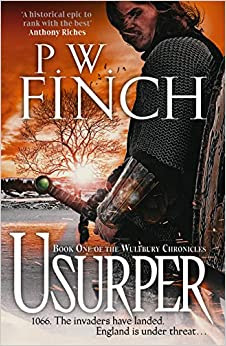 Why 1066?
Why 1066?I’m not going to spend too much time on this, because the podcast does most of the talking, but my new novel, a historical adventure called USURPER , is out in just over one month’s time. There’ll probably be quite a bit of promotional stuff appearing on this over the next few months, and last week I was pleased to get the ball rolling by being interviewed by Dick Newman for the Australian-based podcast, ENGLISH HISTORY, FACT AND FICTION , a chat in which we focussed on that most apocalyptic year in the history of England, why I chose it and how I sought to milk the most darkness and drama out of it that I possibly could. And, well, here it is now. Those interested, please feel free to check it out. The interview kicks in at around 45.
Heck
A quick update on the Heck series, primarily because people keep tweeting me and asking, which I massively appreciate, by the way (I love it that the books made such an impact). All I can do is reiterate that the series is not finished. Two new Heck novels have been written, the first one picking up exactly where the last one left off, and I am as eager as anyone else to see them on the shelves. But I am NOT in full control of publishing schedules. There are other people involved in the process, and it’s always a matter of all our interests falling into line. But I ASSURE those of you to whom this matters, that the series is NOT done, and at some point soon, the next Heck novel will be published.
And now …
Top 20 SCARIEST MOMENTS IN BRITISH TV HORROR
(As strongly influenced by HORRIFIED MAGAZINE and SCARRED FOR LIFE ).
It seems bizarre in this day and age, when many of our network broadcasters seem convinced that fly-on-the-wall docu-soaps are vastly more captivating for British TV audiences than original drama or comedy, but television in the UK was once a seedbed of genuinely frightening horror.
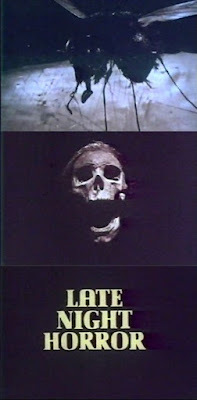 The golden era of this was probably the 1970s and 1980s, when a plethora of horror anthology shows, aimed both at adults and younger viewers, darkened our screens. But you could go way further back than that, with Nigel Kneale’s ground-breaking Quatermass series (pictured at the top), which ran throughout the 1950s, and Dr Who of course, which kicked off in 1963, a so-called children’s TV show that would go on to scare the pants of viewers of all ages on umpteen occasions.
The golden era of this was probably the 1970s and 1980s, when a plethora of horror anthology shows, aimed both at adults and younger viewers, darkened our screens. But you could go way further back than that, with Nigel Kneale’s ground-breaking Quatermass series (pictured at the top), which ran throughout the 1950s, and Dr Who of course, which kicked off in 1963, a so-called children’s TV show that would go on to scare the pants of viewers of all ages on umpteen occasions. Also in the ’60s, and perhaps in terms of harder core horror, we had Mystery and Imagination (1966-1970), Late Night Horror (1968) and Journey to the Unknown (1968/69), not all of which, sadly, remain intact in the television archive.
As I say, it was really the 1970s when British TV genuinely picked up the horror torch and ran with it. The tone was set, weirdly enough, with a whole range of public information films, many of them again aimed at children, warning the UK populace about the dangers of everyday life. No one, but no one, forgets Lonely Water (1973), in which horror veteran Donald Pleasence played a menacing hooded figure who haunted the banks of isolated rivers, canals and millponds, just waiting to drown unwary youngsters.
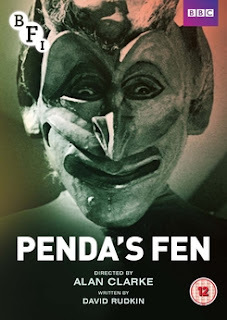 But that was only the start of it. Even British TV’s exponents of higher culture got in on the act, Play for Today hitting the nation with Robin Redbreast in 1970 and Penda’s Fen in 1974.
But that was only the start of it. Even British TV’s exponents of higher culture got in on the act, Play for Today hitting the nation with Robin Redbreast in 1970 and Penda’s Fen in 1974. In terms of actual horror shows, the ’70s and ‘80s produced some bona fide classics, Doom Watch, Dead of Night, Thriller, Ghost Story for Christmas, Beasts, Shadows, Supernatural, Hammer House of Horror, Tales of the Unexpected, Shades of Darkness, among many others.
Shows like these became thinner on the ground in later decades, but there are still one or two highlights post-1989 that are worth mentioning. Stephen Gallagher’s Chimera, a chilling adaptation of his own highly intelligent 1982 sci-fi/horror novel, hit our screens in 1992, while Ghosts in 1995 successfully revived the spirit of those earlier supernatural portmanteau dramas.
But enough of all this. You didn’t come here today to get a TV history lesson. If you want one of those, you can easily learn more on the subject from far more scholarly websites than this. As I’ve already mentioned, HORRIFIED MAGAZINE is a great place to start, and SCARRED FOR LIFE vols 1 and 2 would help as well. But perhaps if you’re keen to zero in on a few high points, this list below will be of interest.
As I say, it’s my personal Top 20 Scariest Moments in British TV Horror. I’m sure there’ll be many arguments about absentees. No Warning to the Curious? No Robin Redbreast? No reference at all to the legendary younger viewers’ series, Children of the Stones? Surely that one’s worthy of a mention?
Well … yes, they all are. But there is insufficient time and room here for an encyclopaedic account. So, you’ll just have to make do with the really good moments I remember best, though by all means feel free to point out any particularly shocking absences in the Comments section. The more the merrier.
Anyway, let’s get on with it …
1. WHITE BEAR – BLACK MIRROR (2013)

Charlie Brooker’s Black Mirror was much given over to dystopian futures, but this one hits us with a sneaky double-bluff, its bedraggled heroine staggering through a protracted but corny succession of sci-fi/horror twists and turns, only for it to turn out that she’s the main actor in a popular but horrific game-show. A slick comment on our modern habit of filming torture rather than trying to stop it.
2. BABY – BEASTS (1976)
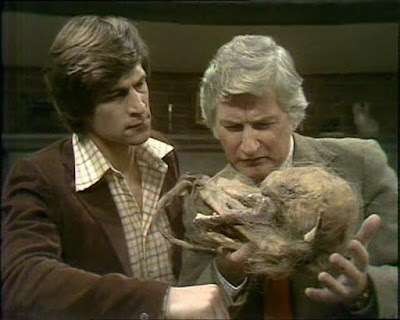
Nigel Kneale’s first appearance on this list but far from his last. Perhaps it seems a little talkie by modern standards, but not a word is really wasted as the doomed young couple at the heart of it eagerly renovate their olde worlde country cottage, only to find something very nasty embedded in the wall. At this stage, of course, they don’t know the real meaning of ‘nasty’, but they soon will.
3. THE WOMAN IN BLACK (1989)
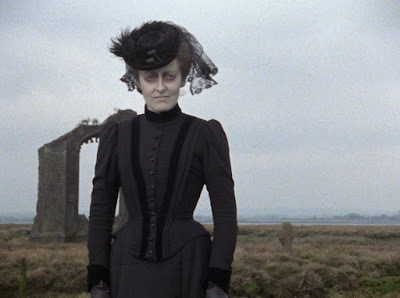
An amazingly atmospheric adaptation of Susan Hill’s ghost story masterclass. The directing, the acting, the writing (of course Mr Kneale again!), everything is pitch-perfect. The location is dreariness personified, and yet possesses an atmosphere of strangeness and dread that owes nothing to cinematic trickery. It also contains one of the scariest spectres in TV history.
4. SCHALCKEN THE PAINTER – GHOST STORY FOR CHRISTMAS (1979)
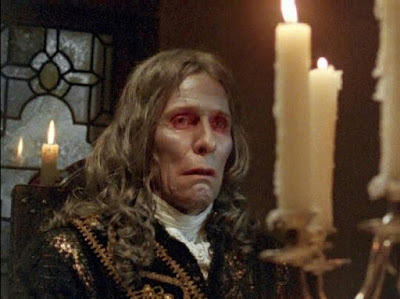
Something of an arthouse effort for the BBC Ghost Stories for Christmas slot, perhaps because it was part of the Omnibus series. It amounts to a very faithful recreation of one of Sheridan Le Fanu’s most frightening short stories. Beautifully dressed, impressively underplayed, directed as though it’s actually a succession of Flemish School paintings, and boasting a truly terrifying denouement.
5. MEN AGAINST FIRE – BLACK MIRROR (2016)
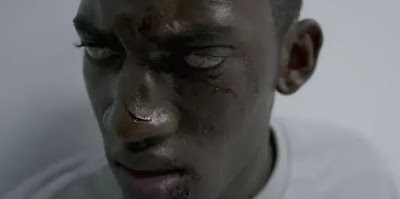
Another of Black Mirror’s dystopian parables, as penned by Charlie Brooker, this time following the fortunes of a military unit, and one soldier in particular, as they track down and wipe out nests of so-called ‘roaches’, savage humanoid insurgents who are ruining the land. The real horror, of course, is the mind control by which the troopers are persuaded to view these innocent intruders as a threat.
6. QUIET AS A NUN – ARMCHAIR THEATRE (1978)
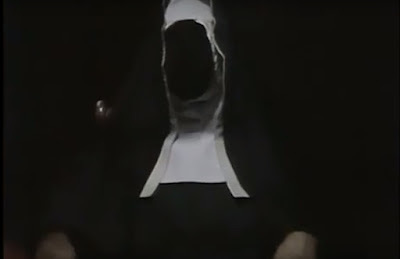
Cosy crime meets full-on horror in a TV series that simply refused to pull its punches when it came to scaring its audience. Antonia Fraser wrote the original novel as part of her Jemima Shore series, in which there was much to do with big inheritances, country houses and murder, but this one is worth including simply for episode 3 and the bone-chilling appearance of the infamous Black Nun.
7. SOMEONE AT THE TOP OF THE STAIRS – THRILLER (1973)
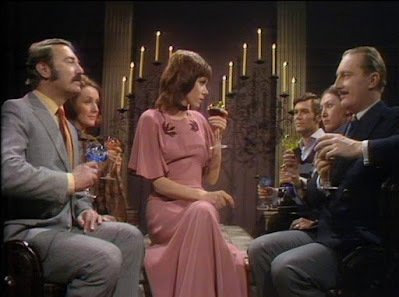
One of the earliest episodes of Thriller, number three in the first series, and one that would cut deeply with anyone who’s ever stayed in a low-rent bedsit. The rickety stairs, the dingy passages, the strange sounds from the other rooms, the increasingly weird fellow occupants, and the occasional moments of 1970s sleaze all place this one firmly in Pan Book of Horror Stories country.
8. THE SIGNALMAN – GHOST STORY FOR CHRISTMAS (1976)
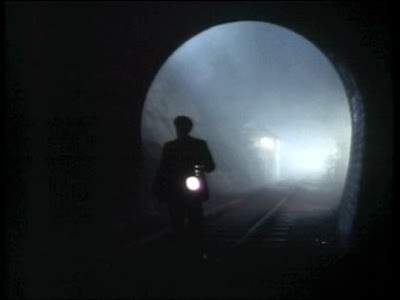
One of the most memorable of the BBC’s Ghost Story for Christmas series, and the first to be adapted from non-MR James source material. The eerie tunnel mouth location, the enshrouding fog, the constant bleakness of the moors and, of course, Denholm Elliot’s performance as the harrowed and haunted hero of the title all last long in the festive memory.
9. THE HOUSE THAT BLED TO DEATH – HAMMER HOUSE OF HORROR (1980)

The one episode of this hit and miss series that everyone remembers. With the case of the Amityville Horror still a talking-point, this tale of an innocent family hounded in their new home by a demonic force that either created or was caused by an act of pure evil, was timely indeed, and incorporated some spectacularly horrible moments. Remember the children’s party that became a bloodbath?
10. HATED IN THE NATION – BLACK MIRROR (2016)

Another ingenious idea from Charlie Brooker, and a concept that could grace either Quatermass or Dr Who, a swarm of bee-bots, developed to help pollinate crops, being hacked and unleashed against a daily target of choice, as chosen by social media users. Not just an ominous vision of things to come, but a nightmare that might become reality even sooner than Brooker realised.
11. NIGHT OF THE MARIONETTES – SUPERNATURAL (1977)
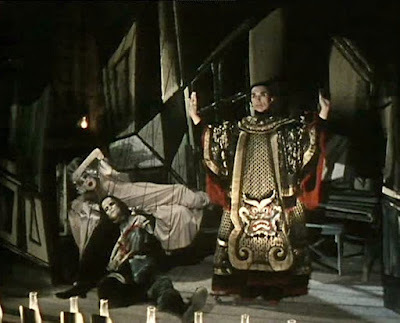
Supernatural was bedevilled by low budget production, sometimes playing the Blue Peter trick of offering simple line-drawings as excuses for exotic landscapes, but though all the stories trod familiar Gothic horror footpaths, this very different spin on Frankenstein added much, much more. Again, it’s too talkie, but the actual festival of the marionettes is a genuine eye-popper.
12. LEAVING LILY (1975)
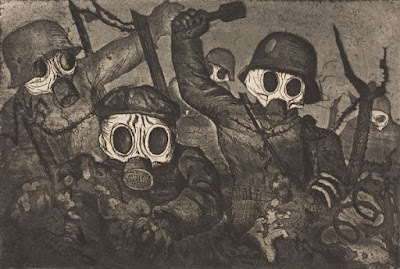
A little-seen half-hour gem from the pen and director’s chair of Graham Baker. It concerns a young Norfolk farmhand determined to do his bit at the height of World War One, but while he spends his last day before enlistment with his village sweetheart, Lily, a menacing khaki-clad figure is slowly crossing the fens towards them, and with it, a terrible revelation.
13. DURING BARTY’S PARTY – BEASTS (1976)
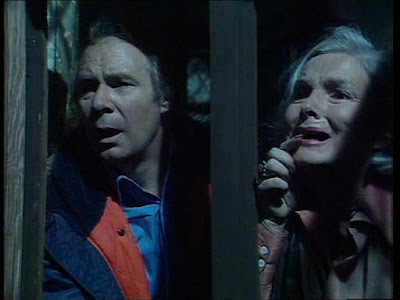
The near total studio-bound production somehow fails to reduce the nightmarish quality of this episode from Hell. You never see the verminous antagonists, but the noise they make is mind-numbing, the screams of the dying appallingly real, while the cast give it everything they’ve got, slipping from suburban normality into childlike terror and despair with total conviction.
14. DORABELLA – SUPERNATURAL (1977)

A vampire tale makes the cut. It’s not perfect, but all the tropes are there: the Grand Tour setting, the journey into the heart of a nameless land, the Gothic castle, the mysterious beauty who only appears at night, and the gleefully demonic nature of the undead, particularly in the guise of TV horror veteran John Justin, who is truly terrifying as the titular anti-heroine’s monstrous father.
15. THE BOYS’ CLUB – URBAN GOTHIC (2000)
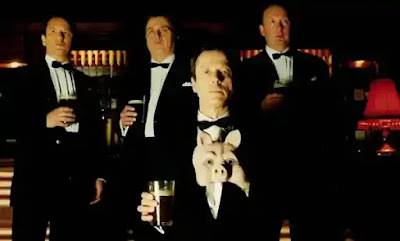
An ultra-violent tale of the inner city to contrast sharply with the others on this list. The marvellous East End nightclub where it was mostly filmed, the fun that ‘old lag’ actors Leslie Grantham, Nicholas Ball, Ray Burdis and John Bowler all have in familiar underworld roles, and the story itself – a study of youthful arrogance taken to lethal levels – all conspire to make this a distinct cut above the rest of the series.
16. GHOSTWATCH (1992)
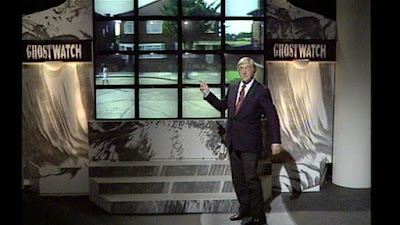
Stephen Volk’s ingenious foray into paranormal mockumentary long before anyone else thought of it. Based on the infamous Enfield haunting, Volk placed TV presenters Michael Parkinson and Sarah Greene in a fabricated outside broadcast allegedly coming by live transmission from a suburban cul-de-sac, where a young family are in the grip of supernatural evil. It literally terrified the nation.
17. MR LOVEDAY’S LITTLE OUTING (2006)
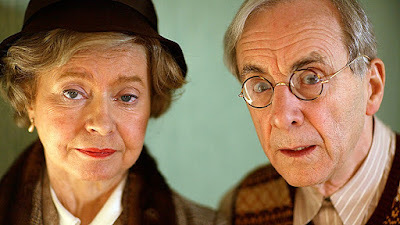
An ensemble cast partly perform and partly narrate this neat adaptation of one of Evelyn Waugh’s few horror stories. The genteel author originally intended this as a slice of dark, satirical humour, but it’s actually pretty grim. It tells the tale of an insane murderer and the ghastly thing he does when a naive socialite engineers his release from the asylum where he’s been held for 35 years.
18. THE LANDLADY – TALES OF THE UNEXPECTED (1979)
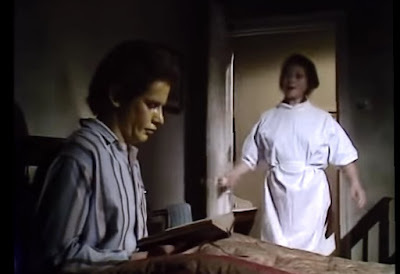
By far one of Roald Dahl’s nastiest and most unnerving horror stories. It’s little wonder that, before it was adapted for TV, it was a mainstay of Pan Horror type anthologies. It concerns a travelling man, who arrives at a small guest house, which initially seems ideal, but from where no guest has ever re-emerged alive. A bit of a one-trick idea, but genuinely horrible.
19. THE TWO FACES OF EVIL – HAMMER HOUSE OF HORROR (1980)
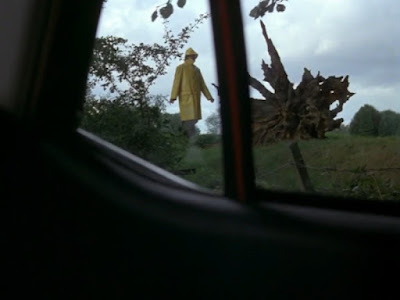
Another high point in the unfortunately uneven Hammer House of Horror series. In this one, a nice family out on a road trip offer a lift to a mysterious hooded hitchhiker, only to find themselves at the mercy of an evil doppelganger. Ultimately, it doesn’t make a lot of sense, but it’s bone-chilling all the same, and it ends with a truly memorable denouement.
20. COUNT DRACULA (1977)
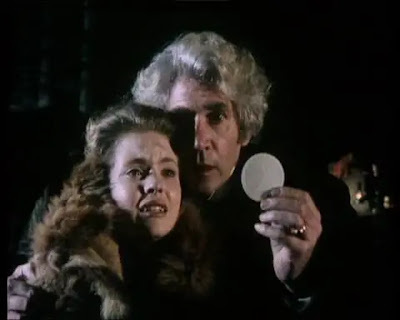
Louis Jourdan and Frank Finlay as the Count and Van Helsing respectively are the heart and soul of this very faithful adaptation of the novel, which is probably more of an heir to the Hammer style than anything committed to celluloid since. Lots of blood, but also lots of sex. Dracula is a lover as well as a monster in this version, which makes him a far more interesting character in his own right.
THRILLERS, CHILLERS, SHOCKERS AND KILLERS …
An ongoing series of reviews of dark fiction (crime, thriller, horror and sci-fi) – both old and new – that I have recently read and enjoyed. I’ll endeavour to keep the SPOILERS to a minimum; there will certainly be no given-away denouements or exposed twists-in-the-tail, but by the definition of the word ‘review’, I’m going to be talking about these books in more than just thumbnail detail, extolling the aspects that I particularly enjoyed (I’ll outline the plot first, and follow it with my opinions) … so I guess if you’d rather not know anything at all about these pieces of work in advance of reading them yourself, then these particular posts will not be your thing.
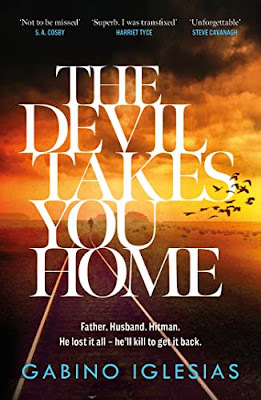 THE DEVIL TAKES YOU HOME
by Gabino Iglesias (2022)
THE DEVIL TAKES YOU HOME
by Gabino Iglesias (2022)Outline
Life is a massive struggle for Mario, a native Texan of Puerto Rican descent. After a tough upbringing at the skirts of a drug addict mother, he started out with huge disadvantages, but never had much luck as an adult either, or much cash. But then the two true lights in his life are put out. When his beautiful young daughter, Anita, dies from an unusually deadly strain of leukaemia, his wife, Melisa, whom he loves dearly, goes into her shell, turning hostile to Mario, openly calling him a loser and a waste of space, and basically blaming him for all their misfortune, before abruptly leaving him.
Mario is plunged to horrendous depths by this, because in truth he’s already gone out of his way for his family. Having lost his minimal wage job through his constant attendance at the hospital, he eventually resorted to crime to pay Anita’s medical bills, his old mate, a methhead-turned-dealer called Brian securing him work as a small-time hitman. Mario, who’s essentially a moral guy, didn’t want to do it at first, but eventually convinced himself that the people he was killing were also underworld figures, who didn’t really deserve to live.
Ultimately of course, it was all for nothing, because he never earned enough to help his ailing daughter, and now it’s too late. Mario is thus a husk of a man when Brian comes calling again, this time with the offer of a high-paying job. It seems that just over the border, in Mexico, a certain Don Vasquez, a lesser crime lord overall but someone of great ambition, is looking to hire three freelance gunmen to hit a cash delivery for the Sinaloa Cartel. If it’s pulled off successfully, there’ll be huge rewards for all involved.
Brian is certainly taking the deal, along with Juanca, a superstitious ex-Cartel member with a long history of violence. At first, Mario is indifferent, unconcerned what happens to him. But then he begins to figure that with 200 large in his pocket, he might be able to entice Melisa back. Of course, they’ll be taking a staggeringly high risk. The Sinaloans are the kings of crime and vengeance in Mexico, and even beyond those borders. So, the robbers are told they’re going to need ‘special protection’. Again, Mario is okay with this, even if a bit baffled by what it actually means. He just wants to get the job done, reunite with Melisa and disappear.
But he has no comprehension of the Hell he is descending into.
To start with, Don Vasquez has well-earned his sinister reputation. His business partner, maybe his actual partner, is Gloria, a bruja, or witch, and it’s through her auspices that they will be ‘protected’, but they first must endure a series of diabolical, blood-soaked rituals, during which both the innocent and the not so innocent are horrifically tortured and mutilated.
Again, Mario seeks to excuse his presence in this company. The Cartel are the bad guys, so they deserve to be punished. He’s only doing this because he has no choice. All his life, he and his fellow brown-skinned folk have got the short end of the stick, so why should they worry about breaking a few rules themselves? But in truth, he’s starting to have doubts. Not just about himself, but about his co-bandits.
Juanca, it seems, is capable of murderous acts at the drop of a hat, and is mainly in this to get even with his former employers, on whose orders his brother was chopped to pieces while still alive (photographs of which atrocity, Juanca keeps in his car). Even Brian, most of the time a happy-go-lucky junky, continues to give away clues that he’s planning to acquire Mario’s wedge of the pay-off as well as his own. And all this time, they’re in possession of an eviscerated corpse, which they’re under orders to use in some way as a kind of weapon. Even Brian is bemused by this, continually asking what they’ve got it for, Juanca becoming increasingly irate the more often the subject is raised.
And of course, at the end of all this, if they even make it to the proposed ambush site, they’ve got to take on the Sinaloa Cartel, some of whose most experienced sicarios will be guarding the cash truck …
Review
The first thing to say about The Devil Takes You Home is that it’s not your regular crime thriller. It’s not even your regular dope wars actioner. It is full of action, and it is set within the milieu of the dope wars. But it cuts much deeper than any of that.
One of the key subtexts Gabino Iglesias analyses here is evil. Evil as the utter absence of human morality, a vacuum of destructive chaos, and evil as an actual sentient force complete with demons and otherworldly monstrosities. And maybe evil as a combination of both, the pair of them cross-fertilising each other.
All through this book, our hero, Mario, who has been driven to the absolute end of his emotional tether, internalises and attempts to rationalise the acts of evil that he himself is either committing or standing by and allowing to happen. We hear much about the racism and prejudice that his people have been subjected to for so many generations. We are thoroughly persuaded that even by the standard of other modern day slums, life in the barrio is unlike any other form of existence. It’s cheap, it’s anonymous, no one on the outside cares about it. Mario is an American citizen, but he hails from a forgotten world where even basic necessities are hard to come by, and which most of the rest of the US does not want to know about, if it’s even aware that it exists.
All of these realities are given to us again and again as reasons for the unfolding nightmare in The Devil Takes You Home , and they are viable in that context. It’s no surprise that in Mario’s world, where there are so few indications that ‘the system’ accepted by the rest of western civilisation actually works, the gun rules and the gang member is king. But, you know, I’m not convinced that even Mario believes it 100%. This is a guy who was raised in the Christian tradition. Even now, he has much to do with saints and prayer. He is severely damaged, that much is evident, his constant failures often wrought on him by powers beyond his control, and then the untimely death of his daughter have all helped reduce him to a shadow of the man he could have been. But he still has a moral core, and he knows that all this is wrong, and deep down, he is shocked at how far he has somehow strayed from the path of the righteous.
In addition to all this, as I’ve already hinted, Gabino Iglesias contemplates evil as the work of an actual dark power, and this is the part that really separates The Devil Takes You Home from other crime thrillers of its ilk, because not only is it filled with scenes of horrific violence, it also contains visions, phantasms, witches, satanic practises and yes, even demons.
Whether that proves to be a problem for the reader is really up to them. It certainly breaks from crime fiction tradition, overlapping very comfortably into the world of horror. Personally, I like both, and combinations thereof are even better, so it worked excellently for me. But prospective buyers should be warned: much horror is also to be found in the graphic descriptions of underworld brutality. And this goes way past the average shoot-’em-up. We’re talking Don Winslow and The Cartel territory here: children systematically dismembered, adults disembowelled by crocodiles, merciless beatings that seem to go on for ages. And all the way through, the terrible looming menace of the Cartel, who are infamous for exercising vengeance the way a child would if granted absolute power, inflicting as much pain, fear and horror on their foes as they possibly can.
This is a real devil’s brew of a book (pun intended) in that regard, and again, it’s up to the individual reader how much he or she can take. Put it this way: I can take a lot, but I squirmed with discomfort on certain occasions.
But, how does it hold together as a novel? Is it more than the sum of all these grotesque parts?
Of all the books I’ve read, the one The Devil Takes You Home reminded me of most was Cormac McCarthy’s Blood Meridian , which is also set along the US/Mexico border, and involves a band of desperadoes embarking on an odyssey of crime across the sun-baked badlands at the behest of a villain of such towering evil that he must surely be devilish, none of them able to trust each other let alone their actual enemies. Of course, Blood Meridian didn’t have the fantastical elements (aside from the landscapes), but The Devil Takes You Home is very similar in that it’s a personalised journey into the ultimate heart of human darkness, and a weary attempt to understand why bad men do the things they do.
In equal similarity to that time-honoured classic, Iglesias’s novel is beautifully and concisely written. The sense of place and character are all but tangible. Your skin burns to the touch of the Texas sun. You shudder at the presence of deranged and deformed individuals who scare you just by being on the page. And if at least one purpose of this story is to contrast the visceral, in-yer-face evils of this hellish place with maybe the wider-spread, more subtle evils of the ‘civilised world’, then it succeeds on that level too.
Maybe it’s not the great American novel that Blood Meridian is proclaimed to be, but The Devil Takes You Home lives long in the memory. It’s an ideal read for horror fans, and for thriller fans too if they can accept that certain cruel acts can indeed summon the darkness, but its appeal should go way beyond that, because there is much, much more to it.
And now, as usual, here’s my attempt to pre-empt the cast of this baby, should it end up on the silver screen at some point, which it surely must do. Only a bit of fun, of course.
Mario – Pedro Pascal (who else but the man of the moment?)
Brian – Bill Skarsgård
Juanca – Eugenio Derbez
(I have a little confession to make. The image accompanying the entry for LEAVING LILY in the 20 Top TV Horror Moments section is obviously not a screen-grab from British television. It is a reproduction of STORMTROOPERS ADVANCING UNDER GAS by Otto Dix, a German painter and WW1 veteran who specialised in creating horrific portrayals of that ghastly conflict, so I felt it was a reasonable replacement. LEAVING LILY has almost no footprint on the internet at present, though I understand that a video copy of it still exists in the archive, so it might at some point be re-released).
Published on March 12, 2023 09:47
February 10, 2023
A TV slot, Heck latest and bloody battles

Something pretty exciting will be happening this evening, so I’m going to be parping on about that today, giving you all the details available. I’ll also be talking about my Heck series, and will be discussing USURPER, my first historical novel, due out in April. And to round all that off, to ensure that I’ve covered the entire spectrum of my literary interests – crime thrillers and historical adventures thus far – I’m also going to dive into the world of supernatural horror, by offering my usual detailed review of Steve Duffy’s latest collection, THE FACES AT YOUR SHOULDER.
As usual, you’ll find that review in the Thrillers, Chillers section at the lower end of today’s post. So, don’t hesitate to get down there straight away, if that’s all you’re here for.
On the other hand, if you’re interested in my work too, perhaps you might first want to check out …
Local TV
Those who follow this blog, or read my books, will already know that my most recent crime novel, NEVER SEEN AGAIN , was recently made the subject of a high-profile arts competition in the West Midlands, when the challenge was issued by the much-lauded Birmingham Art Zone to a group of local painters, requiring them each to condense and convert that 130,000-word crime thriller into a single canvas.
It was my suggestion originally, but it was still an enormous thing to ask of them.
How do you convey an entire book in one painting?
However, three of them undertook the challenge; they each creating their own interpretation of NEVER SEEN AGAIN , and last November, I, as the original author, was asked to attend a special ceremony at the Velvet Music Rooms on Broad Street, Birmingham, to select the winner.
 It was a high pressure situation, as I’m sure you can appreciate, especially given that the three artists – Helen Owen, Helen Roberts and Paula Gabb – were standing there smiling at me at the time. But it had to be done, and it was.
It was a high pressure situation, as I’m sure you can appreciate, especially given that the three artists – Helen Owen, Helen Roberts and Paula Gabb – were standing there smiling at me at the time. But it had to be done, and it was. The picture topside depicts myself and Mike Olley, Westside Bid boss, who organised this whole thing, standing with three finalist paintings, while on the right here, Lorraine Olley, Birmingham singer and media personality, presents me with the difficult choice.
For the full skinny on this story, just scroll back through these blogposts to last November, and you’ll find it all there. I do need to add though, that what even those who are regulars on here may not know is that the entire process, more or less from conception of the idea to the unveiling and judging ceremony several months later, was filmed by West Midlands TV journalist, Nick Duffy. Multiple interviews were also held, all captured on Nick’s trusty camera, and trips were even made to our home towns, to assess the inspirations behind our various artistic endeavours. The final result, a 20-minute-long documentary, called Paul Finch - Never Seen Again: A Novel Imagined Through Art , which I’ve already had the privilege of viewing, and which frankly amazed me with how well shot and edited it was, not to mention the way it managed to catch the whole of this quite dramatic event (in my life, at least) in such a brief time without leaving out a moment of tension or suspense, is a remarkable piece of TV art in its own right from Nick.
That’s the good news.
The really good news is that everyone else will now get a chance to see it too.
This evening, Friday Feb 10, at 6.15pm, a three minute and 25 second highlight programme will air on the Local TV Network with repeats across Saturday and Sunday. You will find it on Freeview 7 and Virgin 159 (Leeds TV, Yorkshire TV, North Wales TV, South Wales TV, Tees TV, Tyne TV, North East TV, Birmingham TV, West Midlands TV, Bristol TV, Cardiff TV, Liverpool TV). I’m assuming, though it seems a safe bet, that these highlights will also carry links to wherever online you can view the whole thing, should you be so inclined.
Heck latest
On a not unrelated subject, I now want to talk about some of my earlier crime novels.
 The Heck series is pretty well what put me on the thriller-writing map. I commenced penning these novels around 2012, having, prior to that, spread myself a little more widely, covering horror, sci-fi, Dr Who and so on. But the Heck novels, published by Avon at HarperCollins, which in some ways, I suppose, took the hardboiled thriller about as far as it could go in terms of gritty realism, brutal violence and uber-dark subject matter (if I do say so myself), became a big success for me.
The Heck series is pretty well what put me on the thriller-writing map. I commenced penning these novels around 2012, having, prior to that, spread myself a little more widely, covering horror, sci-fi, Dr Who and so on. But the Heck novels, published by Avon at HarperCollins, which in some ways, I suppose, took the hardboiled thriller about as far as it could go in terms of gritty realism, brutal violence and uber-dark subject matter (if I do say so myself), became a big success for me. I’m continually asked by fans whether or not the series will continue, as with the seventh Heck book, KISS OF DEATH , I left them all on something of a cliff-hanger.
Well, in answer to that, I firstly should apologise. It wasn’t my intention to let this huge period of time intervene in the series, but the end of Heck 7 coincided with a change of publisher and with the Covid outbreak, both of which contrived to send my writing schedule haywire. Even at the time, I didn’t just write Heck; I had many other fictional irons in the fire, which I wanted to get out there. So, it all ended up being a bit of a muddle.
But I can guarantee for any fans reading this that Heck is very far from finished. Since the last book was published in 2018, I’ve written two more Mark Heckenburg novels, picking up directly from where the last one ended. When people ask – and that seems to happen, even now, at a rate of about three and four times a day, I can only reply that publishing these novels is not within my control (unless I opt to publish them myself, of course); it’s down to whoever my publisher happens to be at the time, and many of them have their own schedule chaos to contend with, even now, a couple of years after Covid ‘ended’.
So, it’s not at all straightforward, but I reiterate to all the Heck readers that, whatever happens, however beyond my control it may seem to be at present, I absolutely and firmly assure you that the Heck series has NOT finished. More Heck novels are already written and just waiting to be published, and more are forthcoming. I just beg you all to be patient a little bit longer.
And now let’s go way back into the …
 Mists of time
Mists of timeIt’s been both a fascinating and a harrowing experience writing my new historical adventure novel, USURPER , BOOK ONE OF THE WULFBURY CHRONICLES , which will be published by Canelo on April 27 this year.
I can say this safely now, because I’ve put the final touches to it, and it’s left my desk never to return.
The reason I say ‘harrowing’ is because it’s very much new territory for me. I like to think that I know the Middle Ages, particularly the early Middle Ages, very well. I studied it at degree level, and I’ve been obsessed with historical adventure literature all my life. But finally put pen to paper and writing one of my own was a very new experience and a challenge.
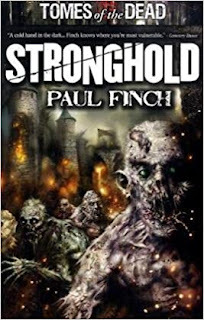 (I have written in the pre-mechanised era before, long ago now, when I wrote
STRONGHOLD
and
DARK NORTH
, but if you follow those links, you’ll see that they were fantasy novels rather than actual history).
(I have written in the pre-mechanised era before, long ago now, when I wrote
STRONGHOLD
and
DARK NORTH
, but if you follow those links, you’ll see that they were fantasy novels rather than actual history). With USURPER , there were so many more details I had to take care of than I was used to, so much more research to carry out. And when it came to the actual writing, it was vital, I felt, to pace it correctly. Now, you may think that for a professional author, that ability ought to be baked in, and or course, whether you’re writing about the 21st century or the 11th, it shouldn’t make a lot of difference. You don’t want to bog your readers down with extraneous material. You want to keep them hooked. You want the narrative to keep bouncing along. But there are things you simply must take into account, if for no other reason than authenticity. The pace of life was slower then, long-range communications were almost nonexistent, educated folk were few and far between, it was an age of unquestioning faith and acceptance of status (or lack of it). What did all this mean for the progress of the plot, for the dialogue, for intellectual discourse between characters, even for the way individuals thought when going about their everyday business?
As I say, a challenge. And only you guys, the readers, will be able to judge whether I rose to it or not.
In the meantime, I’m happy to report that the final proof-read is done – again, it’s something very new in my writing experience, having to deal, not just with Latin, but with Ancient Greek as well! – and the book has now gone into production, complete with its snazzy new cover and some amazing quotes from some very esteemed historical fiction writers, all of whom have been fulsome in their praise.
The next time we see it, it will be for sale, which is not a nerve-wracking thought at all, is it?
THRILLERS, CHILLERS, SHOCKERS AND KILLERS …
An ongoing series of reviews of dark fiction (crime, thriller, horror and sci-fi) – both old and new – that I have recently read and enjoyed. I’ll endeavour to keep the SPOILERS to a minimum; there will certainly be no given-away denouements or exposed twists-in-the-tail, but by the definition of the word ‘review’, I’m going to be talking about these books in more than just thumbnail detail, extolling the aspects that I particularly enjoyed … so I guess if you’d rather not know anything at all about these pieces of work in advance of reading them yourself, then these particular posts will not be your thing.
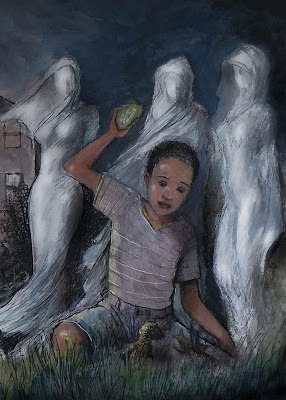 THE FACES AT YOUR SHOULDER
THE FACES AT YOUR SHOULDER
by Steve Duffy (2023)
Okay, I’m going to say it out loud: Steve Duffy is one of the very best purveyors of ghost and horror fiction working in the English language today. The fact that he is criminally under-published in the wider mass-market is the mass-market’s own fault, and it’s a big one. Those who specialise in reading supernatural fiction will of course know about him already, as his short stories and novellas have appeared prolifically in numerous magazines and anthologies for the best part of the last 30 years, but the wider reading public don’t and that is definitely their loss.
It may be partly through Duffy’s own choice that he hasn’t yet conquered the literary world. He clearly prefers to work in the short form, and we all know the disdain that so many of the big publishing houses hold for that. But I still consider it a tragedy that works as exquisitely penned as these are denied to so many readers of spooky (or even wider mainstream) fiction, not least because in some of even his shortest stories, the ideas behind then are mind-blowingly massive. At least Duffy now seems to have found a reliable and high-quality home at Sarob Press, who to date have published two of his six short story collections, this one, The Faces at Your Shoulder being the second.
Before I say anything else, I’ll let Sarob introduce this one themselves, with their own promotional blurb:
Where are the monsters? Sometimes they’re right behind you.
In this new collection of six novelettes – three are wholly original to this volume – Steve Duffy invites us to look over our shoulders, and asks us whether we recognise the faces that we see. Some of them are all too human, some are animals, and some are like nothing we’ve ever seen – yet.
In the snowy wastes of the Yukon and the mining country of Appalachia an age-old terror is unwittingly unleashed…
After-hours at the Pacific View diner, meet a glamorous, mysterious film star and uncover a monstrous bargain…
In Streatham or in Ethiopia, you must be careful what you wish for – very careful – or anything might happen…
Christmas is a time for family, and that means dark secrets, desperate desires and occult constructs…
Down at the zoo something is stirring: the animals know, but the warders won’t realise until it’s already too late…
Young love blossoms at the New York World’s Fair, but the future has its own agenda…
Steve Duffy’s subject-matter of choice is eclectic to say the least. He writes accessibly and entertainingly in almost any environment, the backgrounds in this collection alone ranging from a drab suburban zoo in present-day Britain to Hollywood in the age of the casting couch and gangland moll. In days gone by, he was a master of the Jamesian school of ghost story, both in terms of period and place, though at the same time he produced socially cutting tales of modern-day anguish and urban society gone mad, many of our contemporary ills wrapped up as unique kinds of monsters or revenants. Quite often, he likes to invoke a prosaic atmosphere, but this is invariably to lull his readers into a false sense of security, because one thing you also always get with Mr Duffy is a big supernatural twist, though it will never be something obvious.
The Faces at Your Shoulder , which contains three original pieces alongside three cherry-picked reprints, is a perfect case in point. If anything, this book has a distinctly 20th century American flavour, but the menace flowing through it, which, though it’s always so clever that you never see it coming (even if it several times hints at Armageddon!), arrives in a wide variety of shapes and forms, few of which you’ll have encountered before.
Anyway, enough of my hyperbole. As The Faces at Your Shoulder contains only six stories (all fairly lengthy), I won’t do what I usually do with collections, which is select the tales I liked the best and talk about them in extra detail. Instead, I’ll run through them all in chronological order. And as I always enjoy doing some fantasy casting at the end, I’ll do the same here, only will invent a TV series adaptation and pick out a few actors for each episode (all in the spirit of having a laugh of course – I only wish it wasn’t, though with the casts I choose, I’d be pushing my luck even at mega-budget).
Now, time to let the stories do the talking:
The Oram County Whoosit
Virginia of the 1920s. When two journalists are assigned to write about a strange and frightening creature found in a coal mine, they think it just another hoax. After all, this is the golden age of huckster sideshow folk. However, this may be different. The older guy in particular is a little concerned, wondering why the find reminds him of a terrifying experience he had back during the days of the Gold Rush …
A much anthologised slice of ‘HP Lovecraft meets Jack London’, strong characters, an atmospheric backdrop and the author having great fun in a geographic realm where he’s rarely ventured before.
In our imaginary TV show:
Fenwick – Nicholas Hoult
Keith – Tommy Lee Jones
The Soul is a Bird
A dying pensioner relates an incredible tale to his nephew, how, way back in 1933, he offered sanctuary to a famous and beautiful movie star seemingly in trouble with the mob, only to hear that it wasn’t money she owed, but her soul, and that after seven years of fame and fortune, a very dark power was calling in the debt …
The first of the trio of original stories, a 20th century Faustian pact at the heart of the Hollywood dream, some convincingly devilish villains and a grand finale straight out of Weird Tales …
In our imaginary TV show:
Norm – Miles Teller
Alice – DeWanda Wise
Eira Lure – Margot Robbie
In the Days Before the Monsters
When a mystical stone falls from the prehistoric sky, it grants free wishes to all those who come in contact with it. In due course, venerated as something celestial, it is kept in an ark in deepest Abyssinia, only to pass eventually into the hands of bandits, then to an international thief, and finally to London, where a youngster who thinks only of dinosaurs gets his hands upon it …
Probably the first ever Steve Duffy tale in which monsters literally abound. Strong hints of Indiana Jones and even Dr Who of the 1970s, and even though it’s done partly with tongue in cheek, the cosmic concept at the heart of it is so convincingly presented, and the setting so ‘everyday’, that it’s really quite unnerving.
In our imaginary TV show:
Ajani – Alexander Siddig
Henry – Djimon Honsou
The Psychomenteum
The Christmas of 1944 is ruined when Baltimore kids, Grayson and Chuck, and their henpecked dad are forced by their strong-willed mom to take a road-trip to Alabama, specifically to visit the remnants of her once aristocratic southern family in their faded palatial home. The reason: mom is convinced something bad has happened to her brother in the Pacific, and for reasons she won’t explain, feels certain that only back home can they make contact with him …
The most Gothic story in the novel, but also the most psychologically twisted in terms of several of its characters. For all the intensity of the genuinely bone-chilling supernatural undercurrent, it’s the level of human corruption on show here that makes the lasting impact.
In our imaginary TV show:
Mom – Jessica Biel
The Lion’s Den
A zookeeper relates the baffling events leading up to the closure of the zoo where he worked, and how it all started with a visitor, behaving like a madman as he climbed into the lions’ enclosure, stripped naked and lectured the angry beasts in a language no one understood, and then vanished. And how afterwards, the animals, seemingly now with minds of their own, set about dismantling of all the park’s safety and security procedures …
Probably the most startling concept in the entire collection, again superbly grafted onto a deceptively mundane scenario. It’s a slow-burn idea, but as it unfolds you’ll literally be gobsmacked at its potential ramifications.
In our imaginary TV show:
The Keeper – Kris Marshall
Futureboro
New York, the late 1930s. Young Zack lands a job at the World’s Fair as a spotter at ‘Futureboro’, the city of the future. However, bizarre acts of vandalism, violence and political extremism start marring the miniaturised cityscape, seemingly reflecting events in Europe. Henny, a Jewish engineer on the project, is concerned that it’s linked to Yoyodyne, who built Futureboro, but who are also developing a hi-tech bomb-delivery system, which they shortly expect to make them very rich …
The most cerebral tale in the book closes out proceedings. The main horror here stems from the hindsight we all now share about the outcome of political zealotry in the first half of the 20th century, but it’s such a well-told tale, so subtle and sophisticated in terms of its conception and execution, that its appeal reaches far beyond the world of the scary story.
In our imaginary TV show:
Zack – Alex Wolff
Henny – Michael Shannon
Okay, that’s The Faces at Your Shoulder , the sixth collection to date from an author whose appeal lies not just in his writing style, which, despite being tight as a corkscrew, nearly always feels fulsome in the best sort of way, but in his concepts, which – and this is especially on show here – travel far beyond the normal conventions of horror fiction, even though they are horrific and scary in every sense of those terms!
Why not check his work out and see for yourself?
Published on February 10, 2023 06:11
December 12, 2022
The one who got away returns with steel
 I’m delighted today to unveil the new cover and title to my first medieval action-epic. As you can see, it’s called USURPER, and it will be the first book in a new duology, THE WULFBURY CHRONICLES. More about that shortly.
I’m delighted today to unveil the new cover and title to my first medieval action-epic. As you can see, it’s called USURPER, and it will be the first book in a new duology, THE WULFBURY CHRONICLES. More about that shortly. In addition today, seeing as it’s now getting really cold and dark out there, I’ll be reviewing a very wintry horror novel, TERMINAL FREEZE by Lincoln Child. Bit of an eco-horror, this one, but containing elements of Alien and The Thing, and quite appropriate for our current concerns, I feel.
If you’re only interested in reading the Lincoln Child review, rocket on down to the lower end of today’s post, namely the Thrillers, Chillers section, where all my reviews can usually be found. Before then though, let’s roll back the clock a thousand years to …
A darker age
USURPER will be my first novel for Canelo Books (it’s published on April 27, but already available for pre-order) and though it represents a right-turn on my normal subject-matter, I can guarantee you an all-out, full-blooded action adventure.
The story takes place in that most infamous year in British history, 1066. It’s the late summer, and Saxon England, one of the oldest, wealthiest kingdoms in Christendom, has now been at peace for five decades. Everyone is enjoying the prosperity of these days. The earls and their thegns feast together in their great halls, while the peasants partake in a plethora of village festivals running right through the calendar. After decades of successful harvests, famine in England is unknown. The woods teem with game, the rivers and meres with fish, and there are no restrictive laws to prevent anyone helping themselves to Nature’s bounty. Even the Viking threat to England appears to have diminished dramatically.
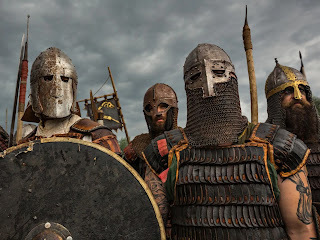 And then, seemingly from nowhere, all within one tumultuous month, the good times end.
And then, seemingly from nowhere, all within one tumultuous month, the good times end.The kingdom is subjected to two different but simultaneous incursions by enemies almost too terrible to imagine. In the north, a new and colossal horde of Vikings arrives under the leadership of the notoriously violent and cruel Harald ‘Hardraada’ Sigurdsson, King of Norway, while the south is invaded by William, Duke of Normandy, the bulk of whose enormous army now comprises a new and elite military force, a corps of mounted warriors who are well-armed, well-trained and whose proficiency with weapons is matched only by their loyalty to their overlord; the world will come to know them as ‘knights’, and their efficiency on the battlefield will transform the European way of making war for many centuries to come.
In the face of these implacable foes, and during the course of three near-apocalyptic battles, Saxon England falls.
Yes, it’s a well-known saga, but in USURPER I don’t follow it blow-by-blow. Instead, I focus on the experience of one person, Cerdic of Wulfbury, second son of a fictional Saxon nobleman and a young scholar who, as 1066 approached, was destined for the Church, but who, once the catastrophe breaks over his people, taking away from him everything and everyone he has ever known and loved, finally starts to think that maybe the sword is mightier than the pen after all …
Time for a change
Readers of my crime novels don’t need to worry. I’ve not called time on them, but every so often a change is pleasant, plus it’s nice to have more than one string to your bow.
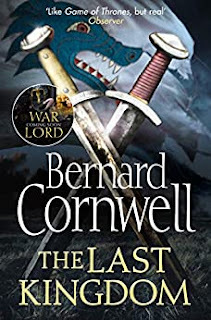 I started writing
USURPER
speculatively a couple of years ago, having become a big fan of historical adventure writers like Bernard Cornwell, Ben Kane, Simon Scarrow, Angus Donald, Conn Iggulden, David Gilman, Matthew Harffy, Giles Kristian etc. I studied medieval history as part of my degree, and so I’ve been fascinated by that period all my life. An era that so many of us think we know because we’ve seen umpteen Hollywood versions of it was actually even more magical and mysterious in reality, as well as being a lot more brutal and turbulent. But for all these reasons, the scope for fictional adventures set during the pre-mechanised era of human history is limitless.
I started writing
USURPER
speculatively a couple of years ago, having become a big fan of historical adventure writers like Bernard Cornwell, Ben Kane, Simon Scarrow, Angus Donald, Conn Iggulden, David Gilman, Matthew Harffy, Giles Kristian etc. I studied medieval history as part of my degree, and so I’ve been fascinated by that period all my life. An era that so many of us think we know because we’ve seen umpteen Hollywood versions of it was actually even more magical and mysterious in reality, as well as being a lot more brutal and turbulent. But for all these reasons, the scope for fictional adventures set during the pre-mechanised era of human history is limitless. Think of the reasons why the Western was such a successful hunting ground for so many authors and film-makers over so many decades. Consider the romantic potential of a society stripped down to its basics, where much of the land is wilderness, where men and women can only survive through a combination of ingenuity and back-breaking toil, where the forces of chaos can run riot because law-enforcement is so thinly spread, where justice can often only be served one-to-one, and only by those who are sufficiently heroic to do it.
Well, you’ve got exactly the same scenario in Europe during the Middle Ages and Dark Ages. In addition, you have very dramatic historical events and amazing real-life characters that you can weave into your fiction to add colour, depth, context, authenticity and so on.
It was an intoxicating prospect that I knew I’d have to chance at some point, and I can only reiterate how glad I am that the book found favour with Canelo and will now be published on April 27 next year, though let me offer another quick reminder that it is already available for pre-order (just go HERE ).
As I say, fans of my thriller fiction needn’t fear. That side of the Finch operation hasn’t ended. Far from it (watch out for new titles in 2023). But from now on, I’ll be writing historical adventures too, commencing with this duology, USURPER .
THRILLERS, CHILLERS, SHOCKERS AND KILLERS …
An ongoing series of reviews of dark fiction (crime, thriller, horror and sci-fi) – both old and new – that I have recently read and enjoyed. I’ll endeavour to keep the SPOILERS to a minimum; there will certainly be no given-away denouements or exposed twists-in-the-tail, but by the definition of the word ‘review’, I’m going to be talking about these books in more than just thumbnail detail, extolling the aspects that I particularly enjoyed (I’ll outline the plot first, and follow it with my opinions) … so I guess if you’d rather not know anything at all about these pieces of work in advance of reading them yourself, then these particular posts will not be your thing.
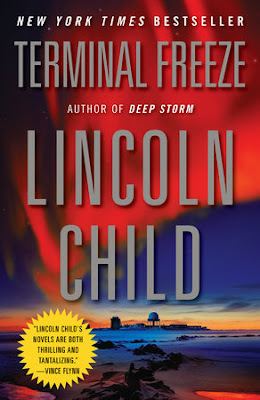 TERMINAL FREEZE
by Lincoln Child (2009)
TERMINAL FREEZE
by Lincoln Child (2009)
Outline
In the high Alaskan Arctic, the foothills to the ominously named Mount Fear play host to Fear Base, an old military installation, once a listening post during the Cold War, currently disused except for a skeleton crew of four US soldiers. That is the normal state of play, though things are a little livelier at present as a team of scientists from the University of Northern Massachusetts is staying on site while researching the effects of global warming on the nearby glaciers.
The research team’s leader is climatologist Gerard Sully, but its strongest two personalities are paleocologist Evan Marshall and British computer scientist Penny Barbour. Despite this wealth of experience, not everyone is happy. The scientific expedition, which was bankrolled by National Geographic-type TV channel Terra Prime and their parent corporation, Blackpool Entertainment, is making slow progress in terms of discoveries, and there are disputes aplenty. And then, suddenly, while exploring a lava tube filled with ancient ice, the scientists uncover the body of a gigantic animal frozen beneath the surface.
At first there is confusion about what exactly the creature is. From its terrible eyes and teeth, it is clearly a predator, possibly a smilodon (‘sabre-tooth tiger’ to you and me), but if so, at sixteen feet in length, it’s the largest ever known. The condition of its perfect preservation is also a source of wonder and bemusement.
The team is delighted, feeling they might get something out of this expedition after all. However, when word is sent back to Terra Prime, the channel immediately despatches a film crew to Fear Base, where they plan to cut the discovery free and thaw it out on live television. Despite the scientists’ advice that, as they know nothing about the animal, it should be studied in situ first, the channel orders them to assist the newly-arrived crew, predicting that this will be a blockbuster event that will shoot them to the top of the ratings.
As such, they don’t just send cameramen and roustabouts, but talented line producer Kari Ekberg, network liaison and senior channel rep,Wolff, and the obnoxious and obsessive film director, Emilio Conti, who sees ‘his cat’ as a belated opportunity to put some shine on an otherwise non-too-illustrious career. The show will be presented by the spoiled and beautiful TV anchor, Ashleigh Davis, whose luxurious trailer is brought to the base by doughty ice road trucker, Carradine. Another new-arrival is Jeremy Logan, a historian from Yale, who is keen to look the base over and investigate the mystery of why a bunch of scientists were inexplicably killed there back in 1958.
Regular Lincoln Child readers will know Logan of old, recognising him as an intrepid investigator of dangerous paranormal phenomena. Though he isn’t close to being the lead character here, Terminal Freeze is his second outing to date (several others have been written since).
If the scientists at Fear Base aren’t already worried enough that the plan to thaw out the giant cat is a bad one, the Tunits, the few survivors of an all-but-extinct Alaskan tribe, arrive at the base under the leadership of medicine-man, Usuguk, and try to explain that the ancient creature was the mountain’s demonic guardian, that it is not fully dead, and that, once unleashed, it will kill and kill until all transgressors have been destroyed.
Meanwhile, Marshall and his team have worries of their own. From what they are able to see through the cloudy ice, they deduce that this is not a smilodon, but a prehistoric creature existing outside of science. Despite that, it was clearly an extreme predator, something dwelling at the very top of the food-chain. The animal is therefore priceless, and they are convinced it should be left where it is while more prudent research is done.
However, Wolff pulls rank. Terra Prime will have their live TV extravaganza at any cost. While the irritating Conti takes charge, adopting a melodramatic but painfully unscientific approach, Marshall and co are forced to stand by and watch as the animal is cut free in a hefty block of ice and placed in one of the base’s refrigerated vaults.
Perhaps inevitably, this doesn’t protect it enough. Because a short time later, long before any cameras start to roll, the vault is found to be empty, the huge block of ice clearly having melted – which is a mystery in itself – while the preserved carcass is missing, the thieves having entered through a large hole cut in the floor.
Acrimony and accusations fly, the scientists coming under deep suspicion. Until someone points out that the damage to the vault floor was not done from the outside, but the inside. And that no power-tools were used. If anything, the metal panels were ripped apart by what appears to have been claws and teeth.
It isn’t long after this when the horrific killings begin …
Review
There can’t be many of us who don’t enjoy a good ‘creature feature’ set at the ends of the Earth. Because that is firmly the territory we are in with Terminal Freeze . If you’ve read the outline, you won’t need me to liken it to several icebound monster classics of the past. From HP Lovecraft’s At the Mountains of Madness to John W Campbell’s Who Goes There? , from Dan Simmons’s The Terror to Robert Banks Stewart’s Dr Who masterpiece, The Seeds of Doom , all the familiar tropes are present: the isolated station deep in the polar region, manned uncomfortably by a combo of scientists and military men; the terrible thing in the ice; the unwise decision to bring it back to base; the pseudo-science about what it might be and where it might have originated; the string of brutal deaths as it somehow appears to have survived its billennia-long incarceration in the deep freeze and now embarks on a non-stop assault against the good guys, who invariably possess no weapon that seems to work on it.
But does any of that mean I didn’t enjoy Terminal Freeze ?
Not at all.
Okay, I can’t pretend that I didn’t have one or two issues, so perhaps it’s for the best if I deal with those straight away.
It’s a pity that we never really get to know more about the creature. It’s not a sabre-tooth tiger, it’s infinitely worse, but that’s about the extent of what we learn. Though the sense of terror it generates is real (it vibrates off the page once the hunt is on), and though it is never explicitly depicted, the creature is described sufficiently for us to understand that this is a genuine primordial horror, something that doesn’t belong in any world, let alone the modern one, and that it will cause mayhem if it ever gets back to civilisation. But all that aside – and I’m sorry if this is a bit of a spoiler (it spoiled it a little for me too!) – we never get to know exactly what the monster is.
The author talks in general terms about the ‘Callisto Effect’, an idea that, if memory serves, he and his regular writing-partner, Doug Preston, first aired in Relic , published fourteen years earlier in 1995. This is an evolutionary concept in which an area of geographical confinement may become overpopulated by certain species of fauna, the outcome being the emergence of a completely new and highly aggressive genus, a super-predator that will hunt and kill everything around it until the overpopulation problem has been resolved. This is a neat idea, I’ll admit, even if it’s entirely fictional. It gives us a scary antagonist, there is no question about that, but it doesn’t really allow us to tie up all the loose ends.
My only other brickbat concerns Usuguk, who isn’t just the wiseman of the local Native American tribe, and who’s still inexplicably here even though the vast majority of his people have migrated across the continent to an easier climate, he also happens to have been a former US soldier and even a scientist; not only that, he was involved in the 1958 incident, when the staff at Fear Base were exposed for the first time to the murderous beast in the ice (or another one very like it). Sorry, but I just found this a bit too convenient. Not, I have to add, that Usuguk is really a great help at the end of the day. Not as much as you’d think he would be.
However, these are the only issues I had with Terminal Freeze , and they didn’t do any real damage. Essentially, this book is monster horror par excellence, garnished with lashings of full-blooded action. And it works perfectly on that level. Half the personnel’s attempted flight in the ice-truck trailer doesn’t really serve any purpose, other than to add a few extra thrills (which it does!), but the increasingly frequent battles with the monster in the concrete bowels of the decommissioned base or on the tundra beyond, are convincing and enthralling, giving us more than a passing nod to major movies of this subgenre. For example, the attempt to destroy the monster with an arc of electricity comes straight out of 1951’s The Thing From Another World , while the extreme factionalism of the crew and the fact this weakens them in the face of a common enemy is fond homage to John Carpenter’s 1982 version, The Thing . But again, it’s all ripping stuff.
On top of that, Lincoln Child writes so well. The desolate landscape of glaciers and frozen crags is beautifully evoked, while the scientific analysis, even if much of it is technobabble, sounds authentic enough to keep you engrossed. The characters, while in some cases they are stock (Evan Marshall, for example, though an eco-minded scientist is also an ex spec-ops soldier, while even Child’s regular, Logan, remains an unreadable background figure) range widely enough to remain recognisable throughout the blood-soaked chaos, the villains among them adequately annoying for you to enjoy their inevitable gruesome demise. But it’s with the base itself where Child really excels himself, hitting us not with a small huddle of huts and storage sheds connected by a few primitive metal passages along which the polar wind drones endlessly, but with the brooding majesty of Fear Base, formerly a major outpost in the USA’s defensive line against the Soviet Union, and as such vast and multi-levelled, comprising warrens of tunnels, vaults and forgotten rooms crammed with relics of machinery and defunct kit, all now disused and covered with dust. It’s a depthless labyrinth in which the monster can roam unchecked without anyone even knowing it is there – which makes it all the more terrifying, of course, when they’ve got to try and track it down.
I’m not going to say a lot more about Terminal Freeze . Basically, it does what it says on the tin. It’s a sci-fi action horror, the territory familiar, but the atmosphere deeply immersive, and the thrills, when they start, coming at us relentlessly. Read any blurb and you’ll immediately know what you’re going to get. If that kind of thing floats your boat, go for it.
And now, my usual folly. I’m going to try and cast this beast in the inevitable event someone options it for movie development and then picks me to be casting director.
Evan Marshall – Ben Mendelsohn
Jeremy Logan – (assuming he does much more in a screen adaptation) Kiefer Sutherland
Kari Ekberg – Carmen Ejogo
Emilio Conti – Franco Nero
Sergeant Paul Gonzalez – Benicio del Toro
Carradine – Mahershala Ali
Gerard Sully – Brian Gleeson
Penny Barbour – Olivia Colman
Wolff – Patrick Dempsey
Ashleigh Davis – Amy Seimetz
Published on December 12, 2022 06:56



